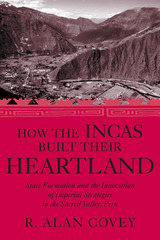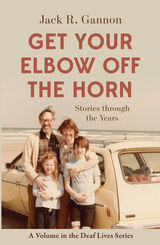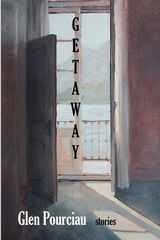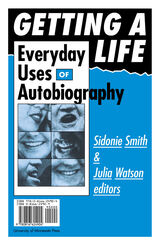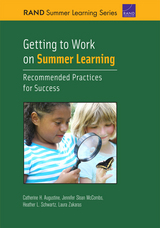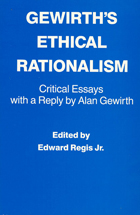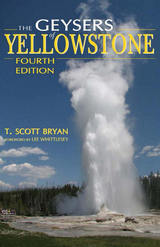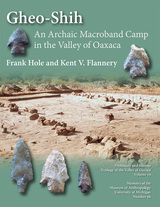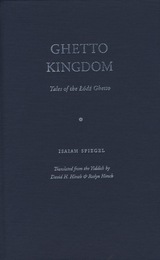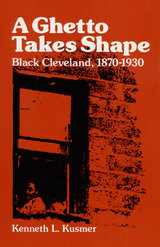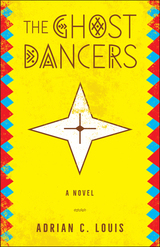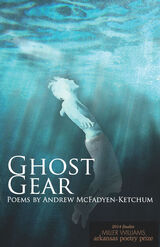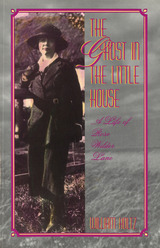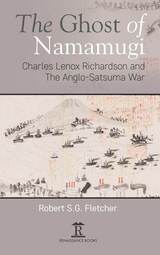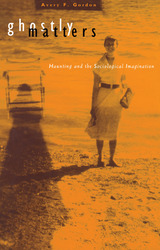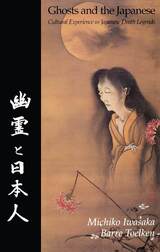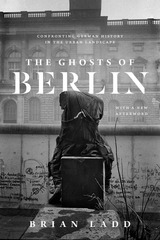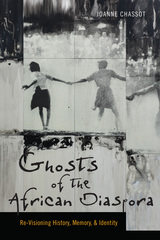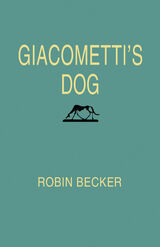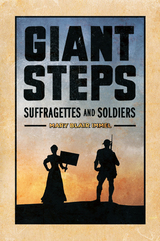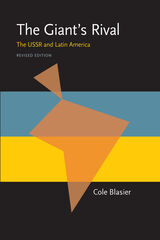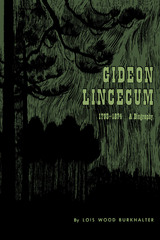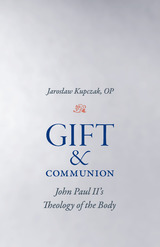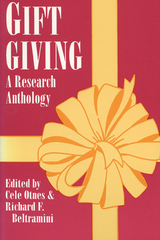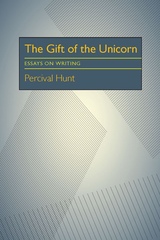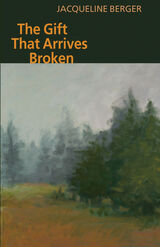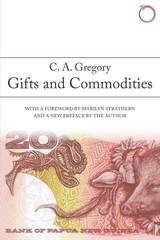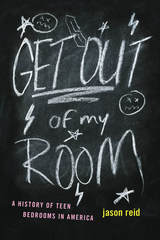 Get Out of My Room!: A History of Teen Bedrooms in America
Jason Reid
University of Chicago Press, 2016 Teenage life is tough. You’re at the mercy of parents, teachers, and siblings, all of whom insist on continuing to treat you like a kid and refuse to leave you alone. So what do you do when it all gets to be too much? You retreat to your room (and maybe slam the door).
Even in our era of Snapchat and hoverboards, bedrooms remain a key part of teenage life, one of the only areas where a teen can exert control and find some privacy. And while these separate bedrooms only became commonplace after World War II, the idea of the teen bedroom has been around for a long time. With Get Out of My Room!, Jason Reid digs into the deep historical roots of the teen bedroom and its surprising cultural power. He starts in the first half of the nineteenth century, when urban-dwelling middle-class families began to consider offering teens their own spaces in the home, and he traces that concept through subsequent decades, as social, economic, cultural, and demographic changes caused it to become more widespread. Along the way, Reid shows us how the teen bedroom, with its stuffed animals, movie posters, AM radios, and other trappings of youthful identity, reflected the growing involvement of young people in American popular culture, and also how teens and parents, in the shadow of ongoing social changes, continually negotiated the boundaries of this intensely personal space.
Richly detailed and full of surprising stories and insights, Get Out of My Room! is sure to offer insight and entertainment to anyone with wistful memories of their teenage years. (But little brothers should definitely keep out.)
 Get Plum Island!: Place and Politics in Massachusetts's Ten-Year Fight Over the Parker River National Wildlife Refuge
Karin A. Martin
University of Massachusetts Press, 2026 An environmental history of resistance, negotiation, and conservation on the Massachusetts coast
An hour north of Boston, Parker River National Wildlife Refuge occupies the southern three-quarters of Plum Island, a barrier island off the Massachusetts coast. Parker River is a nationally renowned birding destination and the second most-visited wildlife refuge in the Northeast, drawing over 300,000 visitors annually. Today, environmentally minded Massachusetts barely remembers the decade-long fight that reduced the refuge to half its original size. Get Plum Island! tells the forgotten story of how six small towns in Essex County (Newbury, West Newbury, Rowley, Ipswich, Groveland, and Georgetown) fought the establishment of the refuge in the 1940s. Through political organizing across local, state, and federal levels, the opposition nearly abolished the refuge and ultimately succeeded in making it smaller.
The conflict was deeply shaped by class, geography, and competing visions of land use. On one side were elite conservationists—sportsmen, ornithologists, and preservation advocates from Boston, Cambridge, and Newton—who envisioned a federally protected habitat. On the other side of the conflict, a group of mostly middle- and working-class men, farmers, and local hunters organized a resistance to the establishment of a refuge. Through protests, public hearings, and even aggression toward visiting federal officials, local opposition made the case that their communities had clammed, farmed, and hunted the disputed lands before there even was a United States government. They recounted a version of their history as founders of the nation that made them, in their view, entitled to the land that was given to them by the English Crown. In telling this story, Get Plum Island! reveals how ordinary citizens can challenge—and reshape—federal authority, and offers a timely case study in the politics of land, class, and conservation.
 Get Plum Island!: Place and Politics in Massachusetts's Ten-Year Fight Over the Parker River National Wildlife Refuge
Karin A. Martin
University of Massachusetts Press, 2026 An environmental history of resistance, negotiation, and conservation on the Massachusetts coast
An hour north of Boston, Parker River National Wildlife Refuge occupies the southern three-quarters of Plum Island, a barrier island off the Massachusetts coast. Parker River is a nationally renowned birding destination and the second most-visited wildlife refuge in the Northeast, drawing over 300,000 visitors annually. Today, environmentally minded Massachusetts barely remembers the decade-long fight that reduced the refuge to half its original size. Get Plum Island! tells the forgotten story of how six small towns in Essex County (Newbury, West Newbury, Rowley, Ipswich, Groveland, and Georgetown) fought the establishment of the refuge in the 1940s. Through political organizing across local, state, and federal levels, the opposition nearly abolished the refuge and ultimately succeeded in making it smaller.
The conflict was deeply shaped by class, geography, and competing visions of land use. On one side were elite conservationists—sportsmen, ornithologists, and preservation advocates from Boston, Cambridge, and Newton—who envisioned a federally protected habitat. On the other side of the conflict, a group of mostly middle- and working-class men, farmers, and local hunters organized a resistance to the establishment of a refuge. Through protests, public hearings, and even aggression toward visiting federal officials, local opposition made the case that their communities had clammed, farmed, and hunted the disputed lands before there even was a United States government. They recounted a version of their history as founders of the nation that made them, in their view, entitled to the land that was given to them by the English Crown. In telling this story, Get Plum Island! reveals how ordinary citizens can challenge—and reshape—federal authority, and offers a timely case study in the politics of land, class, and conservation.
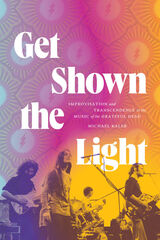 Get Shown the Light: Improvisation and Transcendence in the Music of the Grateful Dead
Michael Kaler
Duke University Press, 2023 Of all the musical developments of rock in the 1960s, one in particular fundamentally changed the music’s structure and listening experience: the incorporation of extended improvisation into live performances. While many bands—including Cream, Pink Floyd, and the Velvet Underground—stretched out their songs with improvisations, no band was more identified with the practice than the Grateful Dead. In Get Shown the Light Michael Kaler examines how the Dead’s dedication to improvisation stemmed from their belief that playing in this manner enabled them to touch upon transcendence. Drawing on band testimonials and analyses of early recordings, Kaler traces how the Dead developed an approach to playing music that they believed would facilitate their spiritual goals. He focuses on the band’s early years, the significance of their playing Ken Kesey’s Acid Test parties, and their evolving exploration of the myriad musical and spiritual possibilities that extended improvisation afforded. Kaler demonstrates that the Grateful Dead developed a radical new way of playing rock music as a means to unleash the spiritual and transformative potential of their music.
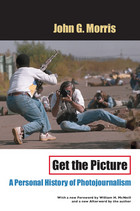 Get the Picture: A Personal History of Photojournalism
John G. Morris
University of Chicago Press, 2002 How do photojournalists get the pictures that bring us the action from the world's most dangerous places? How do picture editors decide which photos to scrap and which to feature on the front page?
Find out in Get the Picture, a personal history of fifty years of photojournalism by one of the top journalists of the twentieth century. John G. Morris brought us many of the images that defined our era, from photos of the London air raids and the D-Day landing during World War II to the assassination of Robert Kennedy. He tells us the inside stories behind dozens of famous pictures like these, which are reproduced in this book, and provides intimate and revealing portraits of the men and women who shot them, including Robert Capa, Henri Cartier-Bresson, and W. Eugene Smith. A firm believer in the power of images to educate and persuade, Morris nevertheless warns of the tremendous threats posed to photojournalists today by increasingly chaotic wars and the growing commercialism in publishing, the siren song of money that leads editors to seek pictures that sell copies rather than those that can change the way we see the world.
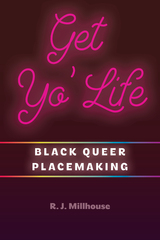 Get Yo' Life: Black Queer Placemaking
R. J. Millhouse
Ohio State University Press, 2025 In Get Yo’ Life, R. J. Millhouse incorporates gender and sexuality studies, archival work, performance studies, and urban studies to craft a historical geography of Black queer public life and culture from the 1960s onward. He does so via case studies of two Brooklyn nightclubs, Langston’s and Happiness Lounge, as patrons fought to preserve their spaces and community in the face of gentrification. Introducing Black queer spatiality as an analytic method and a type of intersectionality-driven memory work, Millhouse teases out the nuanced functions of care-work, performance, and kinship labor, along with attendant sensational, atmospheric, and nostalgic factors, as they inform Black queer placemaking practices. These practices—such as resource fairs, vogue competitions, and the appropriation of public parks as communal places—often face opposition from the police or well-to-do, mostly white, neighbors. Yet, they remain vital sites of Black queer agency. By focusing on the structural powers that condition the lives and placemaking and placekeeping strategies of Black queer people in Brooklyn, Millhouse reveals the ways in which people make and preserve place amid state-sanctioned displacement.
Get Your Elbow Off the Horn: Stories through the Years
Jack R. Gannon
Gallaudet University Press, 2020 Get Your Elbow Off the Horn is a collection of interactions and observations written by Jack R. Gannon, a lifelong advocate for the Deaf community. Warm and amusing, Gannon’s stories begin with his rural childhood in the Ozarks and continue through his experiences as a student, educator, coach, husband, parent, and community leader. These vignettes reveal a down-to-earth family man who believed in making a difference one person at a time.
Many of his recollections are brief sketches that reveal much about being Deaf—and about being human. From reflecting on the difficult choices parents must make for their children, to recounting awkward communication exchanges, Gannon marries good humor with a poignant advocacy for sign language rights. His stories preserve and share Deaf American life and culture as he experienced it.
Getaway
Glen Pourciau
Four Way Books, 2021 Although the characters in Pourciau’s stories change face, story to story they all inhabit a world dominated by interior voices revealing fragmented selves. They find difficulty making their inner worlds, with their competing narratives and emotions, fit into the world surrounding them. As they confront everyday predicaments and encounters, they are oftentimes averse to expressing their thoughts, thereby leading themselves deeper into a conflicted interior landscape.
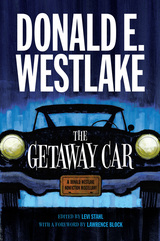 The Getaway Car: A Donald Westlake Nonfiction Miscellany
Donald E. Westlake
University of Chicago Press, 2014 “This is a book for everyone, anyone who likes mystery novels or good writing or wit and passion and intelligence.”—The New York Times
Over the course of a fifty-year career, Donald E. Westlake published nearly one hundred books, including not one but two long-running series, starring the hard-hitting Parker and the hapless John Dortmunder. In the six years since his death, Westlake’s reputation has only grown, with fans continuing to marvel at his tightly constructed plots, no-nonsense prose, and keen, even unsettling, insights into human behavior.
With The Getaway Car, we get our first glimpse of another side of Westlake the writer: what he did when he wasn’t busy making stuff up. And it’s fascinating. Setting previously published pieces, many little seen, alongside never-before-published material found in Westlake’s working files, the book offers a clear picture of the man behind the books—including his thoughts on his own work and that of his peers, mentors, and influences. The book opens with revealing (and funny) fragments from an unpublished autobiography, then goes on to offer an extended history of private eye fiction, a conversation among Westlake’s numerous pen names, letters to friends and colleagues, interviews, appreciations of fellow writers, and much, much more. There’s even a recipe for Sloth à la Dortmunder. Really.
Rounded out with a foreword by Westlake’s longtime friend Lawrence Block, The Getaway Car is a fitting capstone to a storied career and a wonderful opportunity to revel anew in the voice and sensibility of a master craftsman.
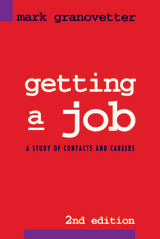 Getting a Job: A Study of Contacts and Careers
Mark Granovetter
University of Chicago Press, 1995 This classic study of how 282 men in the United States found their jobs not only proves "it's not what you know but who you know," but also demonstrates how social activity influences labor markets. Examining the link between job contacts and social structure, Granovetter recognizes networking as the crucial link between economists studies of labor mobility and more focused studies of an individual's motivation to find work.
This second edition is updated with a new Afterword and includes Granovetter's influential article "Economic Action and Social Structure: The Problems of Embeddedness."
"Who would imagine that a book with such a prosaic title as 'getting a job' could pose such provocative questions about social structure and even social policy? In a remarkably ingenious and deceptively simple analysis of data gathered from a carefully designed sample of professional, technical, and managerial employees . . . Granovetter manages to raise a number of critical issues for the economic theory of labor markets as well as for theories of social structure by exploiting the emerging 'social network' perspective."—Edward O. Laumann, American Journal of Sociology
"This short volume has much to offer readers of many disciplines. . . . Granovetter demonstrates ingenuity in his design and collection of data."—Jacob Siegel, Monthly Labor Review
"A fascinating exploration, for Granovetter's principal interest lies in utilizing sociological theory and method to ascertain the nature of the linkages through which labor market information is transmitted by 'friends and relatives.'"—Herbert Parnes, Industrial and Labor Relations Review
 Getting a Job: A Study of Contacts and Careers
Mark S. Granovetter
Harvard University Press, 1974 Getting a job, or changing from one job to another, is usually of interest only to the people directly involved. Mark Granovetter sees it differently, however, and so will his readers. He provides for the first time a detailed account and analysis of how professionals are channeled into high-level jobs. It is friends, and sometimes relatives, who provide the crucial information and contacts. This does not seem surprising in any individual case but it is often denied in the aggregate.
Granovetter also explores the nature of the relation between job-changer and his contact, and gives systematic attention to the problem of why some individuals have the "right" contacts while others do not. He traces the way job information moves from the employer who has a vacancy to the man who ultimately fills it, and discusses the factors that influence the transmission of the information. In conclusion he considers the impact of these factors on career patterns, organizational structure, and "affirmative action" programs.
Getting a Laugh and Other Essays
C.H. Grandgent
Harvard University Press Long known as a brilliant scholar and a winning interpreter of Dante’s times to our modern era, Professor Grandgent now throws aside the academic gown and settles down for unhampered conversation in the best tradition of the essay. He will get your laugh when he recounts his droll anecdotes; he will get your delighted chuckle as he pokes sly fun at pedantic scholarship or national self-importance; he will leave you at the end with a glow of pleasure that makes you for days afterward recall brilliant paragraphs and sends you back to his pages to read them once more. In fine, here are personal essays as fragrant as the bottle of vermouth that figures in one delightful incident, a treat for all lovers of good talk.
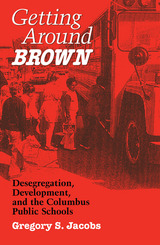 Getting around Brown: Desegregation, Development, and the Columbus Public Schools
Gregory S. Jacobs
Ohio State University Press, 1998 Getting Around Brown is both the first history of school desegregation in Columbus, Ohio, and the first case study to explore the interplay of desegregation, business, and urban development in America. Drawing on a broad range of sources, including over sixty interviews, the book details the causes and consequences of Penick v. Columbus Board of Education (1977). Gregory S. Jacobs argues that school desegregation in Columbus failed to produce equal educational opportunity, not because it was inherently detrimental to learning, but because it was incompatible with urban development. As a consequence, the long-term health of the city school district was sacrificed to preserve the growth of the city itself. The resulting middle-class abandonment of urban education in Columbus produced an increasingly poor, African-American city school system and a powerful form of defensive activism within the overwhelmingly white suburban systems. The title of the book refers not only to the elaborate tools used to circumvent the spirit of the Supreme Court’s landmark 1954 Brown v. Board of Education decision but also to the need to move beyond the flawed dichotomies and failed policies that have come to define desegregation. The book calls for a reconsideration of the complicated relationship race, class, and housing patterns have with city school reform efforts, a relationship obscured by this country’s vitriolic and occasionally violent battle over busing. Jacobs concludes his study with a “modest proposal,” in which he recommends the abolition of the Columbus Public School District, the dispersal of its students throughout surrounding suburban systems, and the creation of a choice-based “experimental education zone” within the old city school district boundaries. Readable and relevant, Getting around Brownis essential reading for scholars of recent American history, urban studies, civil rights and race relations, and educational policy, as well as anyone interested in public education and politics.
 Getting Around in Chinese: Chinese Skits for Beginners
Hilda H. Tao
University of Michigan Press, 2000 This video-and-text teaching program focuses on building the practical spoken skills of beginning students. The video, produced by the Language Resource Center at the University of Michigan, features thirty skits that cover a wide range of daily activities such as introducing yourself, inviting a friend to the movies, asking for directions, talking about your family, and shopping. The skits provide a model for students to learn and then improvise on. Each segment introduces new vocabulary and reviews grammatical structures. Excellent for improving pronunciation, tones, and listening comprehension, as well as providing an opportunity for beginning students to learn Chinese body language and gestures. The accompanying textbook includes the dialogues in English and pinyin along with character text in both simplified and traditional characters, vocabulary lists with sample sentences to clarify proper use of key expressions, and discussion questions.
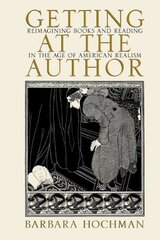 Getting at the Author: Reimagining Books and Reading in the Age of American Realism
Barbara Hochman
University of Massachusetts Press, 2009 Throughout the nineteenth century, American readers and reviewers assumed that a book revealed its author's individuality, that the experience of reading was a kind of conversation with the writer. Yet as Barbara Hochman shows in this illuminating study, the emergence of literary realism at the turn of the century called such assumptions into question. The realist aesthetic of narrative "objectivity" challenged the notion that a literary text reflects its author's personality.
But reading practices were slow to change; many resisted the effort to reconceptualize the relationship among writers, readers, and books. Even the most consistent advocates of "impartial" narration found it difficult to imagine a book without an author or to dissociate the experience of reading from the idea of a reciprocal human transaction.
In analyzing the battle over realism and the gradual shift in conventional reading practices, Hochman draws on a rich array of sources, including popular works, advertisements, and letters. She combines traditional modes of literary inquiry with methods adapted from the new historicism, cultural studies, and book history. By elucidating the realists' ambivalence about their own aesthetic criteria, she shows how a late nineteenth century conflict about reading practices reflected pressing tensions in American culture, and how that conflict shaped criteria of literary value for most of the twentieth century.
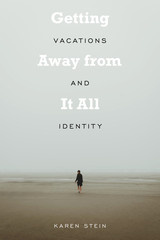 Getting Away from It All: Vacations and Identity
Karen Stein
Temple University Press, 2019 Vacations are a delimited period during which social rules and responsibilities are eased, removed, or shifted, and people have increased autonomy over what they choose to do. Recent trends in the travel industry emphasize the appeal of vacations for voluntary identity changes—when bankers can become bikers for a week or when “Momcations” allow mothers to leave their families behind. But how do our vacations allow us to shape our identity? Getting Away from It All is a study of individuality and flexibility and the intersection of self-definition and social constraint. Karen Stein interviews vacationers about their travels and down time, focusing on “identity transitions.” She shows how objects, settings, temporal environments and social interactions limit or facilitate identity shifts, and how we arrange our vacations to achieve the shifts we desire. Stein also looks at the behavior, values, attitudes, and worldview of individuals to illuminate how people engage in either identity work or identity play. Vacations say a lot about individuals. They signal class and economic standing and reveal aspirations and goals. Getting Away from It All insists that vacations are about more than just taking time off to relax and rejuvenate—they are about having some time to work on the person one wants to be.
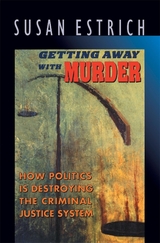 Getting Away with Murder: How Politics Is Destroying the Criminal Justice System
Susan Estrich
Harvard University Press, 1998 Justice isn't blind. It's winking. This is the message Americans get when, against the weight of overwhelming evidence, high-profile suspects go free; when there are special sentencing rules for battered wives or adult survivors of childhood abuse; when murderers are released from prison to rape and murder again, and politicians make political hay out of these cases; when lawyers look less like servants of higher values and more like profit seekers reaping fortunes by helping clients get away with murder. This book is a penetrating look into what's wrong with the American legal system, a devastating critique of how politics has corrupted criminal law in America.
Written with clarity and simplicity, Getting Away with Murder is a lesson in how the law works and a blueprint for how it should work. Susan Estrich takes on the enflamed issues, from the O. J. Simpson trial to three strikes legislation, but pushes well beyond the soundbite answers. Drawing on her background as a lawyer, political commentator, professor, and national campaign manager for Michael Dukakis, she brings academic expertise and political experience together in a way that very few people can.
In particular, Estrich argues that group-based jury nullification, like group-based abuse excuses, is precisely the wrong answer to the biases of the criminal justice system. Getting Away with Murder also views this system in the wider political arena, where fiascoes like the Willie Horton case stifle political debate and promote policies that tie the hands of judges in dealing with dangerous offenders. Lawyers do not escape Estrich's notice; she directs some of her most pointed remarks at the failure of the legal profession to tend to the ethical duties and legal values that it professes.
At a time when three quarters of black Americans believe that the criminal justice system is racist and unfair; when nearly half of all whites think it's ineffective and in decline; when crime, though falling, still tops the list of public concerns, and politicians exploit public distrust of the system to get elected, Getting Away with Murder makes a statement that is powerful, controversial, and urgently needed.
Getting Doctors to Listen: Ethics and Outcomes Data in Context
Philip J. Boyle, Editor
Georgetown University Press This book examines why physicians are often surprisingly reluctant to follow guidelines for treating patients based on research data. It assesses the merits of these concerns—which include worries about legal liability, financial incentives, the scientific validity of the data, and the objectivity of the issuer of the guidelines. It also proposes ways of developing more useful data and more effective guidelines that would reduce their objections.
 Getting Good Government: Capacity Building in the Public Sectors of Developing Countries
Merilee S. Grindle
Harvard University Press, 1997 The creation and preservation of capable states is a lengthy, laborious, and multifaceted process, fraught with opportunities for failure and misspent resources. It requires time, commitment, innovative ideas, consensus building, new rules of the game, efficient design and resource allocation in technical assistance, and considerable good luck. By the mid-1990s, the imperative to improve government performance had been added to the development agenda precisely because of greater awareness that neither markets nor democracies could function well--or perhaps function at all--unless governments' efficiency, effectiveness, and responsiveness are improved.
This publication seeks to help understand how governments can be encouraged to perform better and how state capabilities can be developed in ways that allow markets and democracies to flourish. The contributors draw comparative lessons from specific efforts designed to enhance human resource development in the public sector, to strengthen organizations that contribute to the public purpose of government, and to reform the institutions that set the rules for economic and political interaction.
Getting Good Government will be of interest not only to public officials and public management and policy analysts, but also to political scientists and international development specialists.
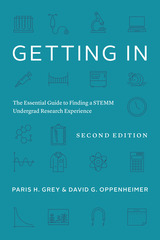 Getting In: The Essential Guide to Finding a STEMM Undergrad Research Experience
Paris H. Grey and David G. Oppenheimer
University of Chicago Press, 2023 An empowering guide for students in STEMM that demystifies the process of securing undergraduate research experiences. Conducting research is an important foundation for many undergraduates on STEMM career paths. But landing an extremely competitive research spot that is also an enriching experience involves knowing how to present yourself effectively and an awareness of your goals and expectations. In this book, an expert lab manager and a longtime principal investigator share their secrets for obtaining these coveted positions. Offering advice to students in a wide variety of STEMM fields at both research-intensive universities and primarily undergraduate institutions, Getting In helps students navigate the hidden curriculum of academia, unofficial rules that disproportionately affect first-generation college students and those from low-income backgrounds and communities historically underrepresented in science. The authors provide not only an overview of STEMM research and lab opportunities but also specific strategies for the entire application process—including how to write emails that get noticed by busy professors, how to ask for a research position during office hours, and interview questions to prepare for—so students can claim their place in research settings. With its emphasis on the many interpersonal and professional benefits of research experiences, Getting In equips all STEMM undergrads with the tools they need both to secure these valued positions and to develop habits that will build productive relationships with their future research mentors. As an undergrad, Getting In will help you: - determine how much time you can spend on research by evaluating your current activity level and goals.
- find the time to do research without giving up your social life or risking your GPA.
- avoid common mistakes in the search, application, or interview that make it harder to find a research experience.
- write emails that get you noticed by busy professors by customizing the included templates.
- prepare for tough interview questions so you’ll impress the interviewer with your answers, and be able to determine if the position is right for you.
As a research mentor, Getting In will help your students: - navigate the hidden curriculum of finding a research experience in science, technology, engineering, math, and medicine (STEMM).
- set realistic expectations for their research experience.
- understand why conducting research requires effort and will include some failure and other challenges.
- be active participants in their success in the lab.
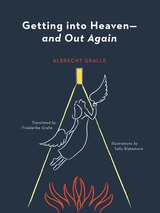 Getting into Heaven--and Out Again
Albrecht H. Gralle
Swedenborg Foundation Publishers, 2012 Imagine that you've just died. An angel appears in front of you, ready to guide you to the next life. You say to him, "I want to go to heaven." His reply, "OK, let's go!"
In this light-hearted tour of the afterlife, based on the writings of Swedish scientist-turned-seer Emanuel Swedenborg, Albrecht H. Gralle takes the reader on a tour of heaven, hell, and the spaces between. What is it like in heaven? What about hell? What happens to people who have suffered horribly in this life? How do we reconcile that suffering with the idea of an all-loving God? What happens to people who simply don't believe in anything beyond this world? What happens to the people who do? Is there sex in heaven? What about tea?
During pauses in the tour, Gralle poses some hard-hitting questions about the nature of belief that speak directly to people who wonder how a modern, rational person can have faith in the absence of proof. The result is at once humorous and thought-provoking.
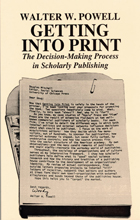 Getting into Print: The Decision-Making Process in Scholarly Publishing
Walter W. Powell
University of Chicago Press, 1985 Based on extensive fieldwork at two well-known commercial publishers of scholarly books, Walter W. Powell details the different ways in which both internal politics and external networks influence decisions about what should be published. Powell focuses on the work of acquisitions editors: how they decide which few manuscripts, out of hundreds, to sponsor for publication; how editorial autonomy is shaped, but never fully curbed, by unobtrusive controls; and how the search process fits into the social structure of the American academy. Powell's observations—and the many candid remarks of publishers and their staffs—recreate the workaday world of publishing.
Throughout, the sociology of organizations and of culture serves as Powell's interpretive framework. Powell shows how scholarly publishers help define what is "good" social science research and how the history and tradition of a publishing house contribute to the development of an organizational identity. Powell's review of actual correspondence, from outside letters proposing projects to internal "kill" letters of rejection, suggests that editors and authors at times form their own quasi-organization with external allegiances and bonds beyond those of the publishing house.
"This is a welcome addition to the literature on the life of the organizations that produce our science and our culture. Powell's intimate look at two scholarly publishing companies has an insider's appreciation of the book business and an outsider's eye for questions the editors are not asking themselves."—Michael Schudson, University of California at San Diego
"Getting Into Print will long be the book about how academic editors choose the titles they sponsor. Even experienced editors and authors will find new insights here and revealing comparisons with decision-making in other kinds of organizations."—Edward Tenner, Los Angeles Times Book Review
"Getting Into Print is an unusually outstanding ethnographic study in that it reflects the evocative richness of detail associated with the ethnographic approach while simultaneously maintaining a clear-headed, analytical distance from the subject that allows for a meaningful theoretical contribution. Powell is an astute ethnographer who presents a vital and compelling 'insider's view' of the decision-making process in scholarly publishing, making this book fascinating reading for all those involved in the 'publish-or-perish' syndrome."—Barbara Levitt, American Journal of Sociology
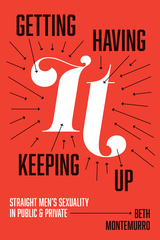 Getting It, Having It, Keeping It Up: Straight Men’s Sexuality in Public and Private
Beth Montemurro
Rutgers University Press, 2022 Scholars and social critics are looking at gender and sexuality, as well as masculinity, in new ways and with more attention to the way cultural ideologies affect men’s and women’s lives. With the rise of an online “incel” (involuntarily celibate) community and the perpetration of acts of violence in their name, as well as increased awareness about the complexities of sexual interaction brought to the fore by the #metoo movement, it has become critical to discuss how men’s sexuality and masculinity are related, as well as the way men feel about the messages they get about being a man. Prior research on masculinity and masculine sexuality has examined the experiences of adolescent boys. But what happens to boys as they become men and as many move away from homo-social environments into sexual relationships? What happens when they no longer have a crowd of peers to posture or perform for? How do their sexual experiences and sexual selves change? How do they prove their masculinity in a society that demands it when they are no longer surrounded by peers? And how do they cultivate sexual selves and sexual self-confidence in a culture that expects them to always already be knowledgeable, desiring sexual subjects? In Getting It, Having It, Keeping It Up, Beth Montemurro explores the cultivation of heterosexual men’s sexual selves. Based on detailed, in-depth interviews with a large, diverse group of heterosexual men between the ages of 20 and 68, she investigates how getting sex, having sex, and keeping up their sex lives matters to men. Ultimately, Montemurro uncovers the tension between public, cultural narratives about hetero-masculinity and men’s private, sexual selves and their intimate experiences.
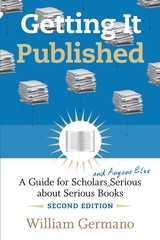 Getting It Published, 2nd Edition: A Guide for Scholars and Anyone Else Serious about Serious Books
William Germano
University of Chicago Press, 2008 Since 2001 William Germano’s Getting It Published has helped thousands of scholars develop a compelling book proposal, find the right academic publisher, evaluate a contract, handle the review process, and, finally, emerge as published authors.
But a lot has changed in the past seven years. With the publishing world both more competitive and more confusing—especially given the increased availability of electronic resources—this second edition of Germano’s best-selling guide has arrived at just the right moment. As he writes in a new chapter, the “via electronica” now touches every aspect of writing and publishing. And although scholars now research, write, and gain tenure in a digital world, they must continue to ensure that their work meets the requirements of their institutions and the needs of their readers.
Germano, a veteran editor with experience in both the university press and commercial worlds, knows this audience. This second edition will teach readers how to think about, describe, and pitch their manuscripts before they submit them. They’ll discover the finer points of publishing etiquette, including how to approach a busy editor and how to work with other publishing professionals on matters of design, marketing, and publicity. In a new afterword, they’ll also find helpful advice on what they can—and must—do to promote their work. A true insider’s guide to academic publishing, the second edition of Getting It Published will help authors understand what to expect from the publishing process, from manuscript to finished book and beyond.
 Getting It Published, Fourth Edition: A Guide for Scholars and Anyone Else Serious About Serious Books
William Germano
University of Chicago Press In this thoroughly updated fourth edition, a trusted editor offers a comprehensive guide to selecting—and working with—a book publisher.
For more than two decades, writers have turned to William Germano’s Getting It Published as a guide to the world of serious book publishing, including university presses. A professor, author, and thirty-year veteran of the book industry, Germano knows what editors want and what writers need to do to get their work published.
This fourth, thoroughly updated edition of Getting It Published accounts for new challenges facing authors and changed conditions in the publishing industry. From open access to peer review, from approaching a press to considering an agent, publishing can be confusing for authors trying to understand their options. This new edition continues to offer the clear, practicable guidance on choosing the best path to publication that has made the book such a trusted resource. Its latest revisions include an expanded chapter on proposals (and their covering emails) as well as current information on the shifting landscape of ebook publishing. But this book is more than a nuts-and-bolts guide. It takes up a writer’s biggest challenges: how to frame a book-length project, shape its argument, conceive its audience, and pitch it convincingly to an editor.
Getting It Published reflects the latest changes and technologies in the publishing industry but keeps its eye on what remains constant: Whether working on their first book or their fifth, writers can make their work stronger by knowing what publishers do and why they do it.
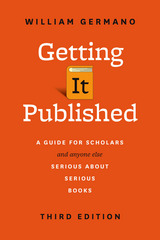 Getting It Published, Third Edition: A Guide for Scholars and Anyone Else Serious about Serious Books
William Germano
University of Chicago Press, 2016 For more than a decade, writers have turned to William Germano for his insider’s take on navigating the world of scholarly publishing. A professor, author, and thirty-year veteran of the book industry, Germano knows what editors want and what writers need to know to get their work published.
Today there are more ways to publish than ever, and more challenges to traditional publishing. This ever-evolving landscape brings more confusion for authors trying to understand their options. The third edition of Getting It Published offers the clear, practicable guidance on choosing the best path to publication that has made it a trusted resource, now updated to include discussions of current best practices for submitting a proposal, of the advantages and drawbacks of digital publishing, and tips for authors publishing textbooks and in open-access environments.
Germano argues that it’s not enough for authors to write well—they also need to write with an audience in mind. He provides valuable guidance on developing a compelling book proposal, finding the right publisher, evaluating a contract, negotiating the production process, and, finally, emerging as a published author.
“This endlessly useful and expansive guide is every academic’s pocket Wikipedia: a timely, relevant, and ready resource on scholarly publishing, from the traditional monograph to the digital e-book. I regularly share it, teach it, and consult it myself, whenever I have a question on titling a chapter, securing a permission, or negotiating a contract. Professional advice simply does not get any savvier than this pitch-perfect manual on how to think like a publisher.”—Diana Fuss, Princeton University
Getting It Right: Language, Literature, and Ethics
Geoffrey Galt Harpham
University of Chicago Press, 1992 In a critical scene deeply troubled by questions of justice and responsibility, and beset by political and moral scandals, no issue in recent years has been more urgent or more unsettled than the question of ethics. Geoffrey Galt Harpham, whose previous book, The Ascetic Imperative in Culture and Criticism, was one of the first to announce the critical renewal of ethics, attempts in this new book to explain why ethical questions resist settlement. He urges a new account of ethics not as a stable set of principles, values, or prescriptions, but as a variable factor of "imperativity" immanent in language, analysis, narrative, and creation.
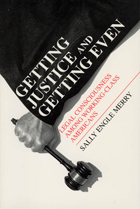 Getting Justice and Getting Even: Legal Consciousness among Working-Class Americans
Sally Engle Merry
University of Chicago Press, 1990 Ordinary Americans often bring family and neighborhood problems to court, seeking justice or revenge. The litigants in these local squabbles encounter law at its boundaries in the corridors of busy city courthouses, in the offices of court clerks, and in the church parlors used by mediation programs.
Getting Justice and Getting Even concerns the legal consciousness of working class Americans and their experiences with court and mediation. Following cases into and through the courts, Sally Engle Merry provides an ethnographic study of local law and of the people who use it in a New England city. The litigants, primarily white, native-born, and working class, go to court because as part of mainstream America they feel entitled to use its legal system. Although neither powerful nor highly educated, they expect the law's support when they face intolerable infringements of their rights, privacy, and safety. Yet as personal problems enter the legal system and move through mediation sessions, clerk's hearings, and prosecutor's conferences, the citizen plaintiff rapidly loses control of the process. Court officials and mediators interpret and characterize the meaning of these experiences, reframing and categorizing them in different discourses. Some plaintiffs yield to these interpretations, but others resist, struggling to assert their own version of the problem.
Ultimately, Merry exposes the paradox of legal entitlement. While going to court allows an individual to dominate domestic relationships, the litigant must increasingly yield control of the situation to the court that supplies that power.
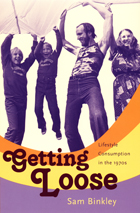 Getting Loose: Lifestyle Consumption in the 1970s
Sam Binkley
Duke University Press, 2007 From “getting loose” to “letting it all hang out,” the 1970s were filled with exhortations to free oneself from artificial restraints and to discover oneself in a more authentic and creative life. In the wake of the counterculture of the 1960s, anything that could be made to yield to a more impulsive vitality was reinvented in a looser way. Food became purer, clothing more revealing, sex more orgiastic, and home decor more rustic and authentic. Through a sociological analysis of the countercultural print culture of the 1970s, Sam Binkley investigates the dissemination of these self-loosening narratives and their widespread appeal to America’s middle class. He describes the rise of a genre of lifestyle publishing that emerged from a network of small offbeat presses, mostly located on the West Coast. Amateurish and rough in production quality, these popular books and magazines blended Eastern mysticism, Freudian psychology, environmental ecology, and romantic American pastoralism as they offered “expert” advice—about how to be more in touch with the natural world, how to release oneself into trusting relationships with others, and how to delve deeper into the body’s rhythms and natural sensuality. Binkley examines dozens of these publications, including the Whole Earth Catalog, Rainbook, the Catalog of Sexual Consciousness, Celery Wine, Domebook, and Getting Clear. Drawing on the thought of Pierre Bourdieu, Zygmunt Bauman, and others, Binkley explains how self-loosening narratives helped the middle class confront the modernity of the 1970s. As rapid social change and political upheaval eroded middle-class cultural authority, the looser life provided opportunities for self-reinvention through everyday lifestyle choice. He traces this ethos of self-realization through the “yuppie” 1980s to the 1990s and today, demonstrating that what originated as an emancipatory call to loosen up soon evolved into a culture of highly commercialized consumption and lifestyle branding.
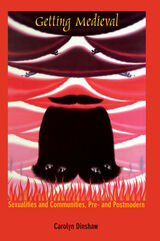 Getting Medieval: Sexualities and Communities, Pre- and Postmodern
Carolyn Dinshaw
Duke University Press, 1999 In Getting Medieval Carolyn Dinshaw examines communities—dissident and orthodox—in late-fourteenth and early-fifteenth-century England to create a new sense of queer history. Reaching beyond both medieval and queer studies, Dinshaw demonstrates in this challenging work how intellectual inquiry into pre-modern societies can contribute invaluably to current issues in cultural studies. In the process, she makes important connections between past and present cultures that until now have not been realized.
In her pursuit of historical analyses that embrace the heterogeneity and indeterminacy of sex and sexuality, Dinshaw examines canonical Middle English texts such as the Canterbury Tales and The Book of Margery Kempe. She examines polemics around the religious dissidents known as the Lollards as well as accounts of prostitutes in London to address questions of how particular sexual practices and identifications were normalized while others were proscribed. By exploring contemporary (mis)appropriations of medieval tropes in texts ranging from Quentin Tarantino’s Pulp Fiction to recent Congressional debates on U.S. cultural production, Dinshaw demonstrates how such modern media can serve to reinforce constrictive heteronormative values and deny the multifarious nature of history. Finally, she works with and against the theories of Michel Foucault, Homi K. Bhabha, Roland Barthes, and John Boswell to show how deconstructionist impulses as well as historical perspectives can further an understanding of community in both pre- and postmodern societies.
This long-anticipated volume will be indispensible to medieval and queer scholars and will be welcomed by a larger cultural studies audience.
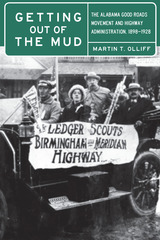 Getting Out of the Mud: The Alabama Good Roads Movement and Highway Administration, 1898–1928
Martin T. Olliff, Foreword by David O. Whitten
University of Alabama Press, 2017 Recounts the history of the Good Roads Movement that arose in progressive-era Alabama, how it used the power of the state to achieve its objectives of improving market roads for farmers and highways for automobiles
Getting Out of the Mud: The Alabama Good Roads Movement and Highway Administration, 1898–1928 explores the history of the Good Roads Movement and investigates the nature of early twentieth-century progressivism in the state. Martin T. Olliff reveals how middle-class reformers secured political, economic, and social power not only by fighting against corporate domination and labor recalcitrance but also by proposing alternative projects like road improvement and identifying the interests of the rising middle class as being the most important to public interest.
With the development of national markets in the late nineteenth and early twentieth centuries, Americans began to regard the nation as a whole, rather than their state or region, as the most important political entity. Many Alabamians wished to travel beyond their local communities in all seasons without getting stuck in the mud of rudimentary rutted dirt roads. The onset of the automobile age bolstered the need for roadmaking, alerting both automobilists and good roads advocates to the possibility of a new transportation infrastructure. The Good Roads Movement began promoting farm-to-market roads, then highways that linked cities, then those that connected states. Federal matching funds for road construction after 1916 led state and federal governments to supplant the Good Roads Movement, building and administering the highway system that emerged by the late 1920s.
Olliff’s study of how Alabamians dealt with strained resources and overcame serious political obstacles in order to construct a road system that would accommodate economic growth in the twentieth century may offer clues to the resurrection of a similar strategy in our modern era. Many problems are unchanged over the hundred years between crises: Alabamians demand good roads and a government that has the capacity to build and maintain such an infrastructure while, at the same time, citizens are voting into office men and women who promise lower taxes and smaller government.
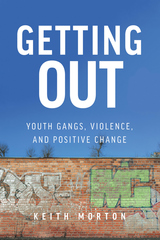 Getting Out: Youth Gangs, Violence, and Positive Change
Keith Morton
University of Massachusetts Press, 2019 For eight years Keith Morton codirected a safe-space program for youth involved in gang or street violence in Providence, Rhode Island. Getting Out is a result of the innovative perspectives he developed as he worked alongside staff from a local nonviolence institute to help these young people make life-affirming choices. Rather than view their violence as pathological, Morton explains that gang members are victims of violence, and the trauma they have experienced leads them to choose violence as the most meaningful option available. To support young people as they "unlearned" violence and pursued nonviolent alternatives, he offered what he calls a "Youth Positive" approach that prioritizes healing over punishment and recognizes them as full human beings. Informed by deep personal connections with these youth, Morton contends that to help them, we need to change our question from "What is wrong with you?" to "What happened to you?"
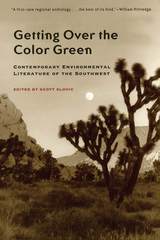 Getting Over the Color Green: Contemporary Environmental Literature of the Southwest
Scott Slovic
University of Arizona Press, 2001 Desert vistas are often deemed vacant, inhospitable wastelands. Don't suggest that to Joy Harjo, Pat Mora, or other contemporary southwestern writers. In these arid stretches, often devoid of green, today's southwestern writers see pyrotechnic colors and Gothic shapes that excite and often overwhelm the imagination. And they capture this excitement in words that fix these desert images in the minds of readers who may too often look at the world through green-colored glasses. This anthology of contemporary nature writing from the Greater Southwest brings together a host of writers including peers of Edward Abbey such as Charles Bowden and Ann Zwinger and representatives of a new generation of writers such as Rick Bass and Terry Tempest Williams. The book is an eclectic blend of nonfiction and fiction, field notes and poetry, through which artists of diverse backgrounds both celebrate and illuminate the unique vitality and complexity of southwestern literature— proving that green is only one of many colors on their palette. The selections included here range all across the southwestern landscape and explore adventures in the wild, topics in natural history, living close to the land, and efforts at conservation and restoration. They clearly demonstrate that there is grace and beauty in this often-maligned part of the world— both in the human traditions that have developed in the region and in the natural features of the desert itself.
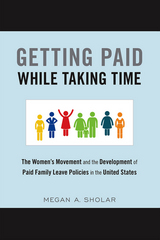 Getting Paid While Taking Time: The Women's Movement and the Development of Paid Family Leave Policies in the United States
Megan Sholar
Temple University Press, 2016 The United States remains the only industrialized nation in the world that does not provide paid family leave at the national level for either men or women. In the more than two decades since the passage of the Family and Medical Leave Act, there have been numerous unsuccessful attempts to expand family leave benefits nationally. However, in the United States, it is common for innovations in family policies to arise at the state level. In her timely book, Getting Paid While Taking Time, Megan Sholar explains the development of family leave policies at both the national and state levels in the United States. She provides cogent studies of states that have passed and proposed family leave legislation, and she pays special attention to the ways in which women’s movement actors and other activists (e.g., labor unions) exert pressure on public officials to help influence the policymaking process. In her conclusion, Sholar considers the future of paid family leave policies in the United States and the chances for it ever equaling the benefits in other countries.
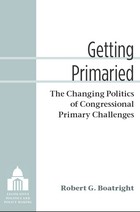 Getting Primaried: The Changing Politics of Congressional Primary Challenges
Robert G. Boatright
University of Michigan Press, 2014 Each of the past few election cycles has featured at least one instance of "primarying," a challenge to an incumbent on the grounds that he or she is not sufficiently partisan. For many observers, such races signify an increasingly polarized electorate and an increasing threat to moderates of both parties. In Getting Primaried, Robert G. Boatright shows that primary challenges are not becoming more frequent; they wax and wane in accordance with partisan turnover in Congress. The recent rise of primarying corresponds to the rise of national fundraising bases and new types of partisan organizations supporting candidates around the country. National fundraising efforts and interest group–supported primary challenges have garnered media attention disproportionate to their success in winning elections. Such challenges can work only if groups focus on a small number of incumbents. Getting Primaried makes several key contributions to congressional scholarship. It presents a history of congressional primary challenges over the past forty years, measuring the frequency of competitive challenges and distinguishing among types of challenges. It provides a correction to accounts of the link between primary competition and political polarization. Further, this study offers a new theoretical understanding of the role of interest groups in congressional elections.
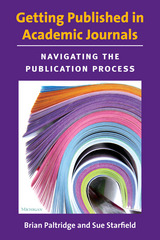 Getting Published in Academic Journals: Navigating the Publication Process
Brian Paltridge and Sue Starfield
University of Michigan Press, 2016 The pressure on graduate students and new PhDs to publish their work continues to grow with writing and publishing considered an important measure of career success within the academy. There is, however, more to the process of getting published than those who are new to the process initially realize. The aim of this guide is to clarify the process and offer advice. Getting Published in Academic Journals is written for graduate students and newly graduated PhDs who want to publish their research in peer-reviewed academic journals.
Getting Published in Academic Journals draws on the experiences of the authors as editors of peer-reviewed journals, as teachers of writing-for-publication courses and workshops, as researchers of the scholarly publication process, as reviewers of hundreds of articles, and as published authors.
The book is written to be used in courses and workshops on publishing, as a supplement to the books in the revised and updated English in Today’s Research World (Swales & Feak) series, and as a stand-alone guide for academic writers working independently.
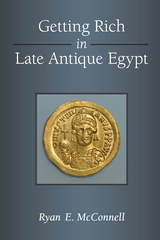 Getting Rich in Late Antique Egypt
Ryan E. McConnell
University of Michigan Press, 2017 Papyrologists and historians have taken a lively interest in the Apion family (fifth through seventh centuries), who rose from local prominence in rural Middle Egypt to become one of the wealthiest and most powerful families in the Eastern Roman Empire. The focus of most scholarly debate has been whether the Apion estate—and estates like it—aimed for a marketable surplus or for self-sufficiency. Getting Rich in Late Antique Egypt shifts the discussion to precisely how the Apions’ wealth was generated and what role their Egyptian estate played in that growth by engaging directly with broader questions of the relationship between public and private economic actors in Late Antiquity, rational management in ancient economies, the size of estates in Byzantine Egypt, and the role of rural estates in the Byzantine economy.
Ryan E. McConnell connects the family’s rise in wealth and status to its role in tax collection on behalf of the Byzantine state, rather than a reliance on productive surpluses. Close analysis of low- and high-level accounts from the Apion estate, as well as documentation from comparable Roman and Byzantine Egyptian estates, corroborate this conclusion. Additionally, McConnell offers a third way into the ongoing debate over whether the Apions’ relationship with the state was antagonistic or cooperative, concluding that the relationship was that of parties in a negotiation, with each side seeking to maximize its own benefit. The application of modern economic concepts—as well as comparisons to the economies of Athens, Rome, Ptolemaic Egypt, and Early Modern France—further illuminate the structure and function of the estate in Late Antique Egypt.
Getting Rich in Late Antique Egypt will be a valuable resource for philologists, archaeologists, papyrologists, and scholars of Late Antiquity. It will also interest scholars of agricultural, social, and economic history.
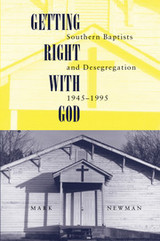 Getting Right With God: Southern Baptists and Desegregation, 1945-1995
Mark Newman
University of Alabama Press, 2001 This groundbreaking study finds Southern Baptists more diverse in their attitudes toward segregation than previously assumed Focusing on the eleven states of the old Confederacy, Getting Right with God examines the evolution of Southern Baptists’ attitudes toward African Americans during a tumultuous period of change in the United States. Mark Newman not only offers an in-depth analysis of Baptist institutions from the Southern Baptist Convention (SBC) and state conventions to colleges and churches but also probes beyond these by examining the response of pastors and lay people to changing race relations. The SBC long held that legal segregation was in line with biblical teachings, but after the Supreme Court's 1954 Brown vs. Board of Education decision in favor of desegregating public institutions, some Southern Baptists found an inconsistency in their basic beliefs. Newman identifies three major blocs of Baptist opinion about race relations: a hard-line segregationist minority that believed God had ordained slavery in the Bible; a more moderate majority that accepted the prevailing social order of racial segregation; and a progressive group of lay people, pastors, and denominational leaders who criticized and ultimately rejected discrimination as contrary to biblical teachings. According to Newman, the efforts of the progressives to appeal to Baptists’ primary commitments and the demise of de jure segregation caused many moderate and then hard-line segregationists to gradually relinquish their views, leading to the 1995 apology by the SBC for its complicity in slavery and racism. Comparing Southern Baptists with other major white denominations, Newman concludes that lay Baptists differed little from other white southerners in their response to segregation.
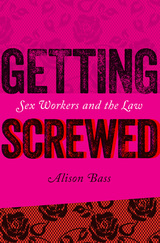 Getting Screwed: Sex Workers and the Law
Alison Bass
University Press of New England, 2015 Alison Bass weaves the true stories of sex workers with the latest research on prostitution into a gripping journalistic account of how women (and some men) navigate a culture that routinely accepts the implicit exchange of sex for money, status, or even a good meal, but imposes heavy penalties on those who make such bargains explicit. Along the way, Bass examines why an increasing number of middle-class white women choose to become sex workers and explores how prostitution has become a thriving industry in the twenty-first-century global economy. Situating her book in American history more broadly, she also discusses the impact of the sexual revolution, the rise of the Nevada brothels, and the growing war on sex trafficking after 9/11. Drawing on recent studies that show lower rates of violence and sexually transmitted diseases, including HIV, in regions where adult prostitution is legal and regulated, Bass makes a powerful case for decriminalizing sex work. Through comparisons of the impact of criminalization vs. decriminalization in other countries, her book offers strategies for making prostitution safer for American sex workers and the communities in which they dwell. This riveting assessment of how U.S. anti-prostitution laws harm the public health and safety of sex workers and other citizens—and affect larger societal attitudes toward women—will interest feminists, sociologists, lawyers, health-care professionals, and policy makers. The book also will appeal to anyone with an interest in American history and our society’s evolving attitudes toward sexuality and marriage.
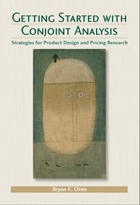 Getting Started with Conjoint Analysis: Strategies for Product Design and Pricing Research
Orme, Bryan K.
Research Publishers, 2006 Ask people what they want, and they say, "the best of everything." Ask them what they would like to spend, and they say, "as little as possible." Assessing consumer preferences and willingness to pay through direct rating scales, with separate questions about product features and prices, often fails to capture trade-offs that underlie consumer choice.
Conjoint analysis goes beyond simple surveys, providing a more realistic approach to understanding consumer attitudes, opinions, and behavior. Introduced as a fundamental measurement method more than forty years ago, conjoint analysis presents combinations of features and attributes in product profiles and asks people to rank or rate those profiles or to make choices among product profiles.
Do you have questions about the design of a new product? Want to assess the importance of product attributes? Do you need to predict consumer choice acoss a range of existing or potential products? Conjoint analysis may be the answer. Include brand names and prices in the description of product profiles, and you can use conjoint analysis to assess brand equity. Product naming and pricing studies are often conjoint studies.
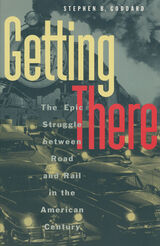 Getting There: The Epic Struggle between Road and Rail in the American Century
Stephen B. Goddard
University of Chicago Press, 1996 "A readable and concise overview of how U.S. transportation came to its present pass. . . . Goddard is at his best when recounting the complex and interesting history of what has come to be called 'the highway lobby.'. . . An excellent book for the general reader with an interest in getting around."—Larry Fish, Philadelphia Inquirer
"This is a riveting story: of mighty railroads hamstrung almost overnight by government bureaucrats; of road interests led by General Motors Corp. conspiring in city after city to destroy efficient trolley systems . . . and of freeways that are far from free."—Bill Laitner, Detroit Free Press
"The combination of forces and fates that turned America into a giant parking lot from sea to shining sea is the subject of Stephen B. Goddard's lively pop history. . . . As Mr. Goddard ably points out, road-building and the creation of car-dependent suburbs have become ends in themselves."—James Howard Kunstler, Wall Street Journal
"The strength of Goddard's book is that he understands the complexities of manipulating public opinion to influence legislatures."—David Young, Chicago Tribune
"[Goddard's] book is a deft and easily read history of how transportation has shaped the nation and its economy, and ultimately, how a federation of truck and car interests drastically tilted national policies. . . . For many reasons this is an exceptionally important work."—Jim Dwyer, New York Newsday
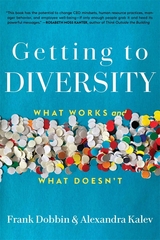 Getting to Diversity: What Works and What Doesn’t
Frank Dobbin and Alexandra Kalev
Harvard University Press, 2022 “This book has the potential to change CEO mindsets, human resource practices, manager behavior, and employee well-being—if only enough people grab it and heed its powerful messages.” —Rosabeth Moss Kanter, author of Think Outside the Building
“Dobbin and Kalev have spent their careers studying why diversity initiatives fail and what it takes to fix them. Their data-driven book doesn’t just spotlight the problems—it’s packed with solutions.” —Adam Grant
“Essential reading for anyone who wants to learn which practices can actually improve managerial diversity in organizations.”—Edward Chang, Science
“Too many companies don’t know how to walk the walk of diversity, equity, and inclusion. Getting to Diversity shows them how.”—Lori George Billingsley, former Global Chief DEI Officer, Coca-Cola Company
“This is the book all leaders need to read to achieve results.”—Adia Wingfield, author of Flatlining
Every year America becomes more diverse, but change in the makeup of the management ranks has stalled. The problem has become an urgent matter of national debate. How do we fix it?
Frank Dobbin and Alexandra Kalev draw on more than thirty years of data from eight hundred companies as well as in-depth interviews with managers to show just how little companies gain from standard practice: sending managers to diversity training to reveal their biases, then following up with hiring and promotion rules, and sanctions, to shape their behavior. Almost nothing changes. It’s time, Dobbin and Kalev argue, to focus on changing the management systems that make it hard for women and people of color to succeed. They demonstrate how the best firms are pioneering new recruitment, mentoring, and skill training systems, and implementing strategies for mixing segregated work groups to increase diversity. And they argue that as firms adopt new systems, the key to making them work is to make them accessible to all—not just the favored few.
Powerful, authoritative, and driven by a commitment to change, Getting to Diversity is the book we need now to address constructively one of the most fraught challenges in American life.
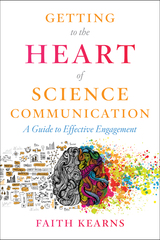 Getting to the Heart of Science Communication: A Guide to Effective Engagement
Faith Kearns
Island Press, 2021 At a community fire day in a northern California town several years ago, author Faith Kearns gave a talk on building fire-safe houses able to withstand increasingly common wildfires. Much to her surprise, Kearns was confronted by an audience member whose house had recently burned. What she thought was straightforward, helpful scientific information had instead retraumatized audience members, forcing Kearns to reevaluate her approach. Like Kearns, scientists today working on controversial issues from climate change to drought to COVID-19 are finding themselves more often in the middle of deeply traumatizing or polarized conflicts. It is no longer enough for scientists to communicate a scientific topic clearly. They must not only be experts in their fields of study, but also experts in navigating the thoughts, feelings, and opinions of members of the public they engage with, and with each other. And the conversations are growing more fraught.
In Getting to the Heart of Science Communication, Faith Kearns has penned a succinct guide for navigating the human relationships critical to the success of practice-based science. Using interviews and personal anecdotes, as well as her own insights as a field scientist, Kearns walks readers through the evolution of science communication and how emotional and high-stakes issues have shaped communication. The meat of the book lies in the middle chapters, where Kearns offers key tools for communicators: listening, working with conflict, and understanding trauma, loss, and healing. She concludes the book with a substantive discussion on diversity, equity, and inclusion in science communication, and advice to readers for handling their own emotional needs in an unpredictable career landscape.
This meticulously researched volume takes science communication to the next level, helping scientists see the value of listening as well as talking, understanding power dynamics in relationships, and addressing the roles of trauma, loss, grief, and healing. This book will particularly resonate with early to mid-career scientists, graduate students, and researchers, especially those in applied sciences who work closely with the public.
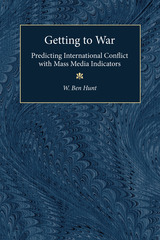 Getting to War: Predicting International Conflict with Mass Media Indicators
W. Ben Hunt
University of Michigan Press, 1997 This book shows how to predict wars. More specifically, it tells us how to anticipate in a timely fashion the scope and extent of interstate conflict. By focusing on how all governments--democratic or not--seek to secure public support before undertaking risky moves such as starting a war, Getting to War provides a methodology for identifying a regime's intention to launch a conflict well in advance of the actual initiation.
The goal here is the identification of leading indicators of war. Getting to War develops such a leading political indicator by a systematic examination of the ways in which governments influence domestic and international information flows. Regardless of the relative openness of the media system in question, we can accurately gauge the underlying intentions of those governments by a systematic analysis of opinion-leading articles in the mass media. This analysis allows us to predict both the likelihood of conflict and what form of conflict--military or diplomatic/economic--will occur.
Theoretically, this book builds on a forty-year-old insight by Karl Deutsch--that all governments seek to mobilize public opinion through mass media and that careful analysis of such domestic media activity could provide an "early warning network" of international conflict. By showing how to tap the link between conflict initiation and public support, this book provides both a useful tool for understanding crisis behavior as well as new theoretical insights on how domestic politics help drive foreign policy.
Getting to War will be of interest to political scientists who study international disputes and national security as well as social scientists interested in media studies and political communication. General readers with an interest in military or diplomatic history--particularly U.S. history--will find that Getting to War provides an entirely new perspective on how to understand wars and international crises.
W. Ben Hunt is Assistant Professor of Politics, New York University
Getting to Work on Summer Learning: Recommended Practices for Success
Catherine H. Augustine
RAND Corporation, 2013 RAND is conducting a longitudinal study that evaluates the effectiveness of voluntary summer learning programs in reducing summer learning loss, which contributes substantially to the achievement gap between low- and higher-income students. Based on evaluations of programs in six school districts, this second report in a series provides research-based advice for school district leaders as they create and strengthen summer programs.
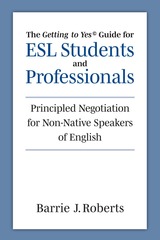 The "Getting to Yes" Guide for ESL Students and Professionals: Principled Negotiation for Non-Native Speakers of English
Barrie J. Roberts
University of Michigan Press, 2024 Getting to Yes, developed at the Harvard Negotiation Project, has been an international bestseller on win-win “principled” negotiations since 1981. Its four-step method has helped millions of people negotiate successfully with friends, relatives, business partners, customer service agents, opposing counsel, government officials, and other adversaries. Native speakers of English can easily and enjoyably learn the method by simply reading the book. But for non-native speakers of English, the vocabulary, idioms, phrasing, examples, and references can be difficult to understand. These readers may not be able to use Getting to Yes to negotiate in English on an equal footing with more fluent English speakers. The Getting to Yes Guide for ESL Students and Professionals prepares non-native speakers of English to join the global community of people who use Getting to Yes to negotiate win-win agreements in English. It provides page-by-page explanations of over 1,000 words, phrases, concepts, and examples that these readers may misunderstand; short stories that use these new words and concepts to help readers apply them to new contexts; delightful cartoons to highlight main ideas; optional ESL activities; and a glossary of the key negotiation idioms and terms used in Getting to Yes. In this guide, author Barrie J. Roberts applies her experience as a public interest attorney, court Alternative Dispute Resolution administrator, ESL instructor, and court interpreter trainer to help readers improve their professional-level English along with their negotiation skills. Benefits for teachers: - Each Chapter Guide provides a ready-made lesson plan with activities to do before, while, and after reading each chapter of Getting to Yes
- The book can be used as a recommended self-study reference
- This book can be used for selected chapters of Getting to Yes or for a complete standalone course on Getting to Yes for non-native speakers of English or Generation 1.5 students
- Optional activities throughout the book can be assigned for in or out of the classroom. These include activities for reading comprehension, vocabulary building, paraphrasing, critical thinking, discussing, and writing
- Short stories written to accompany each chapter require students to apply new vocabulary and negotiation concepts to real-world disputes
Getting to Yes with China in Cyberspace
Scott Warren Harold
RAND Corporation, 2016 This study explores U.S. policy options for managing cyberspace relations with China via agreements and norms of behavior. It considers two questions: Can negotiations lead to meaningful agreement on norms? If so, what does each side need to be prepared to exchange in order to achieve an acceptable outcome? This analysis should interest those concerned with U.S.-China relations and with developing norms of conduct in cyberspace.
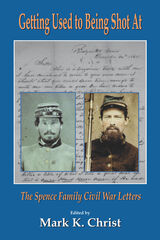 Getting Used to Being Shot At
Mark K. Christ
University of Arkansas Press, 2002 This collection of letters bears witness to the Civil War of the common soldiers and junior officers of the Army of Tennessee. Brothers Alex and Tom Spence described to their family in detail not only the many battles in which they served, but the hardship of campaigning (they marched literally thousands of miles), the pride of serving in battle-proven units, and the pain of losing comrades to bullets and disease. The Spences were a wealthy family who owned land, slaves, and the main hotel in Arkadelphia, Arkansas. With their successful careers and extensive property, they were among Clark County's most prominent families when the shadow of secession fell across Arkansas. Four years later, Arkansas would be ravaged by war, and Tom and Alex Spence would lie in soldiers' graves, far from home. Mark Christ has assembled their powerful letters from a collection in the Old State House Museum, weaving in other letters from their extended family and friends, brief but thorough introductions to each chapter, and evocative photographs. The story moves chronologically from the outset of war to the final letter from Alex's grieving fiancée.
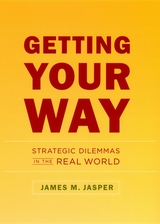 Getting Your Way: Strategic Dilemmas in the Real World
James M. Jasper
University of Chicago Press, 2006 Getting other people to do what we want is a useful skill for anyone. Whether you’re seeking a job, negotiating a deal, or angling for that big promotion, you’re engaged in strategic thought and action. In such moments, you imagine what might be going on in another person’s head and how they’ll react to what you do or say. At the same time, you also try to pick the best way to realize your goals, both with and without the other person’s cooperation. Getting Your Way teaches us how to win that game by offering a fuller understanding of how strategy works in the real world. As we all know, rules of strategy are regularly discovered and discussed in popular books for business executives, military leaders, and politicians. Those works with their trendy lists of pithy maxims and highly effective habits can help people avoid mistakes or even think anew about how to tackle their problems. But they are merely suggestive, as each situation we encounter in the real world is always more complex than anticipated, more challenging than we had hoped. James M. Jasper here shows us how to anticipate those problems before they actually occur—by recognizing the dilemmas all strategic players must negotiate, with each option accompanied by a long list of costs and risks. Considering everyday dilemmas in a broad range of familiar settings, from business and politics to love and war, Jasper explains how to envision your goals, how to make the first move, how to deal with threats, and how to employ strategies with greater confidence. Alexander the Great, Genghis Khan, Rosa Parks, Hugo Chávez, and David Koresh all come into play in this smart and engaging book, one that helps us recognize and prepare for the many dilemmas inherent in any strategic action.
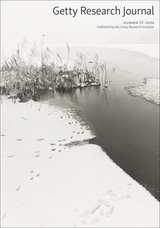 Getty Research Journal, No. 19
Doris Chon
J. Paul Getty Trust, The, 2024 The Getty Research Journal is an open-access publication presenting peer-reviewed articles on the visual arts of all cultures, regions, and time periods. The journal will be published through Getty’s Quire software beginning with this issue and made available free of charge in Web, PDF, and e-book formats. Topics relate to Getty collections, initiatives, and broad research interests. The journal welcomes a diversity of perspectives and methodological approaches, and seeks to include work that expands narratives on global cultures.
This issue features essays on a fragmentary Kufic Qurʼan of Early Abbasid style produced in Central Iran; cuttings from a twelfth-century Bible written in southeastern France for a Carthusian monastery in the orbit of the Grande Chartreuse; French archaeologist Jane Dieulafoy’s nineteenth-century documentation of Ilkhanid monuments, particularly the Emamzadeh Yahya, one of Iran’s most plundered tombs; the wartime encounter between Polish painters stationed in Baghdad and Iraqi artists during the British military reoccupation of Iraq in 1941–45; and the integration of photography and poetry in East German samizdat artists’ books of the 1980s. Shorter texts include a notice on a large folding panorama of the city of Salvador in the state of Bahia, taken around 1880 by Brazilian photographer Rodolpho Lindemann.
The free online edition of this open-access publication is at www.getty.edu/publications/grj/19/ and includes zoomable illustrations. Free PDF and EPUB downloads of the book are also available.
 Getty Research Journal, No. 20
Doris Chon
J. Paul Getty Trust, The, 2025 The Getty Research Journal presents peer-reviewed articles on the visual arts of all cultures, regions, and time periods. Topics often relate to Getty collections, initiatives, and broad research interests. The journal welcomes a diversity of perspectives and methodological approaches, and seeks to include work that expands narratives on global culture.
This issue features essays on the remembering and remaking of Second Empire table centerpieces by French fine metalworking firm Christofle et Cie during the Third Republic; satirical photomontages by Soviet artist trio Brigade KGK in 1934 for an illustrated edition of Joseph Stalin’s speech; a forgotten but important example of New Deal–era painting by little-known US American artist Bennett Buck mistakenly attributed to Mexican muralist José Clemente Orozco; poet David Antin’s turn to talking in the 1970s as oral art criticism; the marketing of a limited-edition portfolio published in 1976 by dealer Harry Lunn featuring prints by Gerd Sander of photographer Lisette Model’s work from the 1930s and ’40s; and the material culture and interpretive program at Eastern State Penitentiary Historic Site in Philadelphia shaping the public conversation about justice in the criminal legal system. Shorter texts include a notice on a sketchbook shared between French artist Rosa Bonheur and her father and teacher, Raymond Bonheur, during the 1840s and ’50s. This issue also includes a conversation between scholar Laura G. Gutiérrez and visual artist Felipe Baeza about art making, migration, legibility, and belonging in the context of his project, Unruly Forms.
The free online edition of this open-access publication is available at www.getty.edu/publications/getty-research-journal/20/. Also available are free PDF and EPUB downloads of the book.
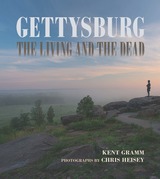 Gettysburg: The Living and the Dead
Kent Gramm. Photographs by Chris Heisey
Southern Illinois University Press, 2019 In Gettysburg: The Living and the Dead, writer Kent Gramm and photographer Chris Heisey tell the famous battle’s story through the eyes of those who lived and died there. Unlike histories that simply recount the three furious days in July 1863, this book transports readers onto the battlefield and into the event’s historical echoes, making for a delightful, immersive experience.
Creative nonfiction, fiction, dramatic dialogue, and poetry combine with full-color photographs to convey the essential reality of the famous battlefield as a place both terrible and beautiful. The living and the dead contained here include Confederates and Yankees, soldiers and civilians, male and female, young and old. Visitors to the battlefield after 1863, both well known and obscure, provide the voices of the living. They include a female admiral in the U.S. Navy and a man from rural Virginia who visits the battlefield as a way of working through the death of his son in Iraq. The ghostly voices of the dead include actual participants in the battle, like a fiery colonel and a girl in Confederate uniform, as well as their representatives, such as a grieving widow who has come to seek her husband.
Utilizing light as a central motif and fourscore and seven voices to evoke how Gettysburg continues to draw visitors and resound throughout history, alternately wounding and stitching the lives it touches, Gramm’s words and Heisey’s photographs meld for a historical experience unlike any other. Gettysburg: The Living and the Dead offers a panoramic view wherein the battle and battlefield of Gettysburg are seen through the eyes of those who lived through it and died on it as well as those who have sought meaning at the site ever since.
Gewirth's Ethical Rationalism: Critical Essays with a Reply by Alan Gewirth
Edited by Edward Regis Jr.
University of Chicago Press, 1984 Alan Gewirth's Reason and Morality directed philosophical attention to the possibility of presenting a rational and rigorous demonstration of fundamental moral principles. Now, these previously unpublished essays from some of the most distinguished philosophers of our generation subject Gewirth's program to thorough evaluation and assessment. In a tour de force of philosophical analysis, Professor Gewirth provides detailed replies to all of his critics—a major, genuinely clarifying essay of intrinsic philosophical interest.
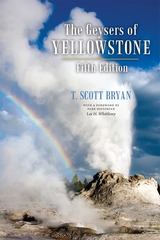 The Geysers of Yellowstone, Fifth Edition
T. Scott Bryan
University Press of Colorado, 2018 This new edition of The Geysers of Yellowstone is the most up-to-date and comprehensive reference to the geysers of Yellowstone National Park, describing in detail each of the more than five hundred geysers in the park. The entire text has been revised and geyser descriptions have been updated based on activity observed through early 2018. Information about a number of significant new geyser developments has been added, as well as recent knowledge about some of the world’s geyser fields outside Yellowstone.
Both a reference work and a fine introduction to the nature of geyser activity, this popular field guide includes a glossary of key terms, a comprehensive appendix that discusses other geyser areas of the world, detailed maps of each geyser basin, and tables for easy reference. The Geysers of Yellowstone will continue to serve geyser gazers as well as newcomers to geothermal phenomena for years to come.
Geysers of Yellowstone, Fourth Edition
T. Scott Bryan
University Press of Colorado, 2008 This revised popular field guide describes in detail each of the more than 500 geysers in Yellowstone National Park. With updated information and a new foreword by park archivist Lee Whittlesey, Geysers of Yellowstone is both a reference work and a fine introduction to the nature of geyser activity for the newcomer to geothermal phenomena. A glossary of key terms is provided, along with a comprehensive appendix that discusses other geyser areas of the world. Detailed maps accompany each geyser basin described, and tables are provided for easy reference.
 The Geysers of Yellowstone: Sixth Edition
T. Scott Bryan
University Press of Colorado, 2024 This new edition of The Geysers of Yellowstone is the most up-to-date and comprehensive reference to the geysers of Yellowstone National Park, describing in detail each of the park's more than five hundred geysers. The text has been revised and geyser descriptions have been updated based on activity observed through summer 2023. Information about a number of significant new geyser developments, including the conclusions of several recent seismic and other geophysical studies, have been added.
Both a reference work and a fine introduction to the nature of geyser activity, this popular field guide includes detailed maps of each geyser basin, tables for easy reference, and a glossary of key terms. A comprehensive appendix discusses other geyser areas of the world, several of which are described here for the first time. The Geysers of Yellowstone will continue to serve geyser gazers as well as newcomers to geothermal phenomena for years to come.
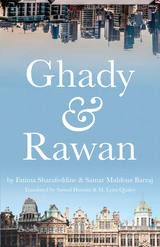 Ghady & Rawan
By Fatima Sharafeddine and Samar Mahfouz Barraj, translated by M. Lynx Qualey and Sawad Hussain
University of Texas Press, 2019 Ghady and Rawan is a heartfelt and timely novel by the award-winning author Fatima Sharafeddine (The Servant, Cappuccino) and Samar Mahfouz Barraj. The novel follows the close-knit friendship of two Lebanese teenagers, Ghady, who lives with his family in Belgium, and Rawan, who lives in Lebanon. Ghady’s family travels every summer to Beirut, where Ghady gets to spend all his time with Rawan and their other friends, enjoying their freedom from school. During the rest of the year, he and Rawan keep in touch by email. Through this correspondence, we learn about the daily ups and downs of their lives in Brussels and Beirut, including Ghady’s homesickness and his struggles with racism at school, as well as Rawan’s changing relationship to her family. The novel offers a glimpse into the lives of Lebanese adolescents while exploring a range of topics relevant to young people everywhere: bullying, parental conflicts, racism, belonging and identity, and peer pressure. Through the connection between the two main characters, Sharafeddine and Mahfouz Barraj show how the love and support of a good friend can help you through difficulties as well as sweeten life’s triumphs and good times.
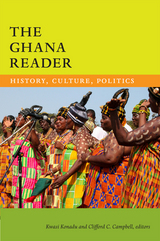 The Ghana Reader: History, Culture, Politics
Kwasi Konadu and Clifford C. Campbell, editors
Duke University Press, 2016 Covering 500 years of Ghana's history, The Ghana Reader provides a multitude of historical, political, and cultural perspectives on this iconic African nation. Whether discussing the Asante kingdom and the Gold Coast's importance to European commerce and transatlantic slaving, Ghana's brief period under British colonial rule, or the emergence of its modern democracy, the volume's eighty selections emphasize Ghana's enormous symbolic and pragmatic value to global relations. They also demonstrate that the path to fully understanding Ghana requires acknowledging its ethnic and cultural diversity and listening to its population's varied voices. Readers will encounter selections written by everyone from farmers, traders, and the clergy to intellectuals, politicians, musicians, and foreign travelers. With sources including historical documents, poems, treaties, articles, and fiction, The Ghana Reader conveys the multiple and intersecting histories of Ghana's development as a nation, its key contribution to the formation of the African diaspora, and its increasingly important role in the economy and politics of the twenty-first century.
Ghazal Games: Poems
Roger Sedarat
Ohio University Press, 2011 As an Iranian American poet, Roger Sedarat fuses Western and Eastern traditions to reinvent the classicalPersian form of the ghazal. For its humor as well as its spirituality, the poems in this collection can perhapsbest be described as “Wallace Stevens meets Rumi.” Perhaps most striking is the poet’s use of the ancient ghazal form in the tradition of the classical masters like Hafez and Rumi to politically challenge the Islamic Republic of Iran’s continual crackdown on protesters. Not since the late Agha Shahid Ali has a poet translated the letter as well as the spirit of this form into English, using musicality and inventive rhyme to extend the reach of the ghazal in a new language and tradition.
Ghazals: Translations of Classic Urdu Poetry
Mir Taqi Mir
Harvard University Press, 2022 The finest ghazals of Mir Taqi Mir, the most accomplished of Urdu poets.
The prolific Mir Taqi Mir (1723–1810), widely regarded as the most accomplished poet in Urdu, composed his ghazals—a poetic form of rhyming couplets—in a distinctive Indian style arising from the Persian ghazal tradition. Here, the lover and beloved live in a world of extremes: the outsider is the hero, prosperity is poverty, and death would be preferable to the indifference of the beloved. Ghazals offers a comprehensive collection of Mir’s finest work, translated by a renowned expert on Urdu poetry.
Gheo-Shih: An Archaic Macroband Camp in the Valley of Oaxaca
Frank Hole and Kent V. Flannery
University of Michigan Press, 2024 Gheo-Shih, an Archaic site in the Valley of Oaxaca, was a 1.5-hectare open-air macroband camp near the Mitla River. It was repeatedly occupied in the summer rainy season during the period (cal.) 7500–4000 BC, possibly by 25–50 people. At other times of the year the local population dispersed in smaller, family-sized groups, occupying microband camps in caves and rockshelters. The available macrofossil and palynological data suggest that between 5000 and 4000 BC, the inhabitants were cultivating maize, squash, gourds, and (possibly) runner beans, while continuing to collect wild plants and hunt deer, rabbit, and mud turtle. This site report describes the discovery of Gheo-Shih and the subsequent research carried out there: a systematic surface pickup, a series of test pits, targeted excavations, and analysis of the materials recovered.
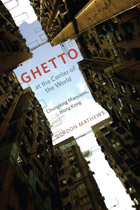 Ghetto at the Center of the World: Chungking Mansions, Hong Kong
Gordon Mathews
University of Chicago Press, 2011 There is nowhere else in the world quite like Chungking Mansions, a dilapidated seventeen-story commercial and residential structure in the heart of Hong Kong’s tourist district. A remarkably motley group of people call the building home; Pakistani phone stall operators, Chinese guesthouse workers, Nepalese heroin addicts, Indonesian sex workers, and traders and asylum seekers from all over Asia and Africa live and work there—even backpacking tourists rent rooms. In short, it is possibly the most globalized spot on the planet.
But as Ghetto at the Center of the World shows us, a trip to Chungking Mansions reveals a far less glamorous side of globalization. A world away from the gleaming headquarters of multinational corporations, Chungking Mansions is emblematic of the way globalization actually works for most of the world’s people. Gordon Mathews’s intimate portrayal of the building’s polyethnic residents lays bare their intricate connections to the international circulation of goods, money, and ideas. We come to understand the day-to-day realities of globalization through the stories of entrepreneurs from Africa carting cell phones in their luggage to sell back home and temporary workers from South Asia struggling to earn money to bring to their families. And we see that this so-called ghetto—which inspires fear in many of Hong Kong’s other residents, despite its low crime rate—is not a place of darkness and desperation but a beacon of hope.
Gordon Mathews’s compendium of riveting stories enthralls and instructs in equal measure, making Ghetto at the Center of the World not just a fascinating tour of a singular place but also a peek into the future of life on our shrinking planet.
Ghetto Kingdom: Tales of the Lodz Ghetto
Isaiah Spiegel
Northwestern University Press, 1998 Isaiah Spiegel was an inmate of the Lodz Ghetto from its inception in 1940 until its liquidation in 1944. While there, he wrote short stories depicting Jewish life in the ghetto and managed to hide them before he was deported to Auschwitz. After being freed, he returned to Lodz to retrieve and publish his stories.
The stories examine the relationship between inmates and their families, their friends, their Christian former neighbors, the German soldiers, and, ultimately, the world of hopelessness and desperation that surrounded them. In using his creative powers to transform the suffering and death of his people into stories that preserve their memory, Spiegel succeeds in affirming the humanity and dignity the Germans were so intent on destroying.
Originally published as Malchut geto (Malkhes geto) in Yiddish.
 Ghetto: The History of a Word
Daniel B. Schwartz
Harvard University Press, 2019 Just as European Jews were being emancipated and ghettos in their original form—compulsory, enclosed spaces designed to segregate—were being dismantled, use of the word ghetto surged in Europe and spread around the globe. Tracing the curious path of this loaded word from its first use in sixteenth-century Venice to the present turns out to be more than an adventure in linguistics.
Few words are as ideologically charged as ghetto. Its early uses centered on two cities: Venice, where it referred to the segregation of the Jews in 1516, and Rome, where the ghetto survived until the fall of the Papal States in 1870, long after it had ceased to exist elsewhere.
Ghetto: The History of a Word offers a fascinating account of the changing nuances of this slippery term, from its coinage to the present day. It details how the ghetto emerged as an ambivalent metaphor for “premodern” Judaism in the nineteenth century and how it was later revived to refer to everything from densely populated Jewish immigrant enclaves in modern cities to the hypersegregated holding pens of Nazi-occupied Eastern Europe. We see how this ever-evolving word traveled across the Atlantic Ocean, settled into New York’s Lower East Side and Chicago’s Near West Side, then came to be more closely associated with African Americans than with Jews.
Chronicling this sinuous transatlantic odyssey, Daniel B. Schwartz reveals how the history of ghettos is tied up with the struggle and argument over the meaning of a word. Paradoxically, the term ghetto came to loom larger in discourse about Jews when Jews were no longer required to live in legal ghettos. At a time when the Jewish associations have been largely eclipsed, Ghetto retrieves the history of a disturbingly resilient word.
 Ghettostadt: Łódź and the Making of a Nazi City
Gordon J. Horwitz
Harvard University Press, 2008 Under the Third Reich, Nazi Germany undertook an unprecedented effort to refashion the city of Łódź. Home to prewar Poland’s second most populous Jewish community, this was to become a German city of enchantment—a modern, clean, and orderly showcase of urban planning and the arts. Central to the undertaking, however, was a crime of unparalleled dimension: the ghettoization, exploitation, and ultimate annihilation of the city’s entire Jewish population.
Ghettostadt is the terrifying examination of the Jewish ghetto’s place in the Nazi worldview. Exploring ghetto life in its broadest context, it deftly maneuvers between the perspectives and actions of Łódź’s beleaguered Jewish community, the Germans who oversaw and administered the ghetto’s affairs, and the “ordinary” inhabitants of the once Polish city. Gordon Horwitz reveals patterns of exchange, interactions, and interdependence within the city that are stunning in their extent and intimacy. He shows how the Nazis, exercising unbounded force and deception, exploited Jewish institutional traditions, social divisions, faith in rationality, and hope for survival to achieve their wider goal of Jewish elimination from the city and the world. With unusual narrative force, the work brings to light the crushing moral dilemmas facing one of the most significant Jewish communities of Nazi-occupied Eastern Europe, while simultaneously exploring the ideological underpinnings and cultural, economic, and social realities within which the Holocaust took shape and flourished.
This lucid, powerful, and harrowing account of the daily life of the “new” German city, both within and beyond the ghetto of Łódź, is an extraordinary revelation of the making of the Holocaust.
Ghost Bears: Exploring The Biodiversity Crisis
R. Edward Grumbine; Foreword by Michael E. Soule
Island Press, 1992 In Ghost Bears, R. Edward Grumbine looks at the implications of the widespread loss of biological diversity, and explains why our species-centered approach to environmental protection will ultimately fail. Using the fate of the endangered grizzly bear -- the "ghost bear" -- to explore the causes and effects of species loss and habitat destruction, Grumbine presents a clear and inviting introduction to the biodiversity crisis and to the new science of conservation biology.
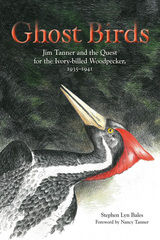 Ghost Birds: Jim Tanner and the Quest for the Ivory-billed Woodpecker, 1935–1941
Stephen Lyn Bales
University of Tennessee Press, 2010
“Everyone who is interested in the ivory-billed woodpecker will want to read this book—from scientists who wish to examine the data from all the places Tanner explored to the average person who just wants to read a compelling story.”
—Tim Gallagher, author of The Grail Bird: The Rediscovery of the Ivory-billed Woodpecker
In 1935 naturalist James T. Tanner was a twenty-one-year-old graduate student when he saw his first ivory-billed woodpecker, one of America’s rarest birds, in a remote swamp in northern Louisiana. At the time, he was part of an ambitious expedition traveling across the country to record and photograph as many avian species as possible, a trip organized by Dr. Arthur Allen, founder of the famed Cornell Lab of Ornithology. Two years later, Tanner hit the road again, this time by himself and in search of only one species—that ever-elusive ivory-bill. Sponsored by Cornell and the Audubon Society, Jim Tanner’s work would result in some of the most extensive field research ever conducted on the magnificent woodpecker.
Drawing on Tanner’s personal journals and written with the cooperation of his widow, Nancy, Ghost Birds recounts, in fascinating detail, the scientist’s
dogged quest for the ivory-bill as he chased down leads in eight southern states. With Stephen Lyn Bales as our guide, we experience the same awe and excitement that Tanner felt when he returned to the Louisiana wetland he had visited earlier and was able to observe and document several of the “ghost birds”—including a nestling that he handled, banded, and photographed at close range. Investigating the ivory-bill was particularly urgent because it was a fast-vanishing species, the victim of indiscriminant specimen hunting and widespread logging that was destroying its habitat. As sightings became rarer and rarer in the decades following Tanner’s remarkable research, the bird was feared to have become extinct. Since 2005, reports of sightings in Arkansas and Florida made headlines and have given new hope to ornithologists and bird lovers, although extensive subsequent investigations have yet to produce definitive confirmation.
Before he died in 1991, Jim Tanner himself had come to believe that the majestic woodpeckers were probably gone forever, but he remained hopeful
that someone would prove him wrong. This book fully captures Tanner’s determined spirit as he tracked down what was then, as now, one of ornithology’s true Holy Grails.
STEPHEN LYN BALES is a naturalist at the Ijams Nature Center in Knoxville, Tennessee. He is the author of Natural Histories, published by UT Press in 2007.
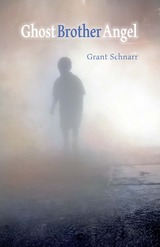 Ghost Brother Angel
Grant Schnarr
Swedenborg Foundation Publishers, 2012
As a child, Grant Schnarr was haunted (as many children are) by a fear of the dark, a fear of the unknown, of monsters in his closet. But more than that, he was haunted by a real ghost—a dark presence that lingered in his family’s house, occasionally moving objects, making noises, or even appearing to unsuspecting family members and guests.
As an adult, Grant had almost forgotten about the ghost until a series of brushes with death began to awaken old memories. Over the course of several months, a series of “coincidences” led him to dig deeper and deeper into a long-buried family tragedy. Forced to confront his deepest fears, armed with the lessons he learned from the spiritual warriors in his life, he finally learns the truth on a dark night in the woods of Wisconsin.
Anyone who has suffered a loss or struggled with fears will relate to this real-life tale of facing your inner—and outer—demons, told from Grant’s uniquely Swedenborgian perspective.
 Ghost Citizens: Jewish Return to a Postwar City
Lukasz Krzyzanowski
Harvard University Press, 2020 The poignant story of Holocaust survivors who returned to their hometown in Poland and tried to pick up the pieces of a shattered world.
In the immediate aftermath of World War II, the lives of Polish Jews were marked by violence and emigration. But some of those who had survived the Nazi genocide returned to their hometowns and tried to start their lives anew. Lukasz Krzyzanowski recounts the story of this largely forgotten group of Holocaust survivors. Focusing on Radom, an industrial city about sixty miles south of Warsaw, he tells the story of what happened throughout provincial Poland as returnees faced new struggles along with massive political, social, and legal change.
Non-Jewish locals mostly viewed the survivors with contempt and hostility. Many Jews left immediately, escaping anti-Semitic violence inflicted by new communist authorities and ordinary Poles. Those who stayed created a small, isolated community. Amid the devastation of Poland, recurring violence, and bureaucratic hurdles, they tried to start over. They attempted to rebuild local Jewish life, recover their homes and workplaces, and reclaim property appropriated by non-Jewish Poles or the state. At times they turned on their own. Krzyzanowski recounts stories of Jewish gangs bent on depriving returnees of their prewar possessions and of survivors shunned for their wartime conduct.
The experiences of returning Jews provide important insights into the dynamics of post-genocide recovery. Drawing on a rare collection of documents—including the postwar Radom Jewish Committee records, which were discovered by the secret police in 1974—Ghost Citizens is the moving story of Holocaust survivors and their struggle to restore their lives in a place that was no longer home.
The Ghost Dancers: A Novel
Adrian C. Louis
University of Nevada Press, 2021 Lyman “Bean” Wilson, a half-breed Nevada Indian and middle-aged professor of journalism at Lakota University in South Dakota, is reassesing his life. The result is a string of family reconnections, sexual adventures, crises at work, pipe and sweat-lodge ceremonies, and—through his membership in the secret Ghost Dancers Society—political activism, culminating in a successful plot to blow the nose off of the George Washington statue on Mt. Rushmore.
 Ghost Dancing the Law: The Wounded Knee Trials
John William Sayer
Harvard University Press, 1997 After the siege ended at Wounded Knee, the real battle had yet to be fought. The 1973 standoff in South Dakota between Oglala Lakota Indians and federal lawmen led to the criminal prosecution of American Indian Movement leaders Dennis Banks and Russell Means. The ten-month trial had all the earmarks of a political tribunal; with the defense led by William Kunstler and the prosecution backed by the Nixon administration, it became a media battle for public opinion.
This first book-length study of the Wounded Knee trials demonstrates the impact that legal institutions and the media have on political dissent. It also shows how the dissenters as defendants can influence these institutions and the surrounding political and cultural climate. AIM and its attorneys successfully turned the courtroom into a political forum on the history of U.S.-Indian relations but were often frustrated in telling their story by the need to observe legal procedures--and by the media's stereotyping them as Indian warriors or sixties militants. John Sayer draws on court records, news reports, and interviews with participants to show how the defense, and ultimately the prosecution, had to respond continually to legal constraints, media coverage, and political events taking place outside the courtroom.
Although Banks and Means and most of the other protesters were acquitted, Sayer notes that the confinement of AIM protests to the courtroom robbed the movement of considerable momentum. Ghost Dancing the Law shows how legal proceedings can effectively quell dissent and represents both a critical chapter in the struggle of Native Americans and an important milestone at the crossroads of law and politics.
Ghost Gear: Poems
Andrew McFadyen-Ketchum
University of Arkansas Press, 2014 2014 finalist, Miller Williams Arkansas Poetry Prize
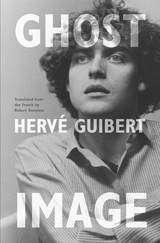 Ghost Image
Hervé Guibert
University of Chicago Press, 2014 Ghost Image is made up of sixty-three short essays—meditations, memories, fantasies, and stories bordering on prose poems—and not a single image. Hervé Guibert’s brief, literary rumination on photography was written in response to Roland Barthes’s Camera Lucida, but its deeply personal contents go far beyond that canonical text. Some essays talk of Guibert’s parents and friends, some describe old family photographs and films, and spinning through them all are reflections on remembrance, narcissism, seduction, deception, death, and the phantom images that have been missed.
Both a memoir and an exploration of the artistic process, Ghost Image not only reveals Guibert’s particular experience as a gay artist captivated by the transience and physicality of his media and his life, but also his thoughts on the more technical aspects of his vocation. In one essay, Guibert searches through a cardboard box of family portraits for clues—answers, or even questions—about the lives of his parents and more distant relatives. Rifling through vacation snapshots and the autographed images of long-forgotten film stars, Guibert muses, “I don’t even recognize the faces, except occasionally that of an aunt or great-aunt, or the thin, fair face of my mother as a young girl.” In other essays, he explains how he composes his photographs, and how—in writing—he seeks to escape and correct the inherent limits of his technique, to preserve those images lost to his technical failings as a photographer.
With strains of Jean Genet and recurring themes that speak to the work of contemporary artists across a range of media, Guibert’s Ghost Image is a beautifully written, melancholic ode to existence and art forms both fleeting and powerful—a unique memoir at the nexus of family, memory, desire, and photography.
The Ghost in the Little House: A Life of Rose Wilder Lane
William Holtz
University of Missouri Press, 1995 Laura Ingalls Wilder is one of the most beloved children’s authors of all time, but William Holtz contends that she may not have been the sole author of the Little House series that bore her name. While Laura’s life did serve as the inspiration for the books, Holtz believes that her daughter, Rose Wilder Lane, actually took her mother’s memoirs and refurbished them into the novels that would be read by millions. In this captivating biography, Holtz chronicles Rose’s life from childhood, to travels abroad that began at age seventeen, and finally back home to Missouri in her mid-thirties where she would fine tune her mother’s writing. Holtz does not write to expose Laura as a fraud, but instead The Ghost in the Little House explains that Laura’s books were more of a collaborative effort than anyone knew.
 A Ghost in Trieste
Joseph Cary
University of Chicago Press, 1993 Gem of the Adriatic, Trieste sparkled and beckoned through the pages of poets and novelists. Drawn there in search of literary ghosts, of the poet Umberto Saba and the novelists Italo Svevo and James Joyce, Joseph Cary found instead a city with an imaginative life of its own, the one that rises, tantalizing from the pages of this book. The story of Cary's travels, A Ghost in Trieste, is also a tale of discovery and transformation, as the bustling world of port and airplane, baggage and trams and trains becomes the landscape of history and literature, language and art, psychoanalysis and the self.
Here is the crossroads of East and West. A port held in turn by the Romans, the Venetians, the Austrians, the Germans, the Slavs, and finally the Italians, Trieste is the capital of nowhere, fertile source of a unique literary florescence before the First World War. At times an exile home and an exiled city. "I cannot claim to have walked across it all,:" wrote Saba, the poet of Trieste in 1910 of the city Cary crosses and recrosses, seeking the poetry of the place that inspired its literary giants. Trieste's cultural and historical riches, its geographical splendor of hills and sea and mysterious presence unfold in a series of stories, monologues and literary juxtapositions that reveal the city's charms as well as its seductive hold on the writer's imagination. Throughout, literary and immediate impressions alike are elaborated in paintings and maps, and in handsome line drawings by Nicholas Read.
This "clownish and adolescent Parsifal," this Trieste of the "prickly grace," this place "impaled in my heart like a permanent point," this symbol of the Adriatic, this "city made of books" — here the book remakes the city. The Trieste of allusions magically becomes a city of palpable allure, of warmth and trying contradictions and gritty beauty. Part travel diary, part guide book, part literary history, A Ghost in Trieste is a brilliant introduction to an extraordinary time and place. In Joseph Cary, Trieste has found a new poet, and readers, a remarkably captivating companion and guide.
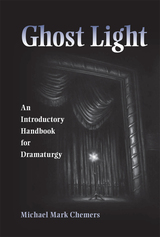 Ghost Light: An Introductory Handbook for Dramaturgy
Michael Mark Chemers
Southern Illinois University Press, 2010 Ghost Light: An Introductory Handbook for Dramaturgy offers useful and entertaining answers to the confounding questions: “What, exactly, is dramaturgy, and what does a dramaturg do?” According to Michael Mark Chemers, dramaturgs are the scientists of the theater world—their primary responsibility is to query the creative possibilities in every step of the production process, from play selection to costume design, and then research the various options and find ways to transform that knowledge into useful ideas. To say that dramaturgs are well-rounded is an understatement: those who choose this profession must possess an acute aesthetic sensibility in combination with an extensive knowledge of theater history and practice, world history, and critical theory, and they must be able to collaborate with every member of the creative team and theater administration.
Ghost Light is divided into three sections. Part 1, “Philosophy,” describes what dramturgs do, presents a detailed history of dramaturgy, and summarizes many of the critical theories needed to analyze and understand dramatic texts. “Analysis” teaches the two essential skills of a dramaturg: reading and writing. It includes a “12-step program for script analysis” along with suggestions about how to approach various genres and play structures. “Practice,” the third part, delves into the relationships that dramaturgs forge and offers useful advice about collaborating with other artists. It also includes ideas for audience outreach initiatives such as marketing and publicity plans, educational programs, talkbacks, blogs, and program notes and lobby displays, all of which are often the responsibility of the dramaturg.
Ghost Light was written with undergraduate students in mind and is perfectly suited for the classroom (each chapter concludes with a series of practical exercises that can be used as course assignments). However, dramaturgy is a skill that is essential to all theater practitioners, not just professional or aspiring dramaturgs, making Ghost Light a valuable addition to all theater libraries.
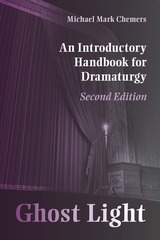 Ghost Light: An Introductory Handbook for Dramaturgy
Michael Mark Chemers, with a foreword by Faedra Chatard Carpenter
Southern Illinois University Press, 2023 A new edition of the celebrated introduction to dramaturgy training and practice
Since its release in 2010, Ghost Light: An Introductory Handbook for Dramaturgy has become the international standard for dramaturgy training and practice. The first textbook introduced students to the “ghost light” model of dramaturgy—a creatively engaged, artistically vibrant approach that draws on extensive knowledge of theatre history, practice, and theory—and this second edition brings the conversation up to the present.
Over three parts, author and theory creator Michael Mark Chemers helps students explore the world of the dramaturg. Part 1 describes what dramaturgs do, presents a detailed history of dramaturgy, and summarizes many of the critical theories needed to analyze and understand dramatic texts. Part 2 teaches students to read, write, and analyze scripts through a twelve-step program with suggestions about how to approach various genres and play structures. The final part delves into the relationships dramaturgs forge and offers useful advice about collaborating with other artists. It also includes ideas for audience outreach initiatives such as marketing and publicity plans, educational programs, program notes and lobby displays, and more.
Perfectly suited for the undergraduate theatre classroom, this holistic guide includes chapter exercises for students to practice the skills as they learn. The new edition also incorporates recent theory and new resources on multimedia performance and dramaturgy in the digital age. As the field of dramaturgy continues to shift and change, this new edition of Ghost Light: An Introductory Handbook for Dramaturgy prepares theatre students and practitioners to create powerful, relevant performances of all types.
Ghost Man on Second
Erica Reid
Autumn House Press, 2024 A debut poetry collection centered on strained family relationships and the search for new homes.
Erica Reid’s debut collection, Ghost Man on Second, traces a daughter’s search for her place in the world after estrangement from her parents. Reid writes, “It’s hard to feel at home unless I’m aching.” Growing from this sense of isolation, Reid’s poems create new homes in nature, in mythology, and in poetic forms—including sestinas, sonnets, and golden shovels—containers that create and hold new realizations and vantage points. Reid stands up to members of her family, asking for healing amid dissolving bonds. These poems move through emotional registers, embodying nostalgia, hurt, and hope. Throughout Ghost Man on Second, the poems portray Reid’s active grappling with home and confrontation with the ghosts she finds there.
Ghost Man on Second is the winner of the 2023 Donald Justice Poetry Prize, selected by Mark Jarman.
Ghost Of
Diana Khoi Nguyen
Omnidawn, 2018 Ghost Of is a mourning song, not an exorcism or un-haunting of that which haunts, but attuned attention, unidirectional reaching across time, space, and distance to reach loved ones, ancestors, and strangers. By working with, in, and around the photographs that her brother left behind (from which he cut himself out before his death), Nguyen wrestles with what remains: memory, physical voids, and her family captured around an empty space.
Ghost Of was selected by Terrance Hayes to win Omnidawn’s Open Poetry Book Contest. It was also a finalist for the National Book Award and L.A. Times Book Prize.
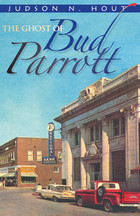 The Ghost of Bud Parrott: a novel
Judson N Hout
Parkhurst Brothers, Inc., 2010 A teen’s life is complicated. Add an overworked dad, a distraught mom.
Enter an old man from the wrong side of the tracks.
He knows things. He’s there when you need him.
This happens to someone; it’s not a maybe thing. People get hurt. People die. There’s a dad who loves his kid but works all the time. When he doesn’t work, he drinks. When he drinks he’s out of control.
There’s a mom. She knows dad is overworked, a good man carrying too much responsibility.
The kid turns to the handy man to learn a man’s skills. In the old man from the wrong side of the tracks, the kid finds unusual skills and terrible—but true—lessons. He finds that his own safety comes at a cost to his unfortunate friend. He finds growing up comes at a cost to himself. This is the story of such a kid, told by himself after he has lived much of his life, come to terms with his parents’ weaknesses, and learned that seemingly insignificant people carry more pain than he can imagine, though he has already seen plenty.
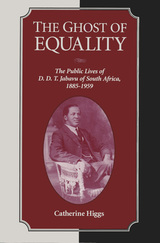 The Ghost of Equality: The Public Lives of D. D. T. Jabavu of South Africa, 1885–1959
Catherine Higgs
Ohio University Press, 1996 Davidson Don Tengo Jabavu was born in the Cape Colony in British southern Africa on October 20, 1885, when a few African men could vote and the prospects for black equality with the ruling whites seemed promising. He died on August 3, 1959, in the Cape Province of the Union of South Africa, eleven years after the apartheid state had begun stripping blacks of their rights and exorcising the ‘ghost of equality’ with a completeness unparalleled in the country’s history. The ‘ghost of equality was the last vestige of the Cape liberal tradition — itself best summed up by the dictum ’equal rights for all civilized men‘ — finally erased in 1959 with the passage of legislation that would, the following year, remove from parliament the last elected white representatives of Africans.… If D.D.T. Jabavu’s life reveals anything about South Africa’s political history, it is that this history was not monolithic. It was not simply a lengthly confrontation between a black elite represented by the African National Congress and the white segregationist state. Rather, there was a range of black political opinion and activity, of which Jabavu, an active participant in virtually every government-sponsored and every major extraparliamentary conference between 1920 and the late 1940s, represented one prominent historical strain. This book, however, is about more than D.D.T. Javavu’s politics; it is about his public life, or perhaps more accurately, his public lives. The book is arranged thematically, divided according to the parts Jabavu played: student, teacher, Methodist, and politician. — from the introduction by the author
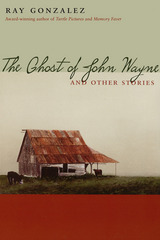 The Ghost of John Wayne: and Other Stories
Ray Gonzalez
University of Arizona Press, 2001 The vast Texas borderland is a place divided, a land of legends and lies, sanctification and sinfulness, history and amnesia, haunted by the ghosts of the oppressed and the forgotten, who still stir beneath the parched fields and shimmering blacktops. It is a realm filled with scorpion eaters and mescal drinkers, cowboys and Indians, Anglos and Chicanos, spirit horses and beat-up pickups, brujos and putas, aching passion and seething rage, apparitions of the Virgin and bodies in the Rio Grande. In his first collection of short fiction, award-winning poet, editor, and anthologist Ray Gonzalez powerfully evokes both the mystery and the reality of the El Paso border country where he came to manhood. Here, in a riverbed filled with junked cars and old bones, a young boy is given a dark vision of a fiery future. Under the stones of the Alamo, amid the gift shops and tour buses, the wraiths of fallen soldiers cry out to be remembered. By an ancient burial site at the bottom of a hidden canyon, two lovers come face to face with their own dreams and fears. In these stories, Ray Gonzalez is a literary alchemist, blending contemporary culture with ancient tradition to give a new voice to the peoples of the border.
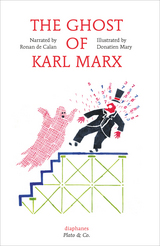 The Ghost of Karl Marx
Ronan de Calan and Donatien Mary
Diaphanes, 2015 At its most basic, philosophy is about learning how to think about the world around us. It should come as no surprise, then, that children make excellent philosophers! Naturally inquisitive, pint-size scholars need little prompting before being willing to consider life’s “big questions,” however strange or impractical. Plato & Co. introduces children—and curious grown-ups—to the lives and work of famous philosophers, from Descartes to Socrates, Einstein, Marx, and Wittgenstein. Each book in the series features an engaging—and often funny—story that presents basic tenets of philosophical thought alongside vibrant color illustrations.
In The Ghost of Karl Marx, the philosopher is saddened when the town weavers must sell their cloth cheaply to compete with machines. The farmers too cannot sell their crops and have no money to buy new seeds. Forced to leave their work, the townspeople form an angry crowd in front of the factories, but what is to be done when there are so many hungry people and so few jobs to pay for food to eat? Concealed in one of the weavers’ sheets, the philosopher makes a solemn vow to give this story a happy ending by finding the Market, that infernal magician, and ridding the town of him once and for all.
Plato & Co.’s clear approach and charming illustrations make this series the perfect addition to any little library.
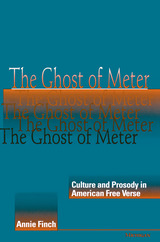 The Ghost of Meter: Culture and Prosody in American Free Verse
Annie Finch
University of Michigan Press, 2000 The Ghost of Meter: Culture and Prosody in American Free Verse provides a new strategy for interpreting the ways in which metrical patterns contribute to the meaning of poems. Annie Finch puts forth the theory of "the metrical code," a way of tracing the changing cultural connotations of metered verse, especially iambic pentameter. By applying the code to specific poems, the author is able to analyze a writer's relation to literary history and to trace the evolution of modern and contemporary poetries from the forms that precede them. Poet, translator, and critic Annie Finch is director of the Stonecoast low-residency MFA program at the University of Southern Maine. She is co-editor, with Kathrine Varnes, of An Exaltation of Forms: Contemporary Poets Celebrate the Diversity of Their Art, and author of Calendars. She is the winner of the eleventh annual Robert Fitzgerald Prosody Award for scholars who have made a lasting contribution to the art and science of versification.
Author bio:
Annie Finch, poet, editor, and critic, has published twenty books of poetry and poetics including Spells: New and Selected Poems, The Body of Poetry: Essays on Women, Form, and the Poetic Self, An Exaltation of Forms: Contemporary Poets Celebrate the Diversity of Their Art, A Poet's Craft: A Comprehensive Guide to Making and Sharing Your Poetry, and The Ghost of Meter: Culture and Prosody in American Free Verse. Based in New York, Dr. Finch travels widely to teach and perform her poetry and is the founder of PoetryWitchCommunity.org, where she teaches poetry, meter, and more. She is the winner of the eleventh annual Robert Fitzgerald Prosody Award for scholars who have made a lasting contribution to the art and science of versification.
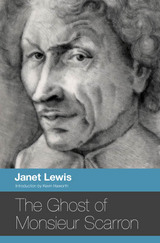 The Ghost of Monsieur Scarron
Janet Lewis
Ohio University Press, 2013 This historical novel is the third and final book in American poet and fiction writer Janet Lewis’s Cases of Circumstantial Evidence series, based on legal case studies compiled in the nineteenth century. In The Ghost of Monsieur Scarron, Lewis returns to her beloved France, the setting of The Wife of Martin Guerre, her best-known novel and the first in the series. As Swallow Press executive editor Kevin Haworth relates in a new introduction, Monsieur Scarron shifts the reader into the center of Paris in 1694, during the turbulent reign of the Sun King, Louis XIV. The junction of this time and place gives Monsieur Scarron an intriguing political element not apparent in either The Wife of Martin Guerre or The Trial of Sören Qvist. The Ghost of Monsieur Scarron begins in a small bookbinder’s shop on a modest Paris street, but inexorably expands to encompass a tumultuous affair, growing social unrest, and the conflicts between a legal system based on oppressive order and a society about to undergo harsh changes. With its domestic drama set against a larger political and historical backdrop, Monsieur Scarron is considered by some critics and readers to be the most intricately layered and fully realized book of Lewis’s long career. Originally published in 1959, Monsieur Scarron has remained in print almost continuously ever since.
The Ghost of Namamugi: Charles Lenox Richardson and the Anglo-Satsuma War
Robert Fletcher
Amsterdam University Press, 2019 In 1862, a British merchant was killed by samurai at Namamugi, a quiet village near Yokohama. One year later, a British fleet bombarded Kagoshima to extract reparations, reducing much of this south-western city to ash. This captivating re-telling, locates the story firmly within the wider context of British imperial expansion in East Asia.
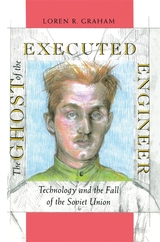 The Ghost of the Executed Engineer: Technology and the Fall of the Soviet Union
Loren Graham
Harvard University Press, 1993 Stalin ordered his execution, but here Peter Palchinsky has the last word. As if rising from an uneasy grave, Palchinsky’s ghost leads us through the miasma of Soviet technology and industry, pointing out the mistakes he condemned in his time, the corruption and collapse he predicted, the ultimate price paid for silencing those who were not afraid to speak out. The story of this visionary engineer’s life and work, as Loren Graham relates it, is also the story of the Soviet Union’s industrial promise and failure.
We meet Palchinsky in pre-Revolutionary Russia, immersed in protests against the miserable lot of laborers in the tsarist state, protests destined to echo ironically during the Soviet worker’s paradise. Exiled from the country, pardoned and welcomed back at the outbreak of World War I, the engineer joined the ranks of the Revolutionary government, only to find it no more open to criticism than the previous regime. His turbulent career offers us a window on debates over industrialization. Graham highlights the harsh irrationalities built into the Soviet system—the world’s most inefficient steel mill in Magnitogorsk, the gigantic and ill-conceived hydroelectric plant on the Dnieper River, the infamously cruel and mislocated construction of the White Sea Canal. Time and again, we see the effects of policies that ignore not only the workers’ and consumers’ needs but also sound management and engineering precepts. And we see Palchinsky’s criticism and advice, persistently given, consistently ignored, continue to haunt the Soviet Union right up to its dissolution in 1991.
The story of a man whose gifts and character set him in the path of history, The Ghost of the Executed Engineer is also a cautionary tale about the fate of an engineering that disregards social and human issues.
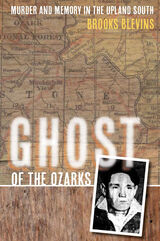 Ghost of the Ozarks: Murder and Memory in the Upland South
Brooks Blevins
University of Illinois Press, 2012 In 1929, in a remote county of the Arkansas Ozarks, the gruesome murder of harmonica-playing drifter Connie Franklin and the brutal rape of his teenaged fiancée captured the attention of a nation on the cusp of the Great Depression. National press from coast to coast ran stories of the sensational exploits of night-riding moonshiners, powerful "Barons of the Hills," and a world of feudal oppression in the isolation of the rugged Ozarks. The ensuing arrest of five local men for both crimes and the confusion and superstition surrounding the trial and conviction gave Stone County a dubious and short-lived notoriety. Closely examining how the story and its regional setting were interpreted by the media, Brooks Blevins recounts the gripping events of the murder investigation and trial, where a man claiming to be the murder victim--the "Ghost" of the Ozarks--appeared to testify. Local conditions in Stone County, which had no electricity and only one long-distance telephone line, frustrated the dozen or more reporters who found their way to the rural Ozarks, and the developments following the arrests often prompted reporters' caricatures of the region: accusations of imposture and insanity, revelations of hidden pasts and assumed names, and threats of widespread violence. Locating the past squarely within the major currents of American history, Ghost of the Ozarks: Murder and Memory in the Upland South paints a convincing backdrop to a story that, more than 80 years later, remains riddled with mystery.
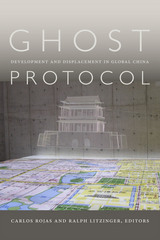 Ghost Protocol: Development and Displacement in Global China
Carlos Rojas and Ralph A. Litzinger, editors
Duke University Press, 2016 Even as China is central to the contemporary global economy, its socialist past continues to shape its capitalist present. This volume's contributors see contemporary China as haunted by the promises of capitalism, the institutional legacy of the Maoist regime, and the spirit of Marxist resistance. China's development does not result from historical imperatives or deliberate economic strategies, but from the effects of discrete practices the contributors call protocols, which stem from an overlapping mix of socialist and capitalist institutional strategies, political procedures, legal regulations, religious rituals, and everyday practices. Analyzing the process of urbanization and the ways marginalized communities and migrant workers are positioned in relation to the transforming social landscape, the contributors show how these protocols constitute the Chinese national imaginary while opening spaces for new emancipatory possibilities. Offering a nuanced theory of contemporary China's hybrid political economy, Ghost Protocol situates China's development at the juncture between the world as experienced and the world as imagined.
Contributors. Yomi Braester, Alexander Des Forges, Kabzung, Rachel Leng, Ralph A. Litzinger, Lisa Rofel, Carlos Rojas, Bryan Tilt, Robin Visser, Biao Xiang, Emily T. Yeh
 Ghost Ranch
Lesley Poling-Kempes
University of Arizona Press, 2005 For more than a century, Ghost Ranch has attracted people of enormous energy and creativity to the high desert of northern New Mexico. Occupying twenty-two thousand acres of the Piedra Lumbre basin, this fabled place was the love of artist Georgia O’Keeffe’s life, and her depictions of the landscape catapulted Ghost Ranch to international recognition.
Building on the history of the Abiquiu region that she told in Valley of Shining Stone, Ghost Ranch historian Lesley Poling-Kempes now unfolds the story of this celebrated retreat. She traces its transformation from el Rancho de los Brujos, a hideout for legendary outlaws, to a renowned cultural mecca and one of the Southwest’s premier conference centers.
First a dude ranch, Ghost Ranch became a magical sanctuary where the veil between heaven and earth seemed almost transparent. Focusing on those who visited from the 1920s and ’30s until the 1990s, Poling-Kempes tells how O’Keeffe and others—from Boston Brahmin Carol Bishop Stanley to paleontologist Edwin H. Colbert, Los Alamos physicists to movie stars—created a unique community that evolved into the institution that is Ghost Ranch today. For this book, Poling-Kempes has drawn on information not available when Valley of Shining Stone was written. The biography of Juan de Dios Gallegos has been enhanced and definitively corrected. The Robert Wood Johnson (of Johnson & Johnson) years at Ghost Ranch are recounted with reminiscences from family members. And the memories of David McAlpin Jr. shed light on how the Princeton circle that included the Packs, the Johnson brothers, the Rockefellers, and the McAlpins ended up as summer neighbors on the high desert of New Mexico.
After Arthur Pack’s gift of the ranch to the Presbyterian Church in 1955, Ghost Ranch became a spiritual home for thousands of people still awestruck by the landscape that O’Keeffe so lovingly committed to canvas; yet the care taken to protect Ghost Ranch’s land and character has preserved its sense of intimacy. By relating its remarkable story, Poling-Kempes invites all visitors to better appreciate its place as an honored wilderness—and to help safeguard its future.
 Ghost Riders of Baghdad: Soldiers, Civilians, and the Myth of the Surge
Daniel A. Sjursen
University Press of New England, 2015 From October 2006 to December 2007, Daniel A. Sjursen—then a U.S. Army lieutenant—led a light scout platoon across Baghdad. The experiences of Ghost Rider platoon provide a soldier’s-eye view of the incredible complexities of warfare, peacekeeping, and counterinsurgency in one of the world’s most ancient cities. Sjursen reflects broadly and critically on the prevailing narrative of the surge as savior of America’s longest war, on the overall military strategy in Iraq, and on U.S. relations with ordinary Iraqis. At a time when just a handful of U.S. senators and representatives have a family member in combat, Sjursen also writes movingly on questions of America’s patterns of national service. Who now serves and why? What connection does America’s professional army have to the broader society and culture? What is the price we pay for abandoning the model of the citizen soldier? With the bloody emergence of ISIS in 2014, Iraq and its beleaguered, battle-scarred people are again much in the news. Unlike other books on the U.S. war in Iraq, Ghost Riders of Baghdad is part battlefield chronicle, part critique of American military strategy and policy, and part appreciation of Iraq and its people. At once a military memoir, history, and cultural commentary, Ghost Riders of Bahdad delivers a compelling story and a deep appreciation of both those who serve and the civilians they strive to protect. Sjursen provides a riveting addition to our understanding of modern warfare and its human costs.
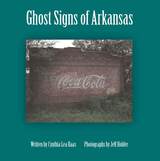 Ghost Signs of Arkansas
Cynthia Haas
University of Arkansas Press, 1997 From the late 1800s to the early 1950s, painted wall signs were a major mode of advertisement for both national companies and local businesses across America. Many of these artistic messages, now faded, peeling, and partially covered, still peek out from the storefronts, barns, alleyways, warehouses, theaters, and even stagecoach stops they once decorated. Photographer Jeff Holder and author Cynthia Haas explore this often overlooked art form in Arkansas and show us signs that appear mysteriously in the rain, signs that are curiously painted in remote places, images and words now only half decipherable. From Coca-Cola, Dr. Pepper, and Grapette Soda to Kis-Me-Gum, Uneeda Biscuit, and Snowdrift Flour, the logos and slogans are at once familiar and enigmatic. Archival photographs reference the time
when these brightly colored messages covered the facades of downtown buildings. Of particular interest in this book are the profiles of three “wall dogs,” or sign painters, who remember the difficulties and joys of their unusual profession. Ghost Signs of Arkansas ties us to a gentler past, a time when Main Street was the center of a community’s life, before mass media forced grand-scale advertising from brick walls to the television screen. In documenting a fading but valuable traditional art form, this book fills a gap in both the cultural fabric of Arkansas towns and the history of American art.
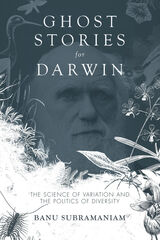 Ghost Stories for Darwin: The Science of Variation and the Politics of Diversity
Banu Subramaniam
University of Illinois Press, 2014 In a stimulating interchange between feminist studies and biology, Banu Subramaniam explores how her dissertation on flower color variation in morning glories launched her on an intellectual odyssey that engaged the feminist studies of sciences in the experimental practices of science by tracing the central and critical idea of variation in biology. Subramaniam reveals the histories of eugenics and genetics and their impact on the metaphorical understandings of difference and diversity that permeate common understandings of differences among people exist in contexts that seem distant from the so-called objective hard sciences. Journeying into interdisciplinary areas that range from the social history of plants to speculative fiction, Subramaniam uncovers key relationships between the life sciences, women's studies, evolutionary and invasive biology, and the history of ecology, and how ideas of diversity and difference emerged and persist in each field.
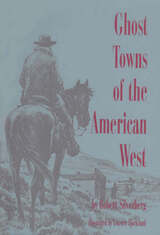 Ghost Towns of the American West
Robert Silverberg
Ohio University Press, 1990 The story of the American mining frontier can be traced through the ghost towns that dot the western landscape to this day, from the camps of California’s forty-niners to the twentieth-century ruins in the Nevada desert. These abandoned towns mark an epoch of high adventure, of quick wealth and quicker poverty, of gambling and gunslinging and hell-raising. Those who have seen the Old West movies sometimes think that the legends of the Wild West were invented by screenwriters. The ghost towns remain, and their battered ruins testify that the legends are true. Behind the tall tales is a history where a fortune could be made in a week and lost over the course of an evening. With a historian’s attention to fact and a novelist’s gift for dramatic storytelling, celebrated science fiction author Robert Silverberg brings these adventures back to life in the rowdy splendor of their heyday in Ghost Towns of the American West. History and travelers’ tales are woven together with clarity and wit to create a lively account of a fascinating era in our history. Lorence Bjorklund’s illustrations, rich in detail, portray the ghost towns in their glory and in their dusty decline.
 Ghost Towns of the American West
Robert Silverberg
Ohio University Press, 1990 The story of the American mining frontier can be traced through the ghost towns that dot the western landscape to this day, from the camps of California’s forty-niners to the twentieth-century ruins in the Nevada desert. These abandoned towns mark an epoch of high adventure, of quick wealth and quicker poverty, of gambling and gunslinging and hell-raising. Those who have seen the Old West movies sometimes think that the legends of the Wild West were invented by screenwriters. The ghost towns remain, and their battered ruins testify that the legends are true. Behind the tall tales is a history where a fortune could be made in a week and lost over the course of an evening. With a historian’s attention to fact and a novelist’s gift for dramatic storytelling, celebrated science fiction author Robert Silverberg brings these adventures back to life in the rowdy splendor of their heyday in Ghost Towns of the American West. History and travelers’ tales are woven together with clarity and wit to create a lively account of a fascinating era in our history. Lorence Bjorklund’s illustrations, rich in detail, portray the ghost towns in their glory and in their dusty decline.
 The Ghost Trio
Clyde Derrick
Omnidawn, 2022 A story set in Prague that crosses the lines between the living and the dead.
The great love of your life is dead, but that doesn’t stop him from communicating with you—or luring you to join him in the afterlife. To remain safe in this world, you accept the help of a professional medium who develops his own emotional agenda.
The Ghost Trio that emerges takes us to pre- and post-World War II Prague where a poignant and chilling love triangle finds its resolution. There we meet great Czech creators of the past including Leoš Janácek and Karel Capek. Inspired by the ghost stories of Henry James and Daphne du Maurier, Clyde Derrick introduces three characters whose passions defy time and the accepted boundaries between the dead and the living. The author, who has lived in and visited purportedly haunted sites in advance of writing this novella, contends that this story and its characters found him. Meanwhile, his portrayal of two Pragues—one poised to fall to Hitler’s army, the other muted by Communist oppression—offers us insights into the past and reminds us to stay vigilant against dangerous politics. The Ghost Trio is a spiritual excursion in which we ponder the limitations and hazards of romantic love as well as the possibility of other lives in other times.
The Ghost Trio is the winner of the 2020 Omnidawn Fabulist Fiction Chapbook / Novelette Contest, chosen by Molly Gloss.
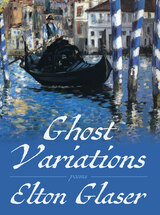 Ghost Variations: Poems
Elton Glaser
University of Pittsburgh Press, 2023 Intensely Emotional and Bitingly Witty Poems about Grief, Family, and Joy
Elton Glaser’s ninth book of poems is haunted by the loss of his wife, each April bringing back the memory of her death. The opening line confesses the struggle to find a language for this grief: “I’m learning to speak in the accents of adieu.” As the book progresses through the seasons, it evokes the places that remind him of their times together, in the South of their youths, in the Midwest of their long marriage, and in their travels here and abroad. And yet there is also another strain that keeps breaking through, the particulars of joy in family and the natural world, grandsons and “swaggering lilies,” and a swan like “a sullen bride in her white finery.” With an irrepressible wit and a music that enlivens his lines in both celebration and elegy, Glaser never forgets that, as Wallace Stevens said, “Memory without passion would be better lost.”
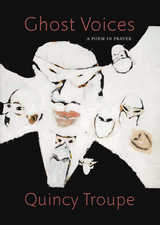 Ghost Voices: A Poem in Prayer
Quincy Troupe
Northwestern University Press, 2019 If we were all brave enough to resurrect the voices lost from our humanity, what would they say? Award-winning poet Quincy Troupe, spokesman for the humanizing forces of poetry, music, and art, parts the Atlantic and rattles the ground built on slavery with Ghost Voices: A Poem in Prayer.
we are crossing, / we are / crossing, / we are crossing in big salt water, // we are crossing, // crossing under a sky of no guilt / we have left home // though we know we will go back / someday, / see our people / as we knew them . . .
Troupe re-creates the history of lost voices between the waters of Africa, Cuba, and the United States. His daring poetics drenched in new forms-notably the seven-elevens-clench transformative narratives spurred on by a relentless, rhythmic language that mimics the foaming waves of the Atlantic Ocean and the Caribbean Sea. His personae speak quantum litanies within one epic, sermonic-gospel to articulate our most ancient ways of storytelling and survival.
Ghostbodies: Towards a New Theory of Invalidism
Maia Dolphin-Krute
Intellect Books, 2017 How is illness represented in today’s cultural texts? In Ghostbodies, Maia Dolphin-Krute argues that the illusive sick body is often made invisible—a ghost—because it does not always fit society’s definition of disability. In these pages, she reflectively engages in a philosophical discussion of the lived experience of illness alongside an examination of how language and cultural constructions influence and represent this experience in a variety of forms. The book provides a linguistic mirror through which the reader may see his or her own specific invalidity reflected, enabling an examination of what it is like to live within a ghostbody. In the end, Dolphin-Krute asks—if illness is not what it seems, what then is health?
 Ghostlife of Third Cinema: Asian American Film and Video
Glen M. Mimura
University of Minnesota Press, 2009 An interpretive history of Asian American independent media since the 1960s Asian American filmmakers and video artists have created a substantial, diverse, and challenging body of work that reimagines the cultural and political representation of Asian Americans. Yet much of this work remains unknown. For Glen M. Mimura, Asian American cinema is the spectral, ghostly return of the international film movement known as Third Cinema. Tracing contemporary Asian American cinema as a continuation of Third Cinema’s radical enterprise of making marginalized subjects visible in the First World, Ghostlife of Third Cinema examines such potent issues as diasporic identity, historical memory, and queer sexuality through sophisticated readings of a wide range of film and video projects, including Trinh T. Minh-ha’s experimental documentary Surname Viet Given Name Nam; avant-garde works by Japanese American filmmakers Rea Tajiri, Lise Yasui, and Janice Tanaka; and queer videos exploring the intersection of race, nation, and sexuality by Pablo Bautista, Ming-Yuen Ma, and Nguyen Tan Hoang. In Ghostlife of Third Cinema, Mimura confronts the ongoing erasure of Asian American independent media andilluminates its cultural and political significance today.
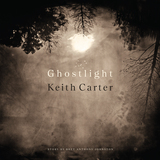 Ghostlight
Photographs by Keith CarterStory by Bret Anthony Johnston
University of Texas Press, 2022 A collection of otherworldly photographs of Southern wetlands featuring an original ghost story.
Southern wetlands, with their moss-draped trees and dark water obscuring mysteries below, are eerily beautiful places, home to ghost stories and haunting, ethereal light. The newest collection from award-winning photographer Keith Carter, Ghostlight captures the otherwordly spirits of swamps, marshes, bogs, baygalls, bayous, and fens in more than a hundred photographs. From Ossabaw Island, Georgia, to his home ground of East Texas, Carter seeks “the secretive and mysterious” of this often-overlooked landscape: wisps of fog drifting between tree branches; faceless figures contemplating a bog; owls staring directly at the camera lens; infinite paths leading to unknown parts. Similarly, spectral images are evoked in the original short story that opens this book. Ghostlight, writes best-selling author Bret Anthony Johnston, “hovers, darts, disappears. It can be as mean as a cottonmouth, as mischievous aes a child. The closer you get, the farther the light recedes.” A masterpiece of “Bayou Gothic,” Ghostlight challenges our perceptions and invites us to experience the beauty of this elusive world.
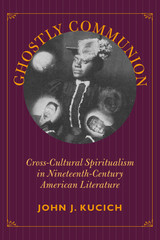 Ghostly Communion: Cross-Cultural Spiritualism in Nineteenth-Century American Literature
John J. Kucich
Dartmouth College Press, 2015 In this exceptional book, Kucich reveals through his readings of literary and historical accounts that spiritualism helped shape the terms by which Native American, European, and African cultures interacted in America from the earliest days of contact through the present. Beginning his study with a provocative juxtaposition of the Pueblo Indian Revolt and the Salem Witchcraft trials of the seventeenth century, Kucich examin[e]s how both events forged “contact zones”— spaces of intense cultural conflict and negotiation—mediated by spiritualism. Kucich goes on to chronicle how a diverse group of writers used spiritualism to reshape a range of such contact zones. These include Rochester, New York, where Harriet Jacobs adapted the spirit rappings of the Fox Sisters and the abolitionist writings of Frederick Douglass as she crafted her own story of escape from slavery; mid-century periodicals from the Atlantic Monthly to the Cherokee Advocate to the Anglo-African Magazine; post-bellum representations of the afterlife by Elizabeth Stuart Phelps, Mark Twain and the Native Americans who developed the Ghost Dance; turn-of-the-century local color fiction by writers like Sarah Orne Jewett, Charles Chesnutt and Maria Cristina Mena; and the New England reformist circles traced in Henry James’s The Bostonians and Pauline Hopkins’s Of One Blood. Kucich’s conclusion looks briefly at New Age spiritualism, then considers the implications of a cross-cultural scholarship that draws on a variety of critical methodologies, from border and ethnic studies to feminism to post-colonialism and the public sphere. The implications of this study, which brings well-known, canonical writers and lesser-known writers into conversation with one another, are broadly relevant to the resurgent interest in religious studies and American cultural studies in general.
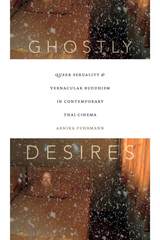 Ghostly Desires: Queer Sexuality and Vernacular Buddhism in Contemporary Thai Cinema
Arnika Fuhrmann
Duke University Press, 2016 Through an examination of post-1997 Thai cinema and video art Arnika Fuhrmann shows how vernacular Buddhist tenets, stories, and images combine with sexual politics in figuring current struggles over notions of personhood, sexuality, and collective life. The drama, horror, heritage, and experimental art films she analyzes draw on Buddhist-informed conceptions of impermanence and prominently feature the motif of the female ghost. In these films the characters' eroticization in the spheres of loss and death represents an improvisation on the Buddhist disavowal of attachment and highlights under-recognized female and queer desire and persistence. Her feminist and queer readings reveal the entangled relationships between film, sexuality, Buddhist ideas, and the Thai state's regulation of heteronormative sexuality. Fuhrmann thereby provides insights into the configuration of contemporary Thailand while opening up new possibilities for thinking about queer personhood and femininity.
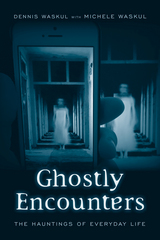 Ghostly Encounters: The Hauntings of Everyday Life
Dennis Waskul
Temple University Press, 2016 “In the top corner of the window a pale, milky-white wisp is rising almost to the top of our ten-foot ceiling…. I am startled but not afraid…. Mostly, I am engrossed; I have never seen anything like this before (or since) and it fascinates me.” Dennis Waskul writes these lines—about his first-hand experience with the supernatural—in the introduction to his beguiling book Ghostly Encounters. Based on two years of fieldwork and interviews with 71 midwestern Americans, the Waskuls’ book is a reflexive ethnography that examines how people experience ghosts and hauntings in everyday life. The authors explore how uncanny happenings become ghosts, and the reasons people struggle with or against a will to believe. They present the variety and character of hauntings and ghostly encounters, outcomes of people telling haunted legends, and the nested consequences of ghostly experiences. Through these stories, Ghostly Encounters seeks to understand the persistence of uncanny experiences and beliefs in ghosts in an age of reason, science, education, and technology—as well as how those beliefs and experiences both reflect and serve important social and cultural functions.
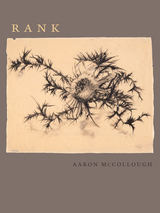 Ghostly Figures: Memory and Belatedness in Postwar American Poetry
Ann Keniston
University of Iowa Press, 2015 From Sylvia Plath’s depictions of the Holocaust as a group of noncohering “bits” to AIDS elegies’ assertions that the dead posthumously persist in ghostly form and Susan Howe’s insistence that the past can be conveyed only through juxtaposed “scraps,” the condition of being too late is one that haunts post-World War II American poetry. This is a poetry saturated with temporal delay, partial recollection of the past, and the revelation that memory itself is accessible only in obstructed and manipulated ways. These postwar poems do not merely describe the condition of lateness: they enact it literally and figuratively by distorting chronology, boundary, and syntax, by referring to events indirectly, and by binding the condition of lateness to the impossibility of verifying the past. The speakers of these poems often indicate that they are too late by repetitively chronicling distorted events, refusing closure or resolution, and forging ghosts out of what once was tangible.
Ghostly Figures contends that this poetics of belatedness, along with the way it is bound to questions of poetic making, is a central, if critically neglected, force in postwar American poetry. Discussing works by Sylvia Plath, Adrienne Rich, Jorie Graham, Susan Howe, and a group of poets responding to the AIDS epidemic, Ann Keniston draws on and critically assesses trauma theory and psychoanalysis, as well as earlier discussions of witness, elegy, lyric trope and figure, postmodernism, allusion, and performance, to define the ghosts that clearly dramatize poetics of belatedness throughout the diverse poetry of post–World War II America.
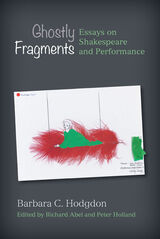 Ghostly Fragments: Essays on Shakespeare and Performance
Barbara C. Hodgdon
University of Michigan Press, 2021 Ghostly Fragments gathers the essays of the late Barbara C. Hodgdon, a renowned scholar of Shakespeare and performance studies. Her influential publications over thirty years reflected a remarkable intelligence, wit, and originality, as did her lectures and conference papers. Richard Abel and Peter Holland have selected essays that represent the wide sweep of Hodgdon’s scholarship, including unpublished pieces and those from hard-to-access sources. The essays reveal a thinker and writer who grows more self-reflective over time, with a distinctive, engaging, often wryly humorous voice that is accessible even to nonspecialist readers.
Following a general introduction by Peter Holland, the book’s five subsections (Teaching Shakespeare, Analyzing Stage Performances, Editing Shakespeare Texts, Analyzing Shakespeare Films, and “Shopping” in the Archives) are introduced in turn by scholars Miriam Gilbert, W.B. Worthen, Margaret Jane Kidnie, Richard Abel, and Pascale Aebischer. Collectively, the pieces confirm the originality and élan of Hodgdon’s thinking and writing over time, and reveal her as a natural essayist and stylist, with a distinctive engaging voice. The collection is unique in not only bringing together so much of Hodgdon's work in one place (with an extensive bibliography of her published work) but also in demonstrating how groundbreaking and influential that work has been in the field.
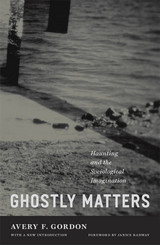 Ghostly Matters: Haunting and the Sociological Imagination
Avery F. Gordon
University of Minnesota Press, 2008 “Avery Gordon’s stunningly original and provocatively imaginative book explores the connections linking horror, history, and haunting. ” —George Lipsitz “The text is of great value to anyone working on issues pertaining to the fantastic and the uncanny.” —American Studies International “Ghostly Matters immediately establishes Avery Gordon as a leader among her generation of social and cultural theorists in all fields. The sheer beauty of her language enhances an intellectual brilliance so daunting that some readers will mark the day they first read this book. One must go back many more years than most of us can remember to find a more important book.” —Charles Lemert Drawing on a range of sources, including the fiction of Toni Morrison and Luisa Valenzuela (He Who Searches), Avery Gordon demonstrates that past or haunting social forces control present life in different and more complicated ways than most social analysts presume. Written with a power to match its subject, Ghostly Matters has advanced the way we look at the complex intersections of race, gender, and class as they traverse our lives in sharp relief and shadowy manifestations. Avery F. Gordon is professor of sociology at the University of California, Santa Barbara. Janice Radway is professor of literature at Duke University.
 Ghostly Past, Capitalist Presence: A Social History of Fear in Colonial Bengal
Tithi Bhattacharya
Duke University Press, 2024 In Ghostly Past, Capitalist Presence, Tithi Bhattacharya maps the role that Bengali ghosts and ghost stories played in constituting the modern Indian nation, and the religious ideas seeded therein, as it emerged in dialogue with European science. Bhattacharya introduces readers to the multifarious habits and personalities of Bengal’s traditional ghosts and investigates and mourns their eventual extermination. For Bhattacharya, British colonization marked a transition from the older, multifaith folk world of traditional ghosts to newer and more frightening specters. These "modern" Bengali ghosts, borne out of a new rationality, were homogeneous specters amenable to "scientific" speculation and invoked at séance sessions in elite drawing rooms. Reading literature alongside the colonial archive, Bhattacharya uncovers a new reordering of science and faith from the middle of the nineteenth century. She argues that these shifts cemented the authority of a rising upper-caste colonial elite who expelled the older ghosts in order to recast Hinduism as the conscience of the Indian nation. In so doing, Bhattacharya reveals how capitalism necessarily reshaped Bengal as part of the global colonial project.
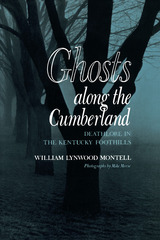 Ghosts along the Cumberland: Deathlore in the Kentucky Foothills
William Lynwood Montell
University of Tennessee Press, 1987 The lore of death and ghosts persists as a great vestige of the past in the eastern section of an area known as the Kentucky "Pennyroyal"—or, as longtime residents sometimes call it, the "Pennyrile." Located in the foothills of southcentral Kentucky near the Tennessee line, the Eastern Pennyroyal has produced a genuine folklore, handed down by generation after generation, that even today is manifested by beliefs in death omens and the recital of tales of the supernatural
This fascinating collection of ghost stories, tales of the supernatural, death beliefs and death sayings that remain as a vestige in this area were collected by Lynwood Montell and his students over the course of a decade.
"This unique and extremely valuable book adds considerably to the area of folklore studies in the United States. The material which Montell obtained in his field work is superb."
--Don Yoder.
"This book is to be recommended to both folklorists and those non-folklorists who read folklore for enjoyment alone. It makes an important contribution to the study of deathlore and, it is to be hoped, will draw added attention to this multi-generic subject area."
--David J. Hufford, Tennessee Folklore Society Bulletin.
"Professor Montell's book can well be viewed as a standard of excellence: a direct, articulate and cataloged approach for future study and implementation in the fields of folklore and oral history."
--Joan Perkal, Oral History Association Newsletter.
"The book gives fascinating accounts of death beliefs, death omens, folk beliefs associated with the dead, and in the major section, ghosts narratives. A fine combination of scholarship and chilling narration to be relished by firelight in an old deserted house in the hills."
--Book Forum.
"Professor Montell has arranged beliefs and experiences about death of a particular group of people in such a way that a whole new aspect of the people's lives comes to focus."
--Loyal Jones, The Filson Club HIstory Quarterly.
Ghosts and The Japanese: Cultural Experience in Japanese Death Legends
Michiko Iwasaka & Barre Toelken
Utah State University Press, 1994 The Japanese have ambivalent attitudes toward death, deeply rooted in pre-Buddhist traditions. In this scholarly but accessible work, authors Iwasaka and Toelken show that everyday beliefs and customs--particularly death traditions--offer special insight into the living culture of Japan.
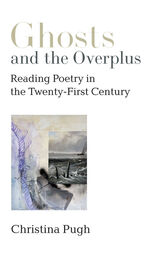 Ghosts and the Overplus: Reading Poetry in the Twenty-First Century
Christina Pugh
University of Michigan Press, 2024 Ghosts and the Overplus is a celebration of lyric poetry in the twenty-first century and how lyric poetry incorporates the voices of our age as well as the poetic “ghosts” from the past. Acclaimed poet and award-winning teacher Christina Pugh is fascinated by how poems continually look backward into literary history. Her essays find new resonance in poets ranging from Emily Dickinson to Gwendolyn Brooks to the poetry of the present. Some of these essays also consider the way that poetry interacts with the visual arts, dance, and the decision to live life as a nonconformist. This wide-ranging collection showcases the critical discussions around poetry that took place in America over the first two decades of our current millennium. Essay topics include poetic forms continually in migration, such as the sonnet; poetic borrowings across visual art and dance; and the idiosyncrasies of poets who lived their lives against the grain of literary celebrity and trend. What unites all of these essays is a drive to dig more deeply into the poetic word and act: to go beyond surface reading in order to reside longer with poems. In essays both discursive and personal, Pugh shows that poetry asks us to think differently—in a way that gathers feeling into the realm of thought, thereby opening the mysteries that reside in us and in the world around us.
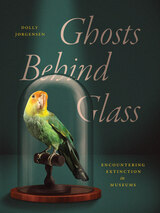 Ghosts Behind Glass: Encountering Extinction in Museums
Dolly Jørgensen
University of Chicago Press, 2025 How museums display extinct species—and what these exhibits say about us.
While it’s no longer possible to encounter a dodo in the wild, we can still come face-to-face with them in museums. The remains of extinct species—whether taxidermied, skeletal, drawn, or sculpted—stare back at us from display cases.
In this moving meditation on what’s lost and what endures, environmental historian Dolly Jørgensen visits natural history collections worldwide—from Shanghai to Philadelphia, from Edinburgh to Hobart, Australia—to understand the many ways that museums tell stories about extinction. She encounters extinct animals that are framed as cultural artifacts and as rare valuables, that are memorialized with lists, and that are brought to life through augmented reality. She draws our attention to creatures with prominent afterlives—passenger pigeons, giant moas, thylacines—as well as those that are less likely to be discussed or displayed. Throughout, Jørgensen examines the relationship between museums and the natural world, so readers can look more closely at exhibits about extinction, studying the displays for what is there, as well as what is missing. During a period of rapid species loss driven by humanity’s environmental impact, Ghosts Behind Glass asks what we can learn about our world from the presence of the extinct.
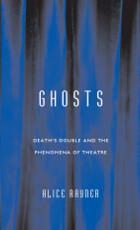 Ghosts: Death’S Double And The Phenomena Of Theatre
Alice Rayner
University of Minnesota Press, 2006 Making spirits visible has been a part of the theatrical experience since at least the sixteenth century. Instead of illusions, however, ghostly doubles in theatre are materially real and pervasive.
In Ghosts, Alice Rayner examines theatre as a memorial practice that is haunted by the presence of loss, looking at how aspects of stagecraft turn familiar elements into something uncanny. Citing examples from the works of Shakespeare, Beckett, and Suzan-Lori Parks as well as the films Vertigo, Gaslight, and The Sixth Sense, she begins by describing time as it is employed by theatre with multiple aspects of presence, duration, and passage. Suggesting that objects connect past to present through the sense of touch, she explores how props are suspended backstage between motion and meaning. Her final chapters consider the curtain as theatre’s means for attempting to divide real and imaginary worlds.
If ghosts hover where secrets—secrets of the past, secrets from oneself, secrets of life and death—are kept, then, according to Rayner, “theatre is where ghosts best make their appearances and let communities and individuals know that we live amid secrets hiding in plain sight.”
Alice Rayner is associate professor of drama at Stanford University and author of, most recently, To Act, To Do, To Perform: Drama and the Phenomenology of Action.
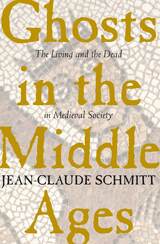 Ghosts in the Middle Ages: The Living and the Dead in Medieval Society
Jean-Claude Schmitt
University of Chicago Press, 1998 Through this vivid study, Jean-Claude Schmitt examines medieval religious culture and the significance of the widespread belief in ghosts, revealing the ways in which the dead and the living related to each other during the middle ages. Schmitt also discusses Augustine's influence on medieval authors; the link between dreams and autobiographical narratives; and monastic visions and folklore. Including numerous color reproductions of ghosts and ghostly trappings, this book presents a unique and intriguing look at medieval culture.
"Valuable and highly readable. . . . [Ghosts in the Middle Ages] will be of interest to many students of medieval thought and culture, but especially to those seeking a general overview of this particularly conspicuous aspect of the medieval remembrance of the dead."—Hans Peter Broedel, Medieval Review
"A fascinating study of the growing prevalence of ghost imagery in ecclesiastical and popular writing from the fifth to the fifteenth century."—Choice
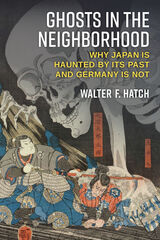 Ghosts in the Neighborhood: Why Japan Is Haunted by Its Past and Germany Is Not
Walter F. Hatch
University of Michigan Press, 2023 Germany, which brutalized its neighbors in Europe for centuries, has mostly escaped the ghosts of the past, while Japan remains haunted in Asia. The most common explanation for this difference is that Germany knows better how to apologize; Japan is viewed as “impenitent.” Walter F. Hatch rejects the conventional wisdom and argues that Germany has achieved reconciliation with neighbors by showing that it can be a trustworthy partner in regional institutions like the European Union and NATO; Japan has never been given that opportunity (by its dominant partner, the U.S.) to demonstrate such an ability to cooperate. This book rigorously defends the argument that political cooperation—not discourse or economic exchange—best explains Germany’s relative success and Japan’s relative failure in achieving reconciliation with neighbors brutalized by each regional power in the past. It uses paired case studies (Germany-France and Japan-South Korea; Germany-Poland and Japan-China) to gauge the effect of these competing variables on public opinion over time. With numerous charts, each of the four empirical chapters illustrates the powerful causal relationship between institution building and interstate reconciliation.
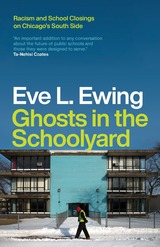 Ghosts in the Schoolyard: Racism and School Closings on Chicago's South Side
Eve L. Ewing
University of Chicago Press, 2018 “Failing schools. Underprivileged schools. Just plain bad schools.”
That’s how Eve L. Ewing opens Ghosts in the Schoolyard: describing Chicago Public Schools from the outside. The way politicians and pundits and parents of kids who attend other schools talk about them, with a mix of pity and contempt.
But Ewing knows Chicago Public Schools from the inside: as a student, then a teacher, and now a scholar who studies them. And that perspective has shown her that public schools are not buildings full of failures—they’re an integral part of their neighborhoods, at the heart of their communities, storehouses of history and memory that bring people together.
Never was that role more apparent than in 2013 when Mayor Rahm Emanuel announced an unprecedented wave of school closings. Pitched simultaneously as a solution to a budget problem, a response to declining enrollments, and a chance to purge bad schools that were dragging down the whole system, the plan was met with a roar of protest from parents, students, and teachers. But if these schools were so bad, why did people care so much about keeping them open, to the point that some would even go on a hunger strike?
Ewing’s answer begins with a story of systemic racism, inequality, bad faith, and distrust that stretches deep into Chicago history. Rooting her exploration in the historic African American neighborhood of Bronzeville, Ewing reveals that this issue is about much more than just schools. Black communities see the closing of their schools—schools that are certainly less than perfect but that are theirs—as one more in a long line of racist policies. The fight to keep them open is yet another front in the ongoing struggle of black people in America to build successful lives and achieve true self-determination.
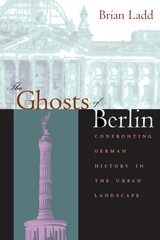 The Ghosts of Berlin: Confronting German History in the Urban Landscape
Brian Ladd
University of Chicago Press, 1997 In this compelling work, Brian Ladd examines the ongoing conflicts radiating from the remarkable fusion of architecture, history, and national identity in Berlin. Ladd surveys the urban landscape, excavating its ruins, contemplating its buildings and memorials, and carefully deconstructing the public debates and political controversies emerging from its past.
"Written in a clear and elegant style, The Ghosts of Berlin is not just another colorless architectural history of the German capital. . . . Mr. Ladd's book is a superb guide to this process of urban self-definition, both past and present."—Katharina Thote, Wall Street Journal
"If a book can have the power to change a public debate, then The Ghosts of Berlin is such a book. Among the many new books about Berlin that I have read, Brian Ladd's is certainly the most impressive. . . . Ladd's approach also owes its success to the fact that he is a good storyteller. His history of Berlin's architectural successes and failures reads entertainingly like a detective novel."—Peter Schneider, New Republic
"[Ladd's] well-written and well-illustrated book amounts to a brief history of the city as well as a guide to its landscape."—Anthony Grafton, New York Review of Books
The Ghosts of Berlin: Confronting German History in the Urban Landscape
Brian Ladd
University of Chicago Press, 2018 In the twenty years since its original publication, The Ghosts of Berlin has become a classic, an unparalleled guide to understanding the presence of history in our built environment, especially in a space as historically contested—and emotionally fraught—as Berlin. Brian Ladd examines the ongoing conflicts radiating from the remarkable fusion of architecture, history, and national identity in Berlin. Returning to the city frequently, Ladd continues to survey the urban landscape, traversing its ruins, contemplating its buildings and memorials, and carefully deconstructing the public debates and political controversies emerging from its past.
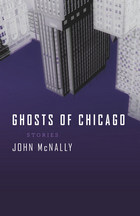 Ghosts of Chicago: Stories
John McNally
Northwestern University Press, 2010 Chicago is famously a "city of neighborhoods" that somehow balances metropolitan and parochial life. In the seventeen vividly rendered stories in Ghosts of Chicago, John McNally likewise captures the poignancy of both the shared experiences of a city and the interior details of his everyday characters.While McNally resurrects Chicago icons and institutions—including John Belushi, Walter Payton, and Richard J. Daley make appearances, and WGN’s "Creature Features" and a morning show for children featuring a silent goose are settings-- he is ultimately interested in the human condition, whether it’s railroad mogul George Pullman remembering his greatest triumph or the host of Romper Room experiencing her own awakening during the sexual revolution.Other stories tell of everyday people who must confront their own private ghosts—an accountant who falls in love with a woman who is in love with a man on death row; the son of a realtor who discovers his father’s secret life; a memoirist whose dark night of the soul leads him on a journey from which he may never return.McNally may be writing about Chicago—in the words of a Chicago Sun-Times reviewer, "He may have physically left Chicago, but the city has never left him"—but like Faulkner’s Yoknapatawpha or Sherwood Anderson’s Winesburg, the stories in this book transcend place.
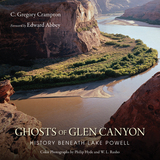 Ghosts of Glen Canyon: History beneath Lake Powell
C Gregory Crampton
University of Utah Press, 2009 Drift down the Colorado River through Glen Canyon and explore the people and places that encompass the history of this majestic canyon before it drowned in the rising waters of Lake Powell.
Author Gregory Crampton led the historical investigations of Glen and San Juan Canyons from 1957 to 1963 under contract with the National Park Service. The objective was to locate and record historical sites that would be lost to the rising waters of the reservoir. This book records that effort.
First published in 1986, this edition has been revised to include several new “ghosts” of Glen Canyon, including a never-before-published foreword by Edward Abbey. It also showcases stunning color photographs by Philip Hyde and includes hundreds of black-and-white photographs taken by the original salvage crews.
This informative guide to the historic treasures of Glen Canyon includes numbered maps keyed to each location. It is a book for both the armchair traveler and the lake enthusiast eager for a journey through the past to a place few had the privilege to know.
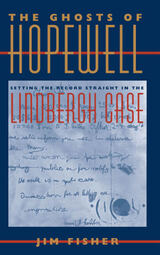 The Ghosts of Hopewell: Setting the Record Straight in the Lindberg Case
Jim Fisher
Southern Illinois University Press, 2006 In this illustrated examination of the Lindbergh kidnapping case, Jim Fisher seeks to set the record straight regarding Bruno Hauptmann's guilt in "the crime of the century." In February 1935, following a sensational, six-week trial, a jury in Flemington, New Jersey, found German carpenter Hauptmann guilty of kidnapping and murdering the twenty-month-old son of Charles and Anne Lindbergh. Although circumstantial, the evidence against Hauptmann—the handwriting on the ransom notes, the homemade kidnapping ladder, Colonel Lindbergh's money found in his garage, his matching the description of the man who accepted the ransom payoff in the Bronx cemetery, his inability to prove an alibi, and his incredible explanation of his possession of the ransom money—was overwhelming, leaving few to doubt his guilt. After a series of appeals and stays, Hauptmann died fourteen months later in the electric chair. A confession would have spared him the death sentence, but Hauptmann chose to die maintaining his innocence. It was not until the mid-1970s that revisionists began to challenge the conventional wisdom in the case: that Hauptmann was the lone killer. Revisionist books and articles appeared, as did plays, TV shows, and a movie, all portraying Hauptmann as the victim of a massive police and prosecution frame-up. At this point, the focus shifted from the evidence to the conduct of the police. By the 1980s, most people familiar with the case were convinced of Hauptmann's complete innocence. Many denied the murder, believing that the Lindbergh baby remained alive. Several men claimed to be the firstborn son of Charles and Anne Lindbergh, one of whom sued to claim his share of the Lindbergh estate after Charles Lindbergh's death in 1974. Another group held that the kidnapping was an elaborate hoax to cover up the murder of the baby by his parents. Anna Hauptmann¹s series of federal lawsuits against New Jersey and others in the mid-1980s fueled further interest in the case. Although Hauptmann's widow lost all of her lawsuits, she had won the hearts and minds of the American people before her death at the age of ninety-four. Former FBI agent Fisher discusses the hard evidence, such as the ransom notes and the wood of the kidnapping ladder. He analyzes and debunks the various revisionist theories and presents new evidence that, coupled with the undisputed facts, prove beyond a reasonable doubt that Hauptmann was guilty as charged: he kidnapped and murdered the infant son of Charles and Anne Lindbergh.
 The Ghosts of Mark Twain: A Study of Manhood, Race, and the Gothic Imagination
ANN M. RYAN
University of Missouri Press, 2025 In his autobiography, Mark Twain confesses that “from the cradle up I have been like the rest of the race—never quite sane in the night.” Of all the memories and fears that disturbed Twain’s peace of mind, none are more intractable than those associated with White fathers, Black men, the histories they reflect, and the future they promise. The Ghosts of Mark Twain: A Study of Manhood, Race, and the Gothic Imagination investigates these tense intersections in Twain’s life and work.
Ann M. Ryan maps Twain’s resistance to ideals of white masculinity and his occasional capitulation to them. While Twain reflects upon the history of White men—including the intimate memory of his father’s failures and abuses—he also imagines a future in which Black men will gain an authentic voice and agency. Preferring the messy humanity of Mark Twain, Ryan calls into question the “St. Mark” school of criticism, which glosses—among other themes—Twain’s uneasy relation to Black culture. In unpublished works and excised material, Twain conjures memories and specters of Black men that are far from comforting. No longer “friends and allies” like fictive Ol’ Uncle Dan’l; these Black ghosts will settle for revenge if they can’t get justice.
Some of the works considered in The Ghosts of Mark Twain are not widely known: “Which Was It?,” “The United States of Lyncherdom,” No. 44: The Mysterious Stranger, and the Morgan manuscript of Pudd’nhead Wilson. Written into the record of these fragments is Twain’s desire to be a different kind of White man, just as their incomplete nature demonstrates how often he stumbled in that effort. When Jim describes the White and Black spirits hovering over Pap Finn, Twain reveals his own conflicted position in America’s racial history. And as Jim declares to Huck, “A body can’t tell yit which one gwyne to fetch him at de las.’”
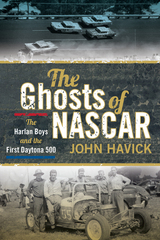 The Ghosts of NASCAR: The Harlan Boys and the First Daytona 500
John Havick
University of Iowa Press, 2013 Who won the first Daytona 500? Fans still debate whether it was midwestern champion Johnny Beauchamp, declared the victor at the finish line, or longtime NASCAR driver Lee Petty, declared the official winner a few days after the race. The Ghosts of NASCAR puts the controversial finish under a microscope. Author John Havick interviewed scores of people, analyzed film of the race, and pored over newspaper accounts of the event. He uses this information and his deep knowledge of the sport as it worked then to determine what probably happened. But he also tells a much bigger story: the story of how Johnny Beauchamp—and his Harlan, Iowa, compatriots, mechanic Dale Swanson and driver Tiny Lund—ended up in Florida driving in the 1959 Daytona race.
The Ghosts of NASCAR details how the Harlan Boys turned to racing cars to have fun and to escape the limited opportunities for poor boys in rural southwestern Iowa. As auto racing became more popular and better organized in the 1950s, Swanson, Lund, and Beauchamp battled dozens of rivals and came to dominate the sport in the Midwest. By the later part of the decade, the three men were ready to take on the competition in the South’s growing NASCAR circuit. One of the top mechanics of the day, Swanson literally wrote the book on race cars at Chevrolet’s clandestine racing shop in Atlanta, Georgia, while Beauchamp and Lund proved themselves worthy competitors. It all came to a head on the brand-new Daytona track in 1959.
The Harlan Boys’ long careers and midwestern racing in general have largely faded from memory. The Ghosts of NASCAR recaptures it all: how they negotiated the corners on dirt tracks and passed or spun out their opponents; how officials tore down cars after races to make sure they conformed to track rules; the mix of violence and camaraderie among fierce competitors; and the struggles to organize and regulate the sport. One of very few accounts of 1950s midwestern stock car racing, The Ghosts of NASCAR is told by a man who was there during the sport’s earliest days.
 Ghosts of New York
Jim Lewis
West Virginia University Press, 2021 *A NEW YORK TIMES NOTABLE BOOK OF THE YEAR*
“A wondrous novel, with prose that sparkles like certain sidewalks after rain. . . . That’s it, I thought. That’s exactly what it’s like to live in New York.” —New York Times Book Review
Ghosts of New York is a novel in which the laws of time and space have been subtly suspended. It interweaves four strands: a photographer newly returned to the neighborhood where she grew up, after years spent living overseas; a foundling raised on 14th Street; a graduate student, his romantic partner, and his best friend entangled in a set of relationships with far-reaching personal and political repercussions; and a shopkeeper suffering from first love late in life. Mixing prophecy, history, and a hint of speculative fiction, its stories are bound together even as they are propelled into stranger territory. And undergirding it all is a song, which appears, disappears, and then resurfaces.
Ghosts of New York explores complex lives through indelible renderings of settings—a bar, a night market, a recording studio—that alternate between familiar and unsettling. The work of a celebrated novelist and veteran of the art, film, and music scenes in New York and Austin (described as “a rare talent” by the New York Times and “a powerful literary voice” by Jeffrey Eugenides), this novel will immediately absorb readers intrigued by creative people and the places that sustain and challenge them.
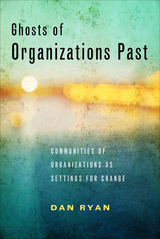 Ghosts of Organizations Past: Communities of Organizations as Settings for Change
Dan Ryan
Temple University Press, 2015 In Ghosts of Organizations Past, Dan Ryan asks, “Why are urban communities such hard places to implement community improvement programs?” Looking at New Haven, Connecticut, and a now-defunct program called Fighting Back, which was created to build community coalitions against the abuse of alcohol and other drugs, Ryan shows how the normal properties of organizations generate apparent pathologies. He shows how the “ghosts,” or artifacts, of past organizations, both inhibited and enhanced Fighting Back's chances of success.
Ryan draws on concepts from the study of organizations, social capital, and social networks to re-think questions such as “What kind of thing is a community?” and “Why is it so difficult to build community initiatives out of organizations?” He provides a social organizational explanation for problems familiar to anyone who has been involved in community programs, issues that are usually understood as personal incompetence, turf wars, greed, or corruption.
Ghosts of Organizations Past describes the challenges of using organizations to create change in places in dire need of it.
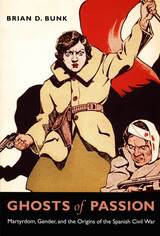 Ghosts of Passion: Martyrdom, Gender, and the Origins of the Spanish Civil War
Brian D. Bunk
Duke University Press, 2007 The question of what caused the Spanish Civil War (1936–39) is the central focus of modern Spanish historiography. In Ghosts of Passion, Brian D. Bunk argues that propaganda related to the revolution of October 1934 triggered the broader conflict by accentuating existing social tensions surrounding religion and gender. Through careful analysis of the images produced in books, newspapers, posters, rallies, and meetings, Bunk contends that Spain’s civil war was not inevitable. Commemorative imagery produced after October 1934 bridged the gap between rhetoric and action by dehumanizing opponents and encouraging violent action against them. In commemorating the uprising, revolutionaries and conservatives used the same methods to promote radically different political agendas: they deployed religious imagery to characterize the political situation as a battle between good and evil, with the fate of the nation hanging in the balance, and exploited traditional gender stereotypes to portray themselves as the defenders of social order against chaos. The resulting atmosphere of polarization combined with increasing political violence to plunge the country into civil war.
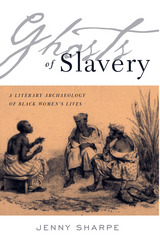 Ghosts Of Slavery: A Literary Archaeology of Black Women’s Lives
Jenny Sharpe
University of Minnesota Press, 2002 Questions traditional assumptions about power and agency in slave women’s everyday lives. Through their open defiance, women like Harriet Tubman and Sojourner Truth had a significant impact on the institution of slavery. But what of the countless other women who did not commit public or even private acts of resistance? Are their stories worthy of our attention? While some scholars imply that only the struggle for freedom was legitimate, Jenny Sharpe complicates the linear narrative-from slavery to freedom and literacy-that emerged from the privileging of autobiographical accounts like that of Frederick Douglass. She challenges a paradigm that equates agency with resistance and self-determination, and introduces new ways to examine negotiations for power within the constraints of slavery. In Ghosts of Slavery, Sharpe introduces a wider range of everyday practices by examining the lives of three distinctive Caribbean women: a maroon leader, a mulatto concubine, and a fugitive slave. Through them she explains how the diasporic experience of slavery enabled black women to claim an authority that they didn’t possess in Africa, how concubines empowered themselves through their mimicry of white women, and how less-privileged slave women manipulated situations that they were powerless to change. Finding the highly mediated portrayal of slave women in the historical records limited and sometimes misleading, Sharpe turns to unconventional sources for investigating these women’s lives. In this fascinating and historically rich account, she calls for new strategies of reading that question traditional narratives of history, and she finds alternative ways to integrate oral storytelling, slave songs, travel writing, court documents, proslavery literature, and contemporary literature into black history. Ultimately, this layered approach not only produces a more complex picture of the slave women’s agency than conventional readings, it encourages a more nuanced understanding of the roles of slaves in the history of slavery.
Ghosts of the African Diaspora: Re-Visioning History, Memory, and Identity
Joanne Chassot
Dartmouth College Press, 2018 The first monograph to investigate the poetics and politics of haunting in African diaspora literature, Ghosts of the African Diaspora: Re-Visioning History, Memory, and Identity examines literary works by five contemporary writers—Fred D’Aguiar, Gloria Naylor, Paule Marshall, Michelle Cliff, and Toni Morrison. Joanne Chassot argues that reading these texts through the lens of the ghost does cultural, theoretical, and political work crucial to the writers’ engagement with issues of identity, memory, and history. Drawing on memory and trauma studies, postcolonial studies, and queer theory, this truly interdisciplinary volume makes an important contribution to the fast-growing field of spectrality studies.
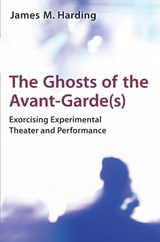 The Ghosts of the Avant-Garde(s): Exorcising Experimental Theater and Performance
James M. Harding
University of Michigan Press, 2015 The Ghosts of the Avant-Garde(s) offers a strikingly new perspective on key controversies and debates within avant-garde studies, arguing for the importance of reopening pivotal controversies and debates in avant-garde studies and challenging pronouncements of the “death of the avant-garde” that tend to obscure the diversity and plurality of avant-garde gesture and expression.
James M. Harding revisits iconic sites of early 20th-century performance to examine how European avant-gardists attempted—unsuccessfully—to employ that discourse as a strategy for enforcing uniformity among a politically and culturally diverse group of artists. He then takes aim at historical and aesthetic categories that have promoted a restrictive history and theory of the avant-garde and narrow readings of avant-garde performance. Harding reveals the Eurocentric undercurrents that underlie these categories and urges a consideration of the global political dimensions of avant-garde gestures. His book will interest scholars of theater and performance, art history, and literary studies, as well as those interested in the relation of art to politics in various historical periods and cultures.
 Ghosts of the Colorado Plains
Perry Eberhart
Ohio University Press, 1996 Since the second quarter of the nineteenth century, changing conditions have built and emptied small and large towns across the Colorado plain. At the time when Denver was little more than an overpopulated campsite along Cherry Creek there were numerous other settlements to the east and south, each with its own dreams of growth, gold or silver strikes, railroad connections, and rising influence over the surrounding territory. In Ghosts of the Colorado Plains, Eberhart traces some 150 of these ill-fated settlements, providing accounts of their birth, peak activity, and ultimate demise. As early trapping, mining, cattle, farming, and transportation industries brought successive waves of “easterners” into the territory, they created some of the most colorful communities of their time. The trail towns Boston and Trail City were reputed to be two of the roughest towns in the entire west. Real estate schemers and promoters offered dreams of civilization and respectability in the “cow towns.” Elsewhere, the stage stations, side of the road settlements, and farm centers arose out of the basic necessities of commerce and from a simple desire of far-flung settlers, trappers, and others for a place to congregate, celebrate, trade, brawl, and receive news from the east. Though the personalities and events which animated these communities are all but forgotten, the towns themselves are the legacy of the competing forces that opened and developed the Colorado territory. Readers of Guide to Colorado Ghost Towns and Mining Camps will welcome Ghosts of the Colorado Plains as an extension of Eberhart’s colorful blend of history and on-site information to a larger and much neglected area of the state. Through historical records, vignettes of personalities, and over 250 photos and 80 maps, Eberhart provides ready access to the towns and settlment sites of eastern Colorado’s past. For travelers, Ghosts of the Colorado Plains offers numerous pleasant excursions and investigations; for those less inclined to take to the field in search of artifacts and sites, the book offers fascinating glimpses of Colorado’s disappearing past.
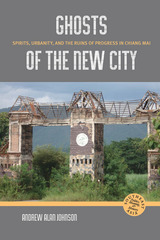 Ghosts of the New City: Spirits, Urbanity, and the Ruins of Progress in Chiang Mai
Andrew Alan Johnson
University of Hawaii Press, 2014 Chiang Mai (literally, “new city”) suffered badly in the 1997 Asian financial crisis as the Northern Thai real estate bubble collapsed along with the Thai baht, crushing dreams of a renaissance of Northern prosperity. Years later, the ruins of the excesses of the 1990s still stain the skyline. In Ghosts of the New City, Andrew Alan Johnson shows how the trauma of the crash, brought back vividly by the political crisis of 2006, haunts efforts to remake the city. For many Chiang Mai residents, new developments harbor the seeds of the crash, which manifest themselves in anxious stories of ghosts and criminals who conceal themselves behind the city’s progressive veneer.
Hopes for rebirth and fears of decline have their roots in Thai conceptions of progress, which draw from Buddhist and animist ideas of power and sacrality. Cities, Johnson argues, were centers where the charismatic power of kings and animist spirits were grounded; these entities assured progress by imbuing the space with sacred power that would avert disaster. Johnson traces such magico-religious conceptions of potency and space from historical records through present-day popular religious practice and draws parallels between these and secular attempts at urban revitalization.
Through a detailed ethnography of the contested ways in which academics, urban activists, spirit mediums, and architects seek to revitalize the flagging economy and infrastructure of Chiang Mai, Johnson finds that alongside the hope for progress there exists a discourse about urban ghosts, deadly construction sites, and the lurking anxiety of another possible crash, a discourse that calls into question history’s upward trajectory. In this way, Ghosts of the New City draws new connections between urban history and popular religion that have implications far beyond Southeast Asia.
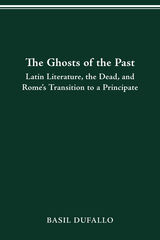 THE GHOSTS OF THE PAST: LATIN LITERATURE, THE DEAD, AND ROME'S TRANSITION TO A PRINCIPATE
BASIL DUFALLO
Ohio State University Press, 2007 The ancient Romans quite literally surrounded themselves with the dead: masks of the dead were in the atria of their houses, funerals paraded through their main marketplace, and tombs lined the roads leading into and out of the city. In Roman literature as well, the dead occupy a prominent place, indicating a close and complex relationship between literature and society. The evocation of the dead in the Latin authors of the first century BCE both responds and contributes to changing socio-political conditions during the transition from the Republic to the Empire.
To understand the literary life of the Roman dead, The Ghosts of the Past develops a new perspective on Latin literature’s interaction with Roman culture. Drawing on the insights of sociology, anthropology, and performance theory, Basil Dufallo argues that authors of the late Republic and early Principate engage strategically with Roman behaviors centered on the dead and their world in order to address urgent political and social concerns. Republican literature exploits this context for the ends of political competition among the clan-based Roman elite, while early imperial literature seeks to restage the republican practices for a reformed Augustan society.
Calling into question boundaries of genre and literary form, Dufallo’s study will revise current understandings of Latin literature as a cultural and performance practice. Works as diverse as Cicero’s speeches, Propertian elegy, Horace’s epodes and satires, and Vergil’s Aeneid appear in a new light as performed texts interacting with other kinds of cultural performance from which they might otherwise seem isolated.
 Ghosts Over the Boiler: Voices from Alabama's Death Row
Project Hope to Abolish the Death Penalty; Edited by Katie Owens-Murphy
Vanderbilt University Press, 2023 From a donated typewriter that frequently breaks down, people on Alabama's death row have literally cut and pasted together a newsletter, On Wings of Hope, for the last three decades to educate the public about the death penalty. This newsletter, a labor of love, documents decades of work, wisdom, activism, and lived experience of those who have been executed, or are scheduled to be executed, by the state of Alabama. The writings also chart the changing policy and practice of capital punishment in the state that sentences more people to death per capita than any other in the US.
Ghosts Over the Boiler is a curated collection of poetry, visual art, photographs, essays, creative writings, and other archival materials that have emerged from Alabama's death row from the organization Project Hope to Abolish the Death Penalty (PHADP). This group was founded at Holman Correctional Facility and has been operating autonomously since 1989 toward its mission to abolish the death penalty in Alabama and in the nation.
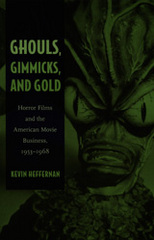 Ghouls, Gimmicks, and Gold: Horror Films and the American Movie Business, 1953–1968
Kevin Heffernan
Duke University Press, 2004 The Creature from the Black Lagoon, the Tingler, the Mole People—they stalked and oozed into audiences’ minds during the era that followed Boris Karloff’s Frankenstein and preceded terrors like Freddy Krueger (A Nightmare on Elm Street) and Chucky (Child’s Play). Ghouls, Gimmicks, and Gold pulls off the masks and wipes away the slime to reveal how the monsters that frightened audiences in the 1950s and 1960s—and the movies they crawled and staggered through—reflected fundamental changes in the film industry. Providing the first economic history of the horror film, Kevin Heffernan shows how the production, distribution, and exhibition of horror movies changed as the studio era gave way to the conglomeration of New Hollywood. Heffernan argues that major cultural and economic shifts in the production and reception of horror films began at the time of the 3-d film cycle of 1953–54 and ended with the 1968 adoption of the Motion Picture Association of America’s ratings system and the subsequent development of the adult horror movie—epitomized by Rosemary’s Baby. He describes how this period presented a number of daunting challenges for movie exhibitors: the high costs of technological upgrade, competition with television, declining movie attendance, and a diminishing number of annual releases from the major movie studios. He explains that the production and distribution branches of the movie industry responded to these trends by cultivating a youth audience, co-producing features with the film industries of Europe and Asia, selling films to television, and intensifying representations of sex and violence. Shining through Ghouls, Gimmicks, and Gold is the delight of the true horror movie buff, the fan thrilled to find The Brain that Wouldn’t Die on television at 3 am.
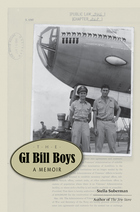 The GI Bill Boys: A Memoir
Stella, Suberman
University of Tennessee Press, 2012
In her warm and witty new memoir, Stella Suberman charms readers with her personal perspective as she recalls the original 1940s GI Bill. As she writes of the bill and the epic events that spawned it, she manages, in her crisp way, to personalize and humanizes them in order to entertain and to educate. Although her story is in essence that of two Jewish families, it echoes the story of thousands of Americans of that period.
Her narrative begins with her Southern family and her future husband’s Northern one – she designates herself and her husband as “Depression kids” – as they struggle through the Great Depression. In her characteristically lively style, she recounts the major happenings of the era: the Bonus March of World War I veterans; the attack on Pearl Harbor; the Roosevelt/New Deal years; the rise of Hitler’s Nazi party and the Holocaust; the second World War; and the post-war period when veterans returned home to a collapsed and jobless economy. She then takes the reader to the moment when the GI Bill appeared, the glorious moment, as she writes, when returning veterans realized they had been given a future.
As her husband begins work on his Ph.D., she focuses on the GI men and their wives as college life consumed them. It is the time also of Senator Joseph McCarthy and the “Red Scare,” of the creation of an Israeli state, of the Korean War, and of other important issues, and she discusses them forthrightly. Throughout this section she writes of how the GI’s doggedly studied, engaged in critical thinking (perhaps for the first time), discovered their voices. As she suggests, it was not the 1930’s anymore, and the GI Bill boys were poised to give America an authentic and robust middle class.
Stella Suberman is the author of two popular and well-reviewed titles: The Jew Store and When It Was OurWar. In its starred review, Booklist called The Jew Store “an absolute pleasure,” and The Atlanta Journal-Constitution wrote that it was “valuable history as well as a moving story.” When It Was Our War received a starred review from Publishers Weekly, and in another starred review, Kirkus Reviews described it as “Engaging . . . A remarkable story that resonates with intelligence and insight.” Mrs. Suberman lives with her husband, Jack, in Chapel Hill, North Carolina.
 The GI Bill Boys: A Memoir
Stella Suberman
University of Tennessee Press In her warm and witty new memoir, Stella Suberman charms readers with her personal perspective as she recalls the original 1940s GI Bill. As she writes of the bill and the epic events that spawned it, she manages, in her crisp way, to personalize and humanizes them in order to entertain and to educate. Although her story is in essence that of two Jewish families, it echoes the story of thousands of Americans of that period. Her narrative begins with her Southern family and her future husband’s Northern one – she designates herself and her husband as “Depression kids” – as they struggle through the Great Depression. In her characteristically lively style, she recounts the major happenings of the era: the Bonus March of World War I veterans; the attack on Pearl Harbor; the Roosevelt/New Deal years; the rise of Hitler’s Nazi party and the Holocaust; the second World War; and the post-war period when veterans returned home to a collapsed and jobless economy. She then takes the reader to the moment when the GI Bill appeared, the glorious moment, as she writes, when returning veterans realized they had been given a future. As her husband begins work on his Ph.D., she focuses on the GI men and their wives as college life consumed them. It is the time also of Senator Joseph McCarthy and the “Red Scare,” of the creation of an Israeli state, of the Korean War, and of other important issues, and she discusses them forthrightly. Throughout this section she writes of how the GI’s doggedly studied, engaged in critical thinking (perhaps for the first time), discovered their voices. As she suggests, it was not the 1930’s anymore, and the GI Bill boys were poised to give America an authentic and robust middle class. Stella Suberman is the author of two popular and well-reviewed titles: The Jew Store and When It Was Our War. In its starred review, Booklist called The Jew Store “an absolute pleasure,” and The Atlanta Journal-Constitution wrote that it was “valuable history as well as a moving story.” When It Was Our War received a starred review from Publishers Weekly, and in another starred review, Kirkus Reviews described it as “Engaging . . . A remarkable story that resonates with intelligence and insight.” Mrs. Suberman lives with her husband, Jack, in Chapel Hill, North Carolina.
 GI Jews: How World War II Changed a Generation
Deborah Dash Moore
Harvard University Press, 2004 Whether they came from Sioux Falls or the Bronx, over half a million Jews entered the U.S. armed forces during the Second World War. Uprooted from their working- and middle-class neighborhoods, they joined every branch of the military and saw action on all fronts. Deborah Dash Moore offers an unprecedented view of the struggles these GI Jews faced, having to battle not only the enemy but also the prejudices of their fellow soldiers.
Through memoirs, oral histories, and letters, Moore charts the lives of fifteen young Jewish men as they faced military service and tried to make sense of its demands. From confronting pork chops to enduring front-line combat, from the temporary solace of Jewish worship to harrowing encounters with death camp survivors, we come to understand how these soldiers wrestled with what it meant to be an American and a Jew.
Moore shows how military service in World War II transformed this generation of Jews, reshaping Jewish life in America and abroad. These men challenged perceptions of Jews as simply victims of the war, and encouraged Jews throughout the diaspora to fight for what was right. At the same time, service strengthened Jews' identification with American democratic ideals, even as it confirmed the importance of their Jewish identity. GI Jews is a powerful, intimate portrayal of the costs of a conflict that was at once physical, emotional, and spiritual, as well as its profound consequences for these hitherto overlooked members of the "greatest generation."
Giacomettis Dog
Robin Becker
University of Pittsburgh Press, 2024 Celebratory or eligiac, these poems record the author’s “two-headed journey” to root herself - geographically and emotionally - in the world. Becker’s poems are from remote and familiar outposts: the watery evanescence of Venice contrasts with the desert of the American Southwest; we lean with her over the rim of a canyon or stand back to study a Giacometti sculpture. From such settings arise poems on the death of a sibling, the consoling power of painting and sculpture; others celebrate the erotic and the capacity of the female body for pleasure and pain.
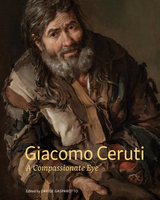 Giacomo Ceruti: A Compassionate Eye
Davide Gasparotto
J. Paul Getty Trust, The, 2023 A thoughtful look at representations of people experiencing poverty in early modern Europe.
The northern Italian artist Giacomo Ceruti (1698–1767) was born in Milan and active in Brescia and Bergamo. For his distinctive, large-scale paintings of low-income tradespeople and individuals experiencing homelessness, whom he portrayed with dignity and sympathy, Ceruti came to be known as Il Pitocchetto (the little beggar).
Accompanying the first US exhibition to focus solely on Ceruti, this publication explores relationships between art, patronage, and economic inequality in early modern Europe, considering why these paintings were commissioned and by whom, where such works were exhibited, and what they signified to contemporary audiences. Essays and a generous plate section contextualize and closely examine Ceruti’s pictures of laborers and the unhoused, whom he presented as protagonists with distinct stories rather than as generic types. Topics include depictions of marginalized subjects in the history of early modern European art, the career of the artist and his significance in the history of European painting, and period discourses around poverty and social support. A detailed exhibition checklist, complete with provenance, exhibition history, and bibliography, provides information critical for the further understanding of Ceruti’s oeuvre.
This volume is published to accompany an exhibition on view at the J. Paul Getty Museum at the Getty Center from July 18 to October 29, 2023.
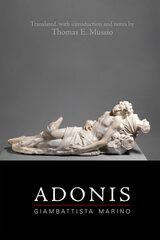 Giambattista Marino: Adonis
Thomas E. Mussio
Arizona Center for Medieval and Renaissance Studies, 2019 This is the first complete translation in English of Giambattista Marino’s Adone, a poem of 20 cantos written in Italian and first published in 1623 in Paris. Although Marino’s work has been characterized as a mythological poem with the tragic tale of Venus and Adonis at its core and woven through with retellings of many Greek and Roman myths, it is clear that Marino strove to write more than an Italian version of Ovid’s Metamorphoses. The highly wrought descriptive passages that permeate the poem, the allusions to contemporary political figures and events, and the rich scientific, philosophical, and theological language of many passages reflect Marino’s particular poetic style, his broad interests, and his engagement with the political and intellectual scene of early seventeenth-century Europe. One of the goals of this translation is to provide a highly accessible version of the whole poem and to expand its readership to include not only students and scholars of the romance epic and the early modern period but also curious general readers. It is hoped that this modern, annotated translation will spur new research on Marino’s poem and bear new assessments of the poem’s relation to its sources, of its influence on later literature, and of its vital connection with key issues of Marino’s time, such as scientific advancement, discovery and exploration, and the power and influence of the Catholic Church.
Translated, with introduction and notes by Thomas E. Mussio.
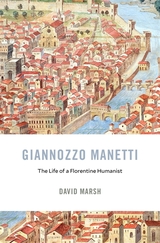 Giannozzo Manetti: The Life of a Florentine Humanist
David Marsh
Harvard University Press, 2019 An introduction to one of the premier humanists of the Italian Renaissance, whose extraordinary work in biography, politics, religion, and philosophy has been largely unknown to Anglophone readers.
A celebrated orator, historian, philosopher, and statesman, Giannozzo Manetti (1396–1459) was one of the most remarkable figures of the Italian Renaissance. The son of a wealthy Florentine merchant, he was active in the public life of the Florentine republic and embraced the new humanist scholarship of the Quattrocento.
Among his many contributions, Manetti translated from classical Latin, Greek, and Hebrew, bringing attention to great works of the ancient world that were previously unknown. He also offered a humanist alternative to the Vulgate Bible by translating into Latin the Greek text of the New Testament and the Hebrew Psalms. His other works included biographies of Dante, Petrarch, and Boccaccio; A Translator’s Defense, an indispensable treatise on the art of translation; and Against the Jews and the Gentiles, an apologia for Christianity.
Manetti is most remembered for his treatise On Human Worth and Excellence, a radical defense of human nature and of the new world view of Renaissance humanism. In this authoritative biography, the first ever in English, David Marsh guides readers through the vast range of Manetti’s writings, which, despite growing scholarly interest, are still largely unfamiliar to the English-speaking world. Marsh’s fresh appraisal makes clear why Manetti must be considered among the great expositors of the spirit of his age.
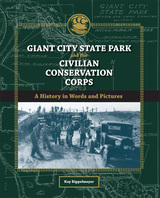 Giant City State Park and the Civilian Conservation Corps: A History in Words and Pictures
Kay Rippelmeyer
Southern Illinois University Press, 2010 Many recognize Giant City State Park as one of the premier recreation spots in southern Illinois, with its unspoiled forests, glorious rock formations, and famous sandstone lodge. But few know the park’s history or are aware of the remarkable men who struggled to build it. Giant City State Park and the Civilian Conservation Corps: A History in Words and Pictures provides the first in-depth portrait of the park’s creation, drawing on rarely seen photos, local and national archival research, and interviews to present an intriguing chapter in Illinois history. Kay Rippelmeyer traces the geological history of the park, exploring the circumstances that led to the breathtaking scenery for which Giant City is so well known, and providing insightful background on and cultural history of the area surrounding the park. Rippelmeyer then outlines the effects of the Great Depression and the New Deal on southern Illinois, including relief efforts by the Civilian Conservation Corps, which began setting up camps at Giant City in 1933. The men of the CCC, most of them natives of southern and central Illinois, are brought to life through vividly detailed, descriptive prose and hundreds of black-and-white photographs that lavishly illustrate life in the two camps at the park. This fascinating book not only documents the men’s hard work—from the clearing of the first roads and building of stone bridges, park shelters, cabins, and hiking and bridle trails, to quarry work and the raising of the lodge’s famous columns—it also reveals the more personal side of life in the two camps at the park, covering topics ranging from education, sports, and recreation, to camp newspapers, and even misbehavior and discipline. Supplementing the photographs and narrative are engaging conversations with alumni and family members of the CCC, which give readers a rich oral history of life at Giant City in the 1930s. The book is further enhanced by maps, rosters of enrollees and officers, and a list of CCC camps in southern Illinois. The culmination of three decades of research, Giant City State Park and the Civilian Conservation Corps provides the most intimate history ever of the park and its people, honoring one of Illinois’s most unforgettable places and the men who built it.
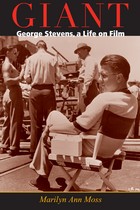 Giant: George Stevens, a Life on Film
Marilyn Ann Moss
University of Wisconsin Press, 2015 Marilyn Ann Moss’s Giant examines the life of one of the most influential directors to work in Hollywood from the 1930s to the 1960s. George Stevens directed such popular and significant films as Shane, Giant, A Place in the Sun, and The Diary of Anne Frank. He was the first to pair Katharine Hepburn and Spencer Tracy on film in Woman of the Year. Through the study of Stevens’s life and his production history, Moss also presents a glimpse of the workings of the classic Hollywood studio system in its glory days.
Moss documents Stevens’s role as a powerful director who often had to battle the heads of major studios to get his films made his way. She traces the four decades Stevens was a major Hollywood player and icon, from his earliest days at the Hal Roach Studios—where he learned to be a cameraman, writer, and director for Laurel and Hardy features—up to when his films made millions at the box office and were graced by actors such as Elizabeth Taylor, James Dean, Alan Ladd, and Montgomery Clift.
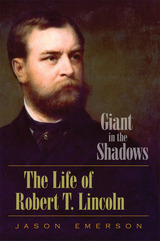 Giant in the Shadows: The Life of Robert T. Lincoln
Jason Emerson
Southern Illinois University Press, 2012 University Press Books for Public and Secondary Schools, 2013 edition
Book of the Year by the Illinois State historical Society, 2013
Although he was Abraham and Mary Lincoln’s oldest and last surviving son, the details of Robert T. Lincoln’s life are misunderstood by some and unknown to many others. Nearly half a century after the last biography about Abraham Lincoln’s son was published, historian and author Jason Emerson illuminates the life of this remarkable man and his achievements in Giant in the Shadows: The Life of Robert T. Lincoln. Emerson, after nearly ten years of research, draws upon previously unavailable materials to offer the first truly definitive biography of the famous lawyer, businessman, and statesman who, much more than merely the son of America’s most famous president, made his own indelible mark on one of the most progressive and dynamic eras in United States history. Born in a boardinghouse but passing his last days at ease on a lavish country estate, Robert Lincoln played many roles during his lifetime. As a president’s son, a Union soldier, an ambassador to Great Britain, and a U.S. secretary of war, Lincoln was indisputably a titan of his age. Much like his father, he became one of the nation’s most respected and influential men, building a successful law practice in the city of Chicago, serving shrewdly as president of the Pullman Car Company, and at one time even being considered as a candidate for the U.S. presidency. Along the way he bore witness to some of the most dramatic moments in America’s history, including Robert E. Lee’s surrender at Appomattox Courthouse; the advent of the railroad, telephone, electrical, and automobile industries; the circumstances surrounding the assassinations of three presidents of the United States; and the momentous presidential election of 1912. Giant in the Shadows also reveals Robert T. Lincoln’s complex relationships with his famous parents and includes previously unpublished insights into their personalities. Emerson reveals new details about Robert’s role as his father’s confidant during the brutal years of the Civil War and his reaction to his father’s murder; his prosecution of the thieves who attempted to steal his father’s body in 1876 and the extraordinary measures he took to ensure it would never happen again; as well as details about the painful decision to have his mother committed to a mental facility. In addition Emerson explores the relationship between Robert and his children, and exposes the actual story of his stewardship of the Lincoln legacy—including what he and his wife really destroyed and what was preserved. Emerson also delves into the true reason Robert is not buried in the Lincoln tomb in Springfield but instead was interred at Arlington National Cemetery. Meticulously researched, full of never-before-seen photographs and new insight into historical events, Giant in the Shadows is the missing chapter of the Lincoln family story. Emerson’s riveting work is more than simply a biography; it is a tale of American achievement in the Gilded Age and the endurance of the Lincoln legacy.
 The Giant Pandas of Wolong
George B. Schaller, Hu Jinchu, Pan Wenshi, and Zhu Jing
University of Chicago Press, 1985 The giant panda is threatened with extinction. Only about a thousand survive in the wild in China, about half of them protected in reserves. In an effort to save this remarkable species, the government of China and the World Wildlife Fund began cooperative research in 1980. The Giant Pandas of Wolong is not only the first report of this joint venture but also the first detailed account of the panda's natural history. It describes the environment, distribution, life cycle, and daily and seasonal activities of pandas in the wild.
Although giant pandas have few natural enemies, the periodic die-off of bamboo, their main food, threatens their survival. In order to understand the panda's vital link to bamboo, the research team has explored many aspects of the animal's life, collecting information on both wild and captive pandas. Though a herbivore, the panda retains the simple digestive tract of a carnivore. Unable to digest cellulose in plants, it receives relatively little nutrition from the bamboo it eats. As a result, it must eat many kilograms of bamboo each day, foraging for fourteen hours or more throughout a day and night.
Known to the Chinese for several thousand years as daxiongmao, "large bear-cat," the giant panda has defied easy classification. The authors review anatomical, biochemical, behavioral, and paleontological evidence, concluding that the animal is neither bear nor raccoon but belongs in a separate family, perhaps with the small red panda.
The giant panda has captured the imagination of the public more than any other animal. By presenting their groundbreaking and crucial research to the public, the authors of The Giant Pandas of Wolong hope to spur further research and action that will help this precious animal survive.
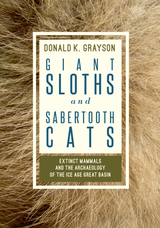 Giant Sloths and Sabertooth Cats: Extinct Mammals and the Archaeology of the Ice Age Great Basin
Donald K. Grayson
University of Utah Press, 2016 As the Ice Age came to an end, North America lost a stunning variety of animals. Mammoths, mastodon, llamas, ground-dwelling sloths the size of elephants, beavers the size of bears, pronghorn antelope the size of poodles, and carnivores to chase them—sabertooth cats, dire wolves, American lions and cheetahs; these and many more were gone by 10,000 years ago. Giant Sloths and Sabertooth Cats surveys all these animals, with a particular focus on the Great Basin. The book also explores the major attempts to explain the extinctions. Because some believe that they were due to the activities of human hunters, the author also reviews the archaeological evidence left by the earliest known human occupants of the Great Basin, showing that people were here at the same time and in the same places as many of the extinct animals.
Were these animals abundant in the Great Basin? A detailed analysis of the distinctive assemblages of plants that now live in this region leads to a surprising, and perhaps controversial, conclusion about those abundances.
If you are interested in Ice Age mammals or in the Ice Age archaeology of North America, if you are interested in the natural history of the Great Basin or the ways in which the plants of today’s landscapes might be used to understand the deeper past, you will be fascinated by this book.
Giant Steps: Suffragettes and Soldiers
Mary Blair Immel
Indiana Historical Society Press, 2017 As Giant Steps opens, thirteen-year-old Bernie Epperson of Lafayette, Indiana, is wrestling with double standards placed on her compared with her brothers. Soon her cousin awakens her to all the unfair restrictions women face, and Bernie becomes a suffragette. Meanwhile, World War I begins. Her family is devastated when her brothers become soldiers, and Bernie must decide how to help the war effort and continue to fight for women’s rights. While this story is fictional, the details of the suffrage movement and the war efforts of ordinary Americans are true. Middle and high school students will relate to Bernie and her brothers’ dilemmas a century ago because they also face making decisions in a turbulent world while sifting through contradictory news and changing wisdom.
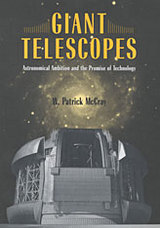 Giant Telescopes: Astronomical Ambition and the Promise of Technology
W. Patrick McCray
Harvard University Press, 2003 Every night, astronomers use a new generation of giant telescopes at observatories around the world to study phenomena at the forefront of science. By focusing on the history of the Gemini Observatory—twin 8-meter telescopes located on mountain peaks in Hawaii and Chile—Giant Telescopes tells the story behind the planning and construction of modern scientific tools, offering a detailed view of the technological and political transformation of astronomy in the postwar era.
Drawing on interviews with participants and archival documents, W. Patrick McCray describes the ambitions and machinations of prominent astronomers, engineers, funding patrons, and politicians in their effort to construct a modern facility for cutting-edge science—and to establish a model for international cooperation in the coming era of “megascience.” His account details the technological, institutional, cultural, and financial challenges that scientists faced while planning and building a new generation of giant telescopes. Besides exploring how and why scientists embraced the promise and potential of new technologies, he considers how these new tools affected what it means to be an astronomer. McCray’s book should interest anyone who desires a deeper understanding of the science, technology, and politics behind finding our place in the universe.
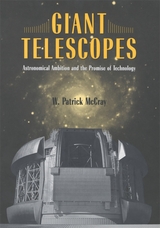 Giant Telescopes: Astronomical Ambition and the Promise of Technology
W. Patrick McCray
Harvard University Press, 2006 Every night, astronomers use a new generation of giant telescopes at observatories around the world to study phenomena at the forefront of science. By focusing on the history of the Gemini Observatory—twin 8-meter telescopes located on mountain peaks in Hawaii and Chile—Giant Telescopes tells the story behind the planning and construction of modern scientific tools, offering a detailed view of the technological and political transformation of astronomy in the postwar era.
Drawing on interviews with participants and archival documents, W. Patrick McCray describes the ambitions and machinations of prominent astronomers, engineers, funding patrons, and politicians in their effort to construct a modern facility for cutting-edge science—and to establish a model for international cooperation in the coming era of “megascience.” His account details the technological, institutional, cultural, and financial challenges that scientists faced while planning and building a new generation of giant telescopes. Besides exploring how and why scientists embraced the promise and potential of new technologies, he considers how these new tools affected what it means to be an astronomer. McCray’s book should interest anyone who desires a deeper understanding of the science, technology, and politics behind finding our place in the universe.
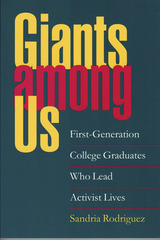 Giants Among Us: First-Generation College Graduates Who Lead Activist Lives
Sandria Rodriguez
Vanderbilt University Press, 2001 How do children from undereducated and impoverished backgrounds get to college? What are the influences that lead them to overcome their socioeconomic disadvantages and sometimes the disapproval of families and friends to succeed in college? These are the basic questions Sandria Rodriguez posed to seventeen first-generation college graduates, and their compelling life stories make important contributions to what little is known about this phenomenon.
The daughter of parents who didn't finish elementary school, Rodriguez uses many examples from her own life in the course of examining the participants' experiences before, during, and after college that directed them toward social or educational activism. Together, the seventeen represent a wide range of diversity in terms of race, ethnicity, age, geographical area of childhood, and profession. Twelve of the seventeen hold advanced degrees, all are working professionals, and all come from families who were poor. Jerry, the son of German immigrants, owns an engineering company in Chicago; Chang, a native of China, is the first from his village to go to college; Grant, a sharecropper's son, is a lawyer with a nationally prominent law firm in Washington, D.C., and patron of fine arts; Arlene, a Mohawk Indian, is a storyteller and social activist; Alex, from Spanish Harlem, is an elementary school principal.
The book is divided into four parts. In the first two chapters, we meet the participants. In the three chapters that follow, Rodriguez examines how the participants as children perceived themselves within their families, schools, and communities. Chapters four and five focus on the campus life and the participants' activist experiences. Finally, chapter six offers recommendations for mentoring disadvantaged children, so that they can successfully "switch the track" and aim for something better.
Giants Among Us is an essential resource for college administrators, faculty, counselors, and student support-services staff--as well as K-12 educators--concerned with preparing, retaining and mentoring first-generation students.
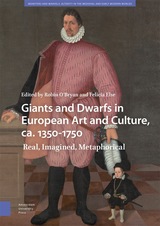 Giants and Dwarfs in European Art and Culture, ca. 1350-1750: Real, Imagined, Metaphorical
Robin O'Bryan
Amsterdam University Press, 2024 Not since Edward Wood’s Giants and Dwarfs published in 1868 has the subject been the focus of a scholarly study in English. Treating the topic afresh, this volume offers new insights into the vogue for giants and dwarfs that flourished in late-medieval and early modern Europe. From chapters dealing with the real dwarfs and giants in the royal and princely courts, to the imaginary giants and dwarfs that figured in the crafting of nationalistic and ancestral traditions, to giants and dwarfs used as metaphorical expression, scholars discuss their role in art, literature, and ephemeral display. Some essays examine giants and dwarfs as monsters and marvels and collectibles, while others show artists and writers emphasizing contrasts in scale to inspire awe or for comic effect. As these investigations reveal, not all court dwarfs functioned as jesters, and giant figures might equally be used to represent heroes, anti-heroes, and even a saint.
The Giant’s Rival: The USSR and Latin America, Revised Edition
Cole Blasier
University of Pittsburgh Press, 1988 The Giant's Rival is an authoritative survey of Soviet relations with Latin America. Blasier provides a concise account of Soviet diplomatic, economic, and political-military involvement in the region, focusing on the post-1970 period.
This revised edition includes chapters analyzing developments since 1983. Blasier views the origins of the Sandinista revolution, and its relation to international Communism, and how the Nicaraguan government has grown dependent on Soviet oil, arms, and economic and political assistance. He also describes the growing relations between the New Jewel Movement in Grenada and Moscow before it was toppled by the U.S. invasion. Blasier explains how U.S. policies have affected Soviet outcomes and makes proposals for protecting and advancing U.S. interests.
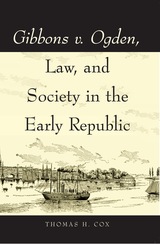 Gibbons v. Ogden, Law, and Society in the Early Republic
Thomas H. Cox
Ohio University Press, 2009 Gibbons v. Ogden, Law, and Society in the Early Republic examines a landmark decision in American jurisprudence, the first Supreme Court case to deal with the thorny legal issue of interstate commerce. Decided in 1824, Gibbons v. Ogden arose out of litigation between owners of rival steamboat lines over passenger and freight routes between the neighboring states of New York and New Jersey. But what began as a local dispute over the right to ferry the paying public from the New Jersey shore to New York City soon found its way into John Marshall’s court and constitutional history. The case is consistently ranked as one of the twenty most significant Supreme Court decisions and is still taught in constitutional law courses, cited in state and federal cases, and quoted in articles on constitutional, business, and technological history. Gibbons v. Ogden initially attracted enormous public attention because it involved the development of a new and sensational form of technology. To early Americans, steamboats were floating symbols of progress—cheaper and quicker transportation that could bring goods to market and refinement to the backcountry. A product of the rough-and-tumble world of nascent capitalism and legal innovation, the case became a landmark decision that established the supremacy of federal regulation of interstate trade, curtailed states’ rights, and promoted a national market economy. The case has been invoked by prohibitionists, New Dealers, civil rights activists, and social conservatives alike in debates over federal regulation of issues ranging from labor standards to gun control. This lively study fills in the social and political context in which the case was decided—the colorful and fascinating personalities, the entrepreneurial spirit of the early republic, and the technological breakthroughs that brought modernity to the masses.
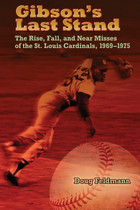 Gibson's Last Stand: The Rise, Fall, and Near Misses of the St. Louis Cardinals, 1969-1975
Doug Feldmann
University of Missouri Press, 2013 During star-pitcher Bob Gibson’s most brilliant season, the turbulent summer of 1968, he started thirty-four games and pitched every inning in twenty-eight of them, shutting out the opponents in almost half of those complete games. After their record-breaking season, Gibson and his teammates were stunned to lose the 1968 World Series to the Detroit Tigers. For the next six years, as Bob Gibson struggled to maintain his pitching excellence at the end of his career, changes in American culture ultimately changed the St. Louis Cardinals and the business and pastime of baseball itself. Set against the backdrop of American history and popular culture, from the protests of the Vietnam War to the breakup of the Beatles, the story of the Cardinals takes on new meaning as another aspect of the changes happening at that time. In the late 1960s, exorbitant salaries and free agency was threatening to change America’s game forever and negatively impact the smaller-market teams in Major League Baseball. As the Cardinals’ owner August A. Busch Jr. and manager Albert “Red” Schoendienst attempted to reinvent the team, restore its cohesiveness, and bring new blood in to propel the team back to contention for the pennant, Gibson remained the one constant on the team. In looking back on his career, Gibson mourned the end of the Golden Era of baseball and believed that the changes in the game would be partially blamed on him, as his pitching success caused team owners to believe that cash-paying customers only wanted base hits and home runs. Yet, he contended, the shrinking of the strike zone, the lowering of the mound, and the softening of the traditional rancor between the hitter and pitcher forever changed the role of the pitcher in the game and created a more politically correct version of the sport. Throughout Gibson’s Last Stand, Doug Feldmann captivates readers with the action of the game, both on and off the field, and interjects interesting and detailed tidbits on players’ backgrounds that often tie them to famous players of the past, current stars, and well-known contemporary places. Feldmann also entwines the teams history with Missouri history: President Truman and the funeral procession for President Eisenhower through St. Louis; Missouri sports legends Dizzy Dean, Mark McGwire, and Stan “the Man” Musial; and legendary announcers Harry Caray and Jack Buck. Additionally, a helpful appendix provides National League East standings from 1969 to 1975. Bob Gibson remains one of the most unique, complex, and beloved players in Cardinals history. In this story of one of the least examined parts of his career—his final years on the team—Feldmann takes readers into the heart of his complexity and the changes that swirled around him.
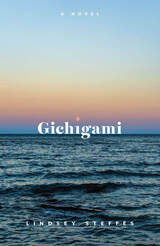 Gichigami: A Novel
Lindsey Steffes
University of Massachusetts Press, 2025 An eerie coming-of-age story of a young girl’s quest for her absent mother across the frozen terrain of Lake Superior
One December evening, when 13-year-old Marta crosses the frozen Lake Superior and reaches the home she shares with her father, she finds a woman standing at their door. As Marta approaches, she realizes the woman, who looks like a tropical bird caught in the snow, is her mother who’d abruptly left them six years before. Marta hopes this is a turning point, that her mother will stay this time—despite hating this town, this island, and their creaky, towering Victorian house. But not everyone in town is thrilled with her mother’s arrival, least of all her dad.
Almost as soon as she arrives, however, Marta’s mother abruptly vanishes again, nowhere to be found, leaving Marta with more questions than answers. Her father denies her mother was ever there and Marta is left with the mystery of her mother’s homecoming. She begins to wonder if he is lying, or if there is a deeper secret being kept from her by the entire tight-knit community. As Marta delves into her mother's sudden reappearance and subsequent disappearance, she seeks answers, visiting places that were significant to her mother and questioning people she knew. Desperate for answers that will shed light on the mystery, this quest leads her to uncover a web of secrets that threaten to unravel everything she thought she knew about her family and herself.
Gichigami is an eerie coming-of-age novel, weaving between Marta and the person desperately trying to keep Marta and her mother apart. This poignant exploration of the lives of women and girls of the Midwest shines a light on the struggles of absent mothers, runaway daughters, and those who yearn for more than life has offered them. With rich prose and vivid imagery, Lindsey Steffes spins a tale of loss, longing, and betrayal set against the backdrop of the harsh yet beautiful landscape of Lake Superior.
Gideon Lincecum, 1793-1874: A Biography
By Lois Wood Burkhalter
University of Texas Press, 1965 In Gideon Lincecum's lifetime the United States expanded from fifteen to thirty-eight states—and Lincecum moved always with or ahead of that expansion. Possessed of a driving intellectual curiosity undeterred by lack of formal education, Lincecum examined all he confronted. He learned from Indians, he read widely, and he corresponded with the great minds of his day. In the process he became many things: physician, musician, botanist, entomologist, ornithologist, and translator of Indian dialects. His collection of information and specimens in the field of natural science was used by leading authorities. From his voluminous letters, Mrs. Burkhalter has constructed a picture of a "remarkable and delightful American who deserves a place in the history of this country."
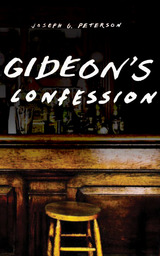 Gideon's Confession
Joseph G. Peterson
Northern Illinois University Press, 2014 In his fourth novel Peterson tells the story of Gideon Anderson, a young man alienated from his father and two brothers who have gone into the family business. Unlike them, he receives checks from his rich uncle every month. In exchange for the checks, the uncle asks Gideon to come up with a plan for his life, essentially a blueprint about how he intends to enter the job market. Gideon, who went to a prestigious university, puts his uncle off and spends the money on alcohol, the horses, and a miscellany of useless purchases partly because he doesn’t know what to do, partly because he doesn’t want to do anything.
Gideon then meets a lovely, ambitious woman, Claire, who encourages him to do better with his life and talent. She asks him to come to New York with her where her father can set him up in his firm or bankroll a business venture. Despite his good fortune in love and access to the steady cash-flow provided by his uncle, Gideon, like Melville’s character Bartleby the Scrivener “prefers not to” commit either to a career or to Claire. For ten years he just drifts. And then suddenly his uncle dies and Gideon has to make a decision.
The novels of Joseph G. Peterson have run a literary gauntlet from searing prose to lyrical poetry; from noir style to full character-driven plots, and his work has drawn comparisons to Gertrude Stein and Ernest Hemingway. An incredible eye for detail and taut, lean prose are what readers have come to expect from a Peterson effort, and in this new book they will not be disappointed. Peterson delivers an emotionally engaging parable that will appeal not only to twenty-somethings unwilling or unable to commit and fit in, but also to adult readers who appreciate modern literary fiction and carefully crafted characters.
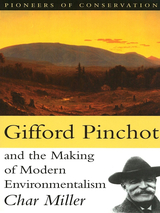 Gifford Pinchot and the Making of Modern Environmentalism
Char Miller
Island Press, 2001 Gifford Pinchot is known primarily for his work as first chief of the U. S. Forest Service and for his argument that resources should be used to provide the "greatest good for the greatest number of people." But Pinchot was a more complicated figure than has generally been recognized, and more than half a century after his death, he continues to provoke controversy. Gifford Pinchot and the Making of Modern Environmentalism, the first new biography in more than three decades, offers a fresh interpretation of the life and work of the famed conservationist and Progressive politician. In addition to considering Gifford Pinchot's role in the environmental movement, historian Char Miller sets forth an engaging description and analysis of the man -- his character, passions, and personality -- and the larger world through which he moved. Char Miller begins by describing Pinchot's early years and the often overlooked influence of his family and their aspirations for him. He examines Gifford Pinchot's post-graduate education in France and his ensuing efforts in promoting the profession of forestry in the United States and in establishing and running the Forest Service. While Pinchot's twelve years as chief forester (1898-1910) are the ones most historians and biographers focus on, Char Miller also offers an extensive examination of Pinchot's post-federal career as head of The National Conservation Association and as two-term governor of Pennsylvania. In addition, he looks at Pinchot's marriage to feminist Cornelia Bryce and discusses her role in Pinchot's political radicalization throughout the 1920s and 1930s. An epilogue explores Gifford Pinchot's final years and writings. Char Miller offers a provocative reconsideration of key events in Pinchot's life, including his relationship with friend and mentor John Muir and their famous disagreement over damming Hetch Hetchy Valley. The author brings together insights from cultural and social history and recently discovered primary sources to support a new interpretation of Pinchot -- whose activism not only helped define environmental politics in early twentieth century America but remains strikingly relevant today.
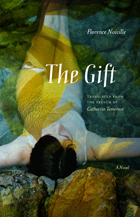 The Gift: A Novel
Florence Noiville
Northwestern University Press, 2012 This moving fictional memoir begins as a woman heads home after a meeting regarding her inheritance. Rebeling against the legalese uttered by the attorney, her mind drifts back to her childhood and she sees her life with sudden clarity. On the train, she jots down a few notes, which prompt the poetic outpouring of memory and emotion that make up this delicate novel.
The narrator’s mother looms large in her psyche. Labeled “eccentric” or “Italian,” her mother in fact suffered from what was later found to be manic depression. Without understanding the disease, the family treated the unpredictable ups and downs of her condition as they struck. During periods of paralyzing depression she was hospitalized, and the family felt abandoned. During periods of manic productivity and overdrive, she was a dedicated pharmacist, an exemplary homemaker, and an unusually knowledgeable gardener.
This sparse novel draws the portrait of a grand and unforgettable lady, loving and unable to love at once. Her bequest is as much a material one as it is an emotional one, and, the author surmises as she glances at her own daughters, a genetic one.
Gift and Communion
Jaroslaw Kupczak
Catholic University of America Press, 2014 Gift and Communion offers a critical presentation of John Paul II's theology of the body, understood in the light of Christian theological tradition. The main thesis of the book is that John Paul II's theology of the body forms a new, inspiring approach to Christian ethics and the theology of marriage and family, as well as to theological anthropology. A central thrust of Gift and Communion is to treat theology of the body - as it deserves - in all its philosophical and theological seriousness and to present it as an important stage in the historical development of Catholic theology
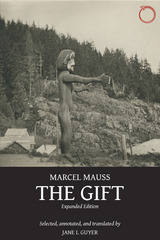 The Gift: Expanded Edition
Marcel Mauss
HAU, 2016 Scan down a list of essential works in any introduction to anthropology course and you are likely to see Marcel Mauss’ masterpiece, The Gift. With this new translation, Mauss’ classic essay is returned to its original context, published alongside the works that framed its first publication in the 1923–24 issue of L’Année Sociologique. With a critical foreword by Bill Maurer and a new introduction by translator Jane Guyer, this expanded edition is certain to become the standard English version of the essay—a gift that keeps on giving.
Included alongside the “Essay on the Gift” are Mauss’ memorial accounts of the work of Émile Durkheim and his colleagues who were lost during World War I, as well as his scholarly reviews of influential contemporaries such as Franz Boas, J. G. Frazer, Bronislaw Malinowski, and others. Read in the context of these additional pieces, the “Essay on the Gift” is revealed as a complementary whole, a gesture of both personal and political generosity: Mauss’ honor for his fallen colleagues; his aspiration for modern society’s recuperation of the gift as a mode of repair; and his own careful, yet critical, reading of his intellectual milieu. The result sets the scene for a whole new generation of readers to study this essay alongside pieces that exhibit the erudition, political commitment, and generous collegial exchange that first nourished the essay into life.
Gift Giving: A Research Anthology
Cele Otnes
University of Wisconsin Press, 1996
Gift Giving brings together 21 scholars from a variety of disciplines—including consumer behavior, communications, and sociology—who are dedicated to the understanding of what motivates gift selection, presentation, and incorporation of a gift into a person's life.
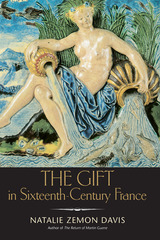 The Gift in Sixteenth-Century France
Natalie Zemon Davis
University of Wisconsin Press, 2000
Must a gift be given freely? How can we tell a gift from a bribe? Are gifts always a part of human relations—or do they lose their power and importance once the market takes hold and puts a price on every exchange? These questions are central to our sense of social relations past and present, and they are at the heart of this book by one of our most interesting and renowned historians.
In a wide-ranging look at gift giving in early modern France, Natalie Zemon Davis reveals the ways that gift exchange is crucial to understanding alliance and conflict in family life, economic relations, politics, and religion. Moving from the king’s bounty to the beggar’s alms, her book explores the modes and meanings of gift giving in every corner of sixteenth-century French society. In doing so, it arrives at a new way of considering gifts—what Davis calls "the gift register"—as a permanent feature of social relations over time. Gift giving, with its own justifications and forms in different periods, can create amity or lead to quarrels and trouble. It mixes the voluntary and the obligatory, with interested bribery at one extreme and inspired gratuitousness at the other.
Examining gifts both ethnographically (through archives, letters, and other texts) and culturally (through literary, ethical, and religious sources), Davis shows how coercive features in family life and politics, rather than competition from the market, disrupted the gift system. This intriguing book suggests that examining the significance of gifts can not only help us to understand social relations in the past, but teach us to deal graciously with each other in the present.
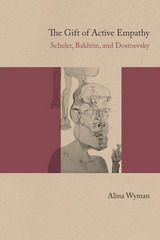 The Gift of Active Empathy: Scheler, Bakhtin, and Dostoevsky
Alina Wyman
Northwestern University Press, 2016 This innovative study brings the early writings of Mikhail Bakhtin into conversation with Max Scheler and Fyodor Dostoevsky to explore the question of what makes emotional co-experiencing ethically and spiritually productive. In Problems of Dostoevsky's Poetics, Bakhtin's well-known concept of the dialogical partner expresses what he sees as the potential of human relationships in Dostoevsky's work. But his earlier reflections on the ethical and aesthetic uses of empathy, in part inspired by Scheler's philosophy, suggest a still more fundamental form of communication that operates as a basis for human togetherness in Dostoevsky. Applying this rich and previously neglected theoretical apparatus in a literary analysis, Wyman examines the obstacles to active empathy in Dostoevsky's fictional world, considers the limitations and excesses of empathy, addresses the problem of frustrated love in The Idiot and Notes from Underground, and provides a fresh interpretation of two of Dostoevsky's most iconic characters, Prince Myshkin and Alyosha Karamazov.
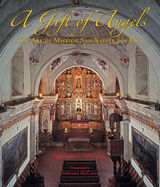 A Gift of Angels: The Art of Mission San Xavier del Bac
Bernard L. Fontana; photographs by Edward McCain
University of Arizona Press, 2010 It rises suddenly out of the Sonoran Desert landscape, towering over the tallest tree or cactus, a commanding building with a sensuous dome, elliptical vaults, and sturdy bell towers. There is nothing else like it around, nor does it seem there should be. This incongruity of setting is what strikes first-time visitors to Mission San Xavier del Bac. This great church is of another place and another time, while its beauty is universal and timeless.
Mission San Xavier del Bac is a two-century-old Spanish church in southern Arizona located just a few miles from downtown Tucson, a metropolis of more than half a million people in the American Southwest. A National Historic Landmark since 1963, the mission’s graceful baroque art and architecture have drawn visitors from all over the world.
Now Bernard Fontana—the leading expert on San Xavier—and award-winning photographer Edward McCain team up to bring us a comprehensive view of the mission as we’ve never seen it before. With 200 stunning full-color photographs and incisive text illuminating the religious, historical, and motivational context of these images, A Gift of Angels is a must-have for tourists, scholars, and other visitors to San Xavier.
From its glorious architecture all the way down to the finest details of its art, Mission San Xavier del Bac is indeed a gift of angels.
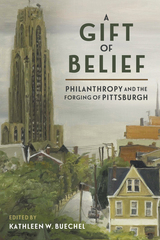 A Gift of Belief: Philanthropy and the Forging of Pittsburgh
Kathleen W. Buechel
University of Pittsburgh Press, 2021 Philanthropy has long been associated with images of industrial titans and wealthy families. In Pittsburgh, long a center for industry, the shadows of Carnegie, Mellon, Frick, and others loom especially large, while the stories of working-class citizens who uplifted their neighbors remain untold. For the first time, these two portraits of Pittsburgh philanthropy converge in a rich historic tapestry. The Gift of Belief reveals how Pittsburghers from every strata, creed, and circumstance organized their private resources for the public good. The industrialists and their foundations are here but stand alongside lesser known philanthropists equally involved in institution building, civic reform, and community empowerment.
Beginning with sectarian philanthropy in the nineteenth century, moving to scientific philanthropy in the early twentieth century and Pittsburgh Renaissance-era institution-building, and concluding with modern entrepreneurship, twelve authors trace how Pittsburgh aligned with, led, or lagged behind the national philanthropic story and explore how ideals of charity and philanthropy entwined to produce distinctive forms of engagement that has defined Pittsburgh’s civic life.
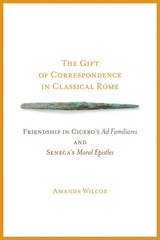 The Gift of Correspondence in Classical Rome: Friendship in Cicero's Ad Familiares and Seneca's Moral Epistles
Amanda Wilcox
University of Wisconsin Press, 2012 Amanda Wilcox offers an innovative approach to two major collections of Roman letters—Cicero’s Ad Familiares and Seneca’s Moral Epistles—informed by modern cross-cultural theories of gift-giving.
By viewing letters and the practice of correspondence as a species of gift exchange, Wilcox provides a nuanced analysis of neglected and misunderstood aspects of Roman epistolary rhetoric and the social dynamics of friendship in Cicero’s correspondence. Turning to Seneca, she shows that he both inherited and reacted against Cicero’s euphemistic rhetoric and social practices, and she analyzes how Seneca transformed the rhetoric of his own letters from an instrument of social negotiation into an idiom for ethical philosophy and self-reflection. Though Cicero and Seneca are often viewed as a study in contrasts, Wilcox extensively compares their letters, underscoring Cicero’s significant influence on Seneca as a prose stylist, philosopher, and public figure.
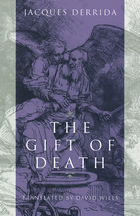 The Gift of Death
Jacques Derrida
University of Chicago Press, 1995 In The Gift of Death, Jacques Derrida's most sustained consideration of religion to date, he continues to explore questions introduced in Given Time about the limits of the rational and responsible that one reaches in granting or accepting death, whether by sacrifice, murder, execution, or suicide. Derrida analyzes Patocka's Heretical Essays on the History of Philosophy and develops and compares his ideas to the works of Heidegger, Levinas, and Kierkegaard.
A major work, The Gift of Death resonates with much of Derrida's earlier writing and will be of interest to scholars in anthropology, philosophy, and literary criticism, along with scholars of ethics and religion.
"The Gift of Death is Derrida's long-awaited deconstruction of the foundations of the project of a philosophical ethics, and it will long be regarded as one of the most significant of his many writings."—Choice
"An important contribution to the critical study of ethics that commends itself to philosophers, social scientists, scholars of relgion . . . [and those] made curious by the controversy that so often attends Derrida."—Booklist
"Derrida stares death in the face in this dense but rewarding inquiry. . . . Provocative."—Publishers Weekly
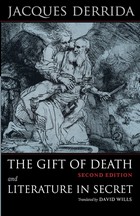 The Gift of Death, Second Edition & Literature in Secret
Jacques Derrida
University of Chicago Press, 2008
The Gift of Death, Jacques Derrida’s most sustained consideration of religion, explores questions first introduced in his book Given Time about the limits of the rational and responsible that one reaches in granting or accepting death, whether by sacrifice, murder, execution, or suicide. Derrida analyzes Czech philosopher Jan Patocka’s Heretical Essays in the Philosophy of History and develops and compares his ideas to the works of Heidegger, Lévinas, and Kierkegaard. One of Derrida’s major works, The Gift of Death resonates with much of his earlier writing, and this highly anticipated second edition is greatly enhanced by David Wills’s updated translation.
This new edition also features the first-ever English translation of Derrida’s Literature in Secret. In it, Derrida continues his discussion of the sacrifice of Isaac, which leads to bracing meditations on secrecy, forgiveness, literature, and democracy. He also offers a reading of Kafka’s Letter to His Father and uses the story of the flood in Genesis as an embarkation point for a consideration of divine sovereignty.
“An important contribution to the critical study of ethics that commends itself to philosophers, social scientists, scholars of religion . . . [and those] made curious by the controversy that so often attends Derrida.”—Booklist, on the first edition
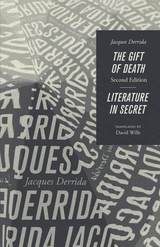 The Gift of Death, Second Edition & Literature in Secret
Jacques Derrida
University of Chicago Press, 2008 The Gift of Death, Jacques Derrida’s most sustained consideration of religion, explores questions first introduced in his book Given Time about the limits of the rational and responsible that one reaches in granting or accepting death, whether by sacrifice, murder, execution, or suicide. Derrida analyzes Czech philosopher Jan Patocka’s Heretical Essays in the Philosophy of History and develops and compares his ideas to the works of Heidegger, Lévinas, and Kierkegaard. One of Derrida’s major works, The Gift of Death resonates with much of his earlier writing, and this highly anticipated second edition is greatly enhanced by David Wills’s updated translation. This new edition also features the first-ever English translation of Derrida’s Literature in Secret. In it, Derrida continues his discussion of the sacrifice of Isaac, which leads to bracing meditations on secrecy, forgiveness, literature, and democracy. He also offers a reading of Kafka’s Letter to His Father and uses the story of the flood in Genesis as an embarkation point for a consideration of divine sovereignty. “An important contribution to the critical study of ethics that commends itself to philosophers, social scientists, scholars of religion . . . [and those] made curious by the controversy that so often attends Derrida.”—Booklist, on the first edition
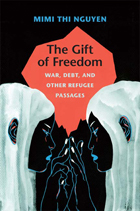 The Gift of Freedom: War, Debt, and Other Refugee Passages
Mimi Thi Nguyen
Duke University Press, 2012 In The Gift of Freedom, Mimi Thi Nguyen develops a new understanding of contemporary United States empire and its self-interested claims to provide for others the advantage of human freedom. Bringing together critiques of liberalism with postcolonial approaches to the modern cartography of progress, Nguyen proposes "the gift of freedom" as the name for those forces that avow to reverence aliveness and beauty, and to govern an enlightened humanity, while producing new subjects and actions—such as a grateful refugee, or enduring war—in an age of liberal empire. From the Cold War to the global war on terror, the United States simultaneously promises the gift of freedom through war and violence and administers the debt that follows. Focusing here on the figure of the Vietnamese refugee as the twice-over target of the gift of freedom—first through war, second through refuge—Nguyen suggests that the imposition of debt precludes the subjects of freedom from escaping those colonial histories that deemed them "unfree." To receive the gift of freedom then is to be indebted to empire, perhaps without end.
 A Gift of Madrigals and Motets
Edited by H. Colin Slim
University of Chicago Press, 1972 Near the end of the third decade of the sixteenth century, a five-volume set of madrigal and motet partbooks was assembled in Florence and sent as a gift—or "musical embassy"—to the English court of Henry VIII. The manuscript set—minus the missing altus part—has been owned since 1935 by the Newberry Library in Chicago; but until H. Colin Slim's exhaustive efforts, no thorough study of the history or contents of the partbooks had been undertaken.
At first encounter, these partbooks yield no clues concerning their provenance, their composers' names, or the reasons for their dispatch to England. In his search for this information, Professor Slim used the musicologists' customary tools, namely, biobibliography, concordances, and textual and musical analysis. But he also used bibliographers' tools not always employed by musicologists: watermarks, bindings, script, orthography, and illuminations.
As a result of his efforts, the author was able to identify nearly all the works' composers and the manuscripts' expert illuminator. He also presents a detailed description of the binding process and the probably background of the scribe, places the political and social references in the works, and determines the route the volumes may have taken after they left Henry's library.
By placing the date of the partbooks' arrival in England around 1528, Professor Slim suggests that the musical culture of the early Tudor court was less French than has hitherto been thought. Indeed, the presence of the partbooks in Henry's library makes them the earliest evidence of the Italian madrigal in England. The author also provides new and significant data on the artistic and historical position of Philippe Verdelot, the partbooks' most extensively represented composer.
Volume I of this set contains two parts. The first, dealing with the manuscript itself, contains the history of the partbooks, information on their origin, composers, texts, and their importance as a gift to Henry VIII. Part II, dealing with the music, discusses general musical traits, the motets, the madrigals, the results of collation, and the appearance of some of the Newberry motets and madrigals in other sources.
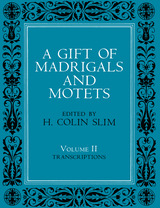 A Gift of Madrigals and Motets, Volume 2: Transcription
Edited by H. Colin Slim
University of Chicago Press, 1972 Near the end of the third decade of the sixteenth century, a five-volume set of madrigal and motet partbooks was assembled in Florence and sent as a gift—or "musical embassy"—to the English court of Henry VIII. The manuscript set—minus the missing altus part—has been owned since 1935 by the Newberry Library in Chicago; but until H. Colin Slim's exhaustive efforts, no thorough study of the history or contents of the partbooks had been undertaken.
At first encounter, these partbooks yield no clues concerning their provenance, their composers' names, or the reasons for their dispatch to England. In his search for this information, Professor Slim used the musicologists' customary tools, namely, biobibliography, concordances, and textual and musical analysis. But he also used bibliographers' tools not always employed by musicologists: watermarks, bindings, script, orthography, and illuminations.
As a result of his efforts, the author was able to identify nearly all the works' composers and the manuscripts' expert illuminator. He also presents a detailed description of the binding process and the probably background of the scribe, places the political and social references in the works, and determines the route the volumes may have taken after they left Henry's library.
By placing the date of the partbooks' arrival in England around 1528, Professor Slim suggests that the musical culture of the early Tudor court was less French than has hitherto been thought. Indeed, the presence of the partbooks in Henry's library makes them the earliest evidence of the Italian madrigal in England. The author also provides new and significant data on the artistic and historical position of Philippe Verdelot, the partbooks' most extensively represented composer.
In Volume II, Professor Slim has transcribed the music of the thirty motets and thirty madrigals for modern performance. The parts are cantus, tenor, bassus, and quintus et VI; the altus partbook is missing. Concordant sources provide the altus parts for all but four of the motets and six of the madrigals. These ten have been composed by Professor Slim. Notes at the end of each selection provide variant readings for both music and text. The Latin texts of the motets, the Italian of the madrigals, and an English translation of each appear at the end of the volume.
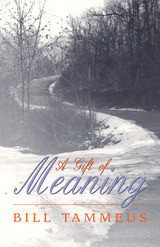 A Gift of Meaning
Bill Tammeus
University of Missouri Press, 2001 Because of the peculiar momentary nature of journalism, not every column can stand the test of time. But many—even those about events nearly gone from the public consciousness--contain lasting truths. A Gift of Meaning is a collection of those lasting truths from Bill Tammeus, a columnist for the Kansas City Star. Each piece reveals Tammeus's attempt to wrestle eternal meaning from the events and experiences that sweep us along day by day. I stopped by a homeless shelter the other day to see someone I know. As I waited, I felt rather conspicuous in my suit and tie. In fact, the friendly man at the information desk asked me if I was a pastor. I chuckled. But as I sat in the lobby waiting to see the man I came to check on, I was struck again by what may be the most difficult of all human tasks: empathy. That is, the challenge of really putting ourselves in the shoes of others. In the end, A Gift of Meaning is not just a presentation of found meaning, but also a call to readers to stop and think for themselves. This book is an invitation to breathe deeply and seek out the meaning of what the world heaves at us each day. It is an offering of insights that will provide fresh ways of comprehending things readers thought they already understood.
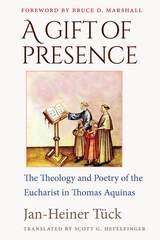 A Gift of Presence: The Theology and Poetry of the Eucharist in Thomas Aquinas
Jan Heiner Tück
Catholic University of America Press, 2018 Jan-Heiner Tück presents a work that explores the sacramental theology, lived spirituality, and Eucharistic poetry of the Church’s doctor communis, St. Thomas Aquinas. Although Aquinas’ Eucharistic poetry has long occupied an important place in the Church’s liturgical prayer and her repertoire of sacred music, the depth of these poems remains hidden until one grasps the rich sacramental theology underlying it. Consequently, Tück first offers a detailed but approachable primer of Aquinas’ theology of the sacraments, before diving deeply into the Angelic Doctor’s theology and poetry of the Eucharist. The Scriptural accounts stand at the heart of the systematic framework developed by Aquinas, and thus significant attention is devoted to showing the harmony between the accounts of Christ’s passion and the detailed exposition of the Summa theologiae. Moreover, the Eucharistic controversies of the ninth and eleventh centuries provide the contrapuntal context in which Aquinas did his thinking, praying, and writing. Not surprisingly, therefore, the response he crafts to these controversies draws upon both speculative powers and contemplative prayer, brought together in the unity of Aquinas’ theology and spirituality. The net result is a twofold treasure for the Church: a careful systematic presentation of Eucharistic theology and the lived devotional expression of the same in the carefully constructed—and now much beloved—stanzas of Pange lingua gloriosi, Lauda Sion, Adoro te devote, etc. By revealing the lively interplay of the saint’s powerful speculative intellect and a heart steeped in love for the Eucharistic Lord, Tück offers a sophisticated exposition of Aquinas’ Eucharistic poetry and the roots it sinks into a wider theological framework. Finally, the contemporary significance and power of Aquinas’ work is drawn out, not only in the rarefied realm of intellectual inquiry but also in the everyday expanse of ordinary life.
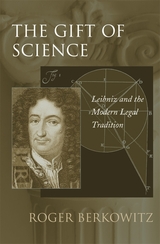 The Gift of Science: Leibniz and the Modern Legal Tradition
Roger Berkowitz
Harvard University Press, 2005 The front pages of our newspapers and the lead stories on the evening news bear witness to the divorce of law from justice. The rich and famous get away with murder; Fortune 500 corporations operate sweatshops with impunity; blue-chip energy companies that spoil the environment and sicken communities face mere fines that don't dent profits. In The Gift of Science, a bold, revisionist account of 300 years of jurisprudence, Roger Berkowitz looks beyond these headlines to explore the historical and philosophical roots of our current legal and ethical crisis.
Moving from the scientific revolution to the nineteenth-century rise of legal codes, Berkowitz tells the story of how lawyers and philosophers invented legal science to preserve law's claim to moral authority. The "gift" of science, however, proved bittersweet. Instead of strengthening the bond between law and justice, the subordination of law to science transformed law from an ethical order into a tool for social and economic ends. Drawing on major figures from the traditions of law, philosophy, and history, The Gift of Science is not only a mesmerizing and original intellectual history of law; it shows how modern law remains imprisoned by a failed scientific metaphysics.
The Gift of the Unicorn: Essays on Writing
Percival Hunt
University of Pittsburgh Press, 1965
The ability to write well is difficult to gain. To write beyond the ordinary—beyond the clear and effective paragraph or book—needs craft, patience, and practice. And it has always required something more: genius, magic, a supreme gift. Professor Hunt in The Gift of the Unicorn binds the two—the craft and the gift—under a unifying light, showing both writer and reader the how and why and perhaps of good writing and of the writing that has gained, in Hunt’s words, “the friendship of time” and is called literature.
Essays include: “Beginning,” “The Web of Writing,” “The Telling,” “Spontaneity,” “Disciplined Writing,” “The Story,” “The People in the Book,” “Of Rules, Again,” and “Ending.”
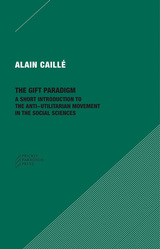 The Gift Paradigm: A Short Introduction to the Anti-Utilitarian Movement in the Social Sciences
Alain Caillé
Prickly Paradigm Press, 2020 In his classic essay The Gift, Marcel Mauss argued that gifts can never be truly free; rather, they bring about an expectation of reciprocal exchange. For over one hundred years, his ideas on economy, social relations, and exchange have inspired new modes of thought, none more so than what crystallized in the 1980s around an innovative group of French academics. In TheGift Paradigm, Alain Caillé provides the first in-depth, English-language introduction to La Revue du MAUSS—or, “Anti-Utilitarian Movement in the Social Sciences,” combining the work of anthropologists, sociologists, philosophers, and others. Today, the very idea of a “general social science” seems unthinkable, unless you count the pervasive sway of a utilitarian logic in orthodox economics, or the diffuse influence of neoliberalism. Here, Caillé offers a distinctly different reading of economy and society, inspired by Mauss—as vital now as ever.
The Gift That Arrives Broken
Jacqueline Berger
Autumn House Press, 2010 Winner of the 2009 Autumn House Poetry Contest, selected by Alicia Ostriker. In Berger's third collection, she combines the philosophical with the everyday in order to examine a broken world.
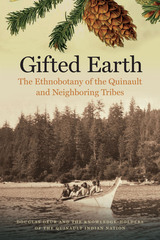 Gifted Earth: The Ethnobotany of the Quinault and Neighboring Tribes
Douglas Deur
Oregon State University Press, 2022 Published in cooperation with the Quinault Indian Nation
Gifted Earth features traditional Native American plant knowledge, detailing the use of plants for food, medicines, and materials. It presents a rich and living tradition of plant use within the Quinault Indian Nation in a volume collaboratively developed and endorsed by that tribe.
The Quinault Reservation on the Olympic Peninsula of Washington state is a diverse tribal community, embodying the traditional knowledge of tribes along the entire Pacific Northwest coast. Its membership consists of descendants of many tribes—from the northwestern Olympic Peninsula to the northern Oregon coast—including the Quinault, but also many others who were relocated to the reservation in the nineteenth and early twentieth centuries. Individuals descended from these tribal communities, including Chinook, Chehalis, Hoh, Quileute, Queets, Cowlitz, Tillamook, Clatsop, and others, have contributed to Gifted Earth, giving it remarkable breadth and representation.
A celebration of enduring Native American knowledge, this book will help non-specialists as they discover the potential of the region’s wild plants, learning how to identify, gather, and use many of the plants that they encounter in the Northwestern landscape. Part ethnobotanical guide and part “how-to” manual, Gifted Earth also prepares plant users for the minor hazards and pitfalls that accompany their quest—from how to avoid accidentally eating a bug hidden within a salal berry to how to prevent blisters when peeling the tender stalks of cow parsnip.
As beautiful as it is informative, Gifted Earth sets the standard for a new generation of ethnobotanical guides informed by the values, vision, and voice of Native American communities eager to promote a sustainable, balanced relationship between plant users and the rich plant communities of traditional tribal lands.
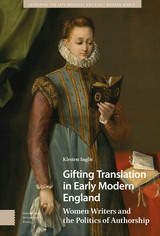 Gifting Translation in Early Modern England: Women Writers and the Politics of Authorship
Kirsten Inglis
Amsterdam University Press, 2023 Translation was a critical mode of discourse for early modern writers. Gifting Translation in Early Modern England: Women Writers and the Politics of Authorship examines the intersection of translation and the culture of gift-giving in early modern England, arguing that this intersection allowed women to subvert dominant modes of discourse through acts of linguistic and inter-semiotic translation and conventions of gifting. The book considers four early modern translators: Mary Bassett, Jane Lumley, Jane Seager, and Esther Inglis. These women negotiate the rhetorics of translation and gift-culture in order to articulate political and religious affiliations and beliefs in their carefully crafted manuscript gift-books. This book offers a critical lens through which to read early modern translations in relation to the materiality of early modern gift culture.
Gifts and Commodities
C. A. Gregory
HAU, 2015 Christopher A. Gregory’s Gifts and Commodities is one of the undisputed classics of economic anthropology. On its publication in 1982, it spurred intense, ongoing debates about gifts and gifting, value, exchange, and the place of political economy in anthropology. Gifts and Commodities is, at once, a critique of neoclassical economics and development theory, a critical history of colonial Papua New Guinea, and a comparative ethnography of exchange in Melanesian societies. This new edition includes a foreword by anthropologist Marilyn Strathern and a new preface by the author that discusses the ongoing response to the book and the debates it has engendered, debates that have become more salient in our evermore neoliberal and globalized era.
|
|


